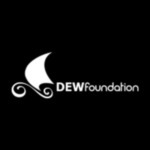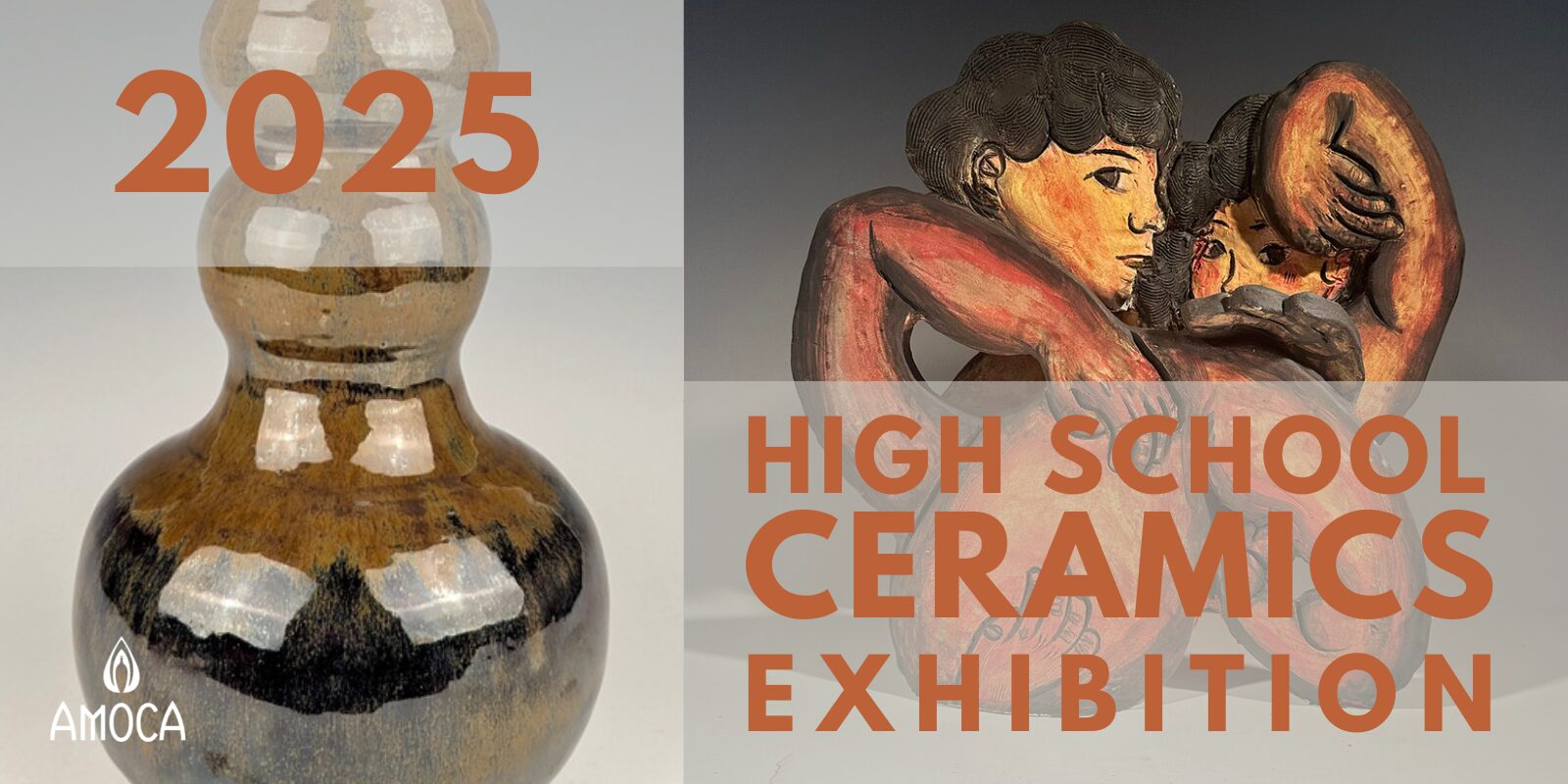
Introduction
Since 2014, AMOCA has hosted an annual juried exhibition showcasing the remarkable talents of high school students studying the ceramic arts. Starting in 2020, the exhibition has been virtual. Nearly 450 pieces were submitted for the 2025 exhibition, and 52 were selected by Museum staff through a collective jury process.
To learn more about the program and view past exhibitions, visit the link below.
Teen Council
With support from the Ruth and Joseph C. Reed Foundation for the Arts, AMOCA hosts an internship and professional development group for high school students. Students receive access to exclusive museum areas and events, develop their college resume, meet professional artists, and receive complimentary access to the AMOCA Ceramics Studio. Council membership is free thanks to grant funding.
To learn more and apply to join the program, visit the link below.
Exhibition Acknowledgments
This program generously funded provided, in part, through grants from Ruth and Joseph C. Reed Foundation for the Arts and the DEW Foundation.
Exhibition Awards Ceremony
On Saturday May 17, 2025 at 10am, AMOCA premiered a pre-recorded awards ceremony that included a presentation of the entire virtual exhibition.
Exhibition Award Winners
9th & 10th Grade
Best of Show: Charlotte Mount
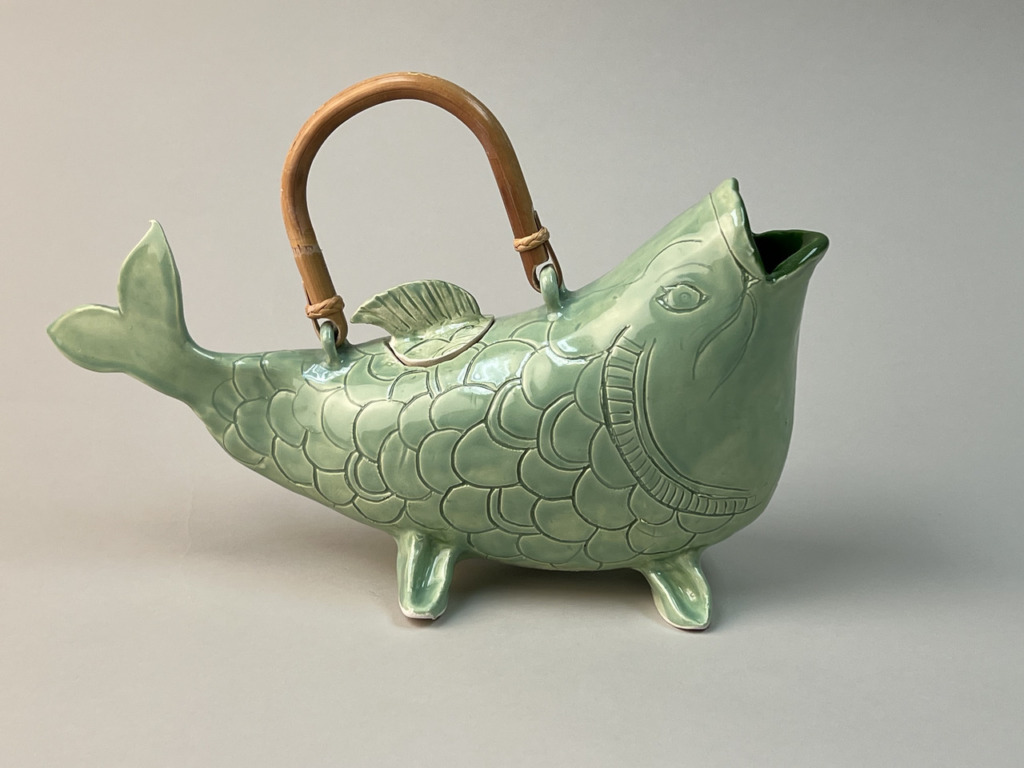
Charlotte Mount, Koi Ocha, 2024. White stoneware, Celadon glaze, Bamboo handle. 9” x 12” x 6.” Holton Arms School, MD.
Honorable Mention: Ashley Chan-Mott
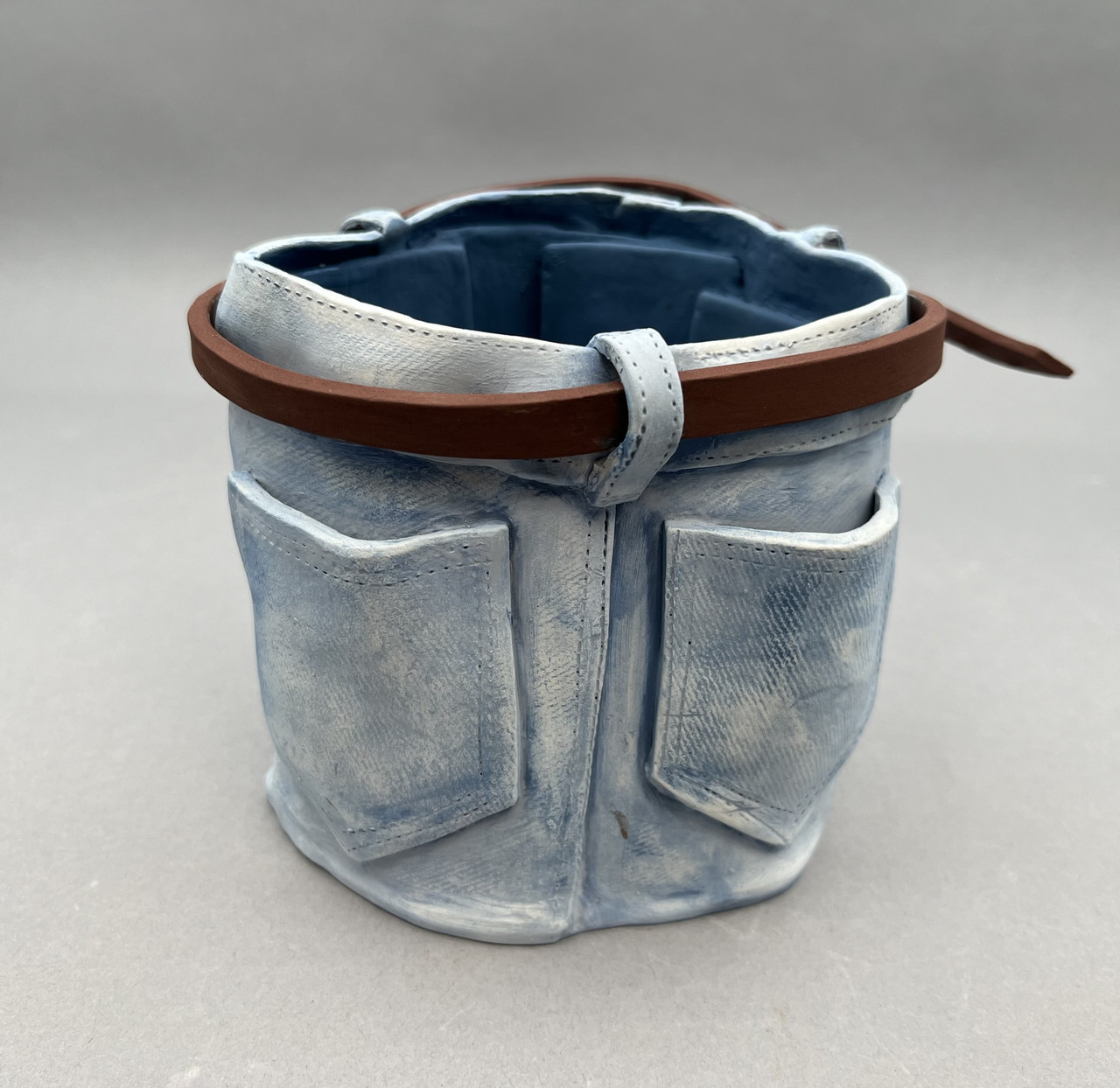
Ashley Chan-Mott, Worn In, 2024. Earthenware clay, Underglaze, Luster. 4.5″ x 7.5″ x 4.5.” Chadwick School, CA.
Honorable Mention: Conrad Chern
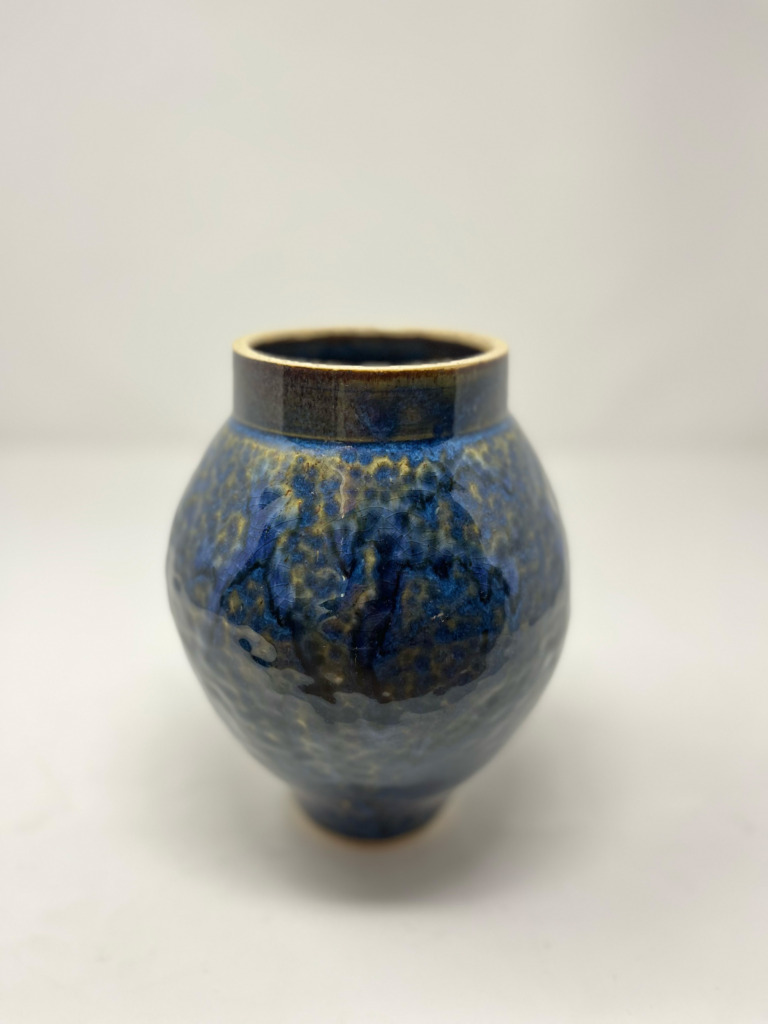
Conrad Chern, Panning for Gold, 2025. Wheel thrown, Clay fired to Cone 6. 7.5″ x 6″ x 6.” Crystal Springs Uplands School, CA.
Honorable Mention: Hazel Garrison
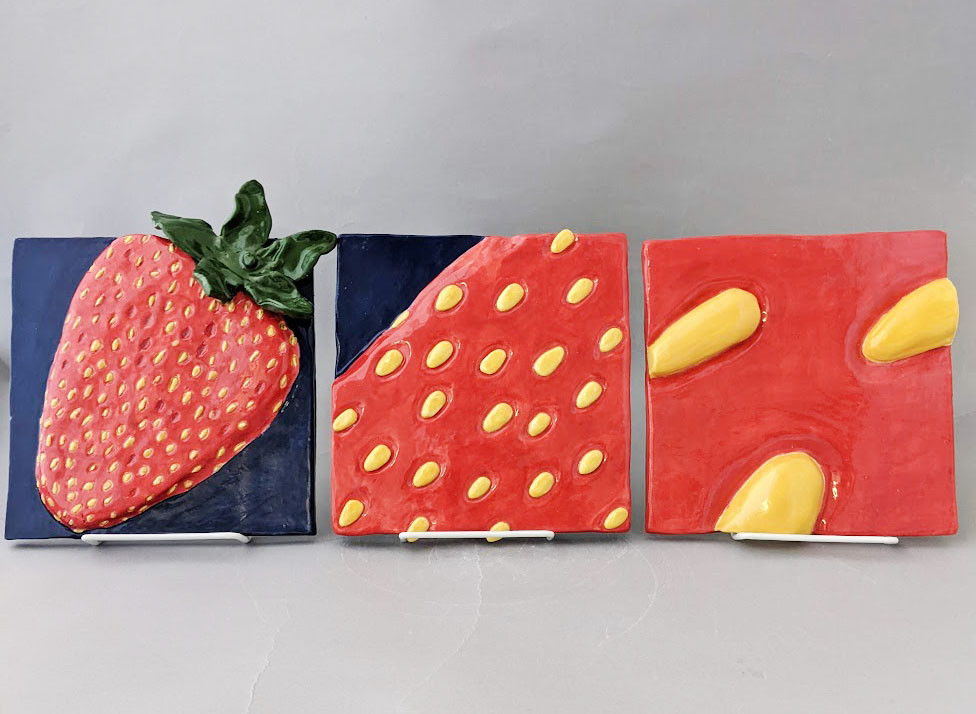
Hazel Garrison, Berry in Tiles, 2024. Ceramic, Glaze, Bamboo handle. 9″ x 22.25″ x 2.25.” Breck School, MN.
11th Grade
Best of Show: Axel Weeks
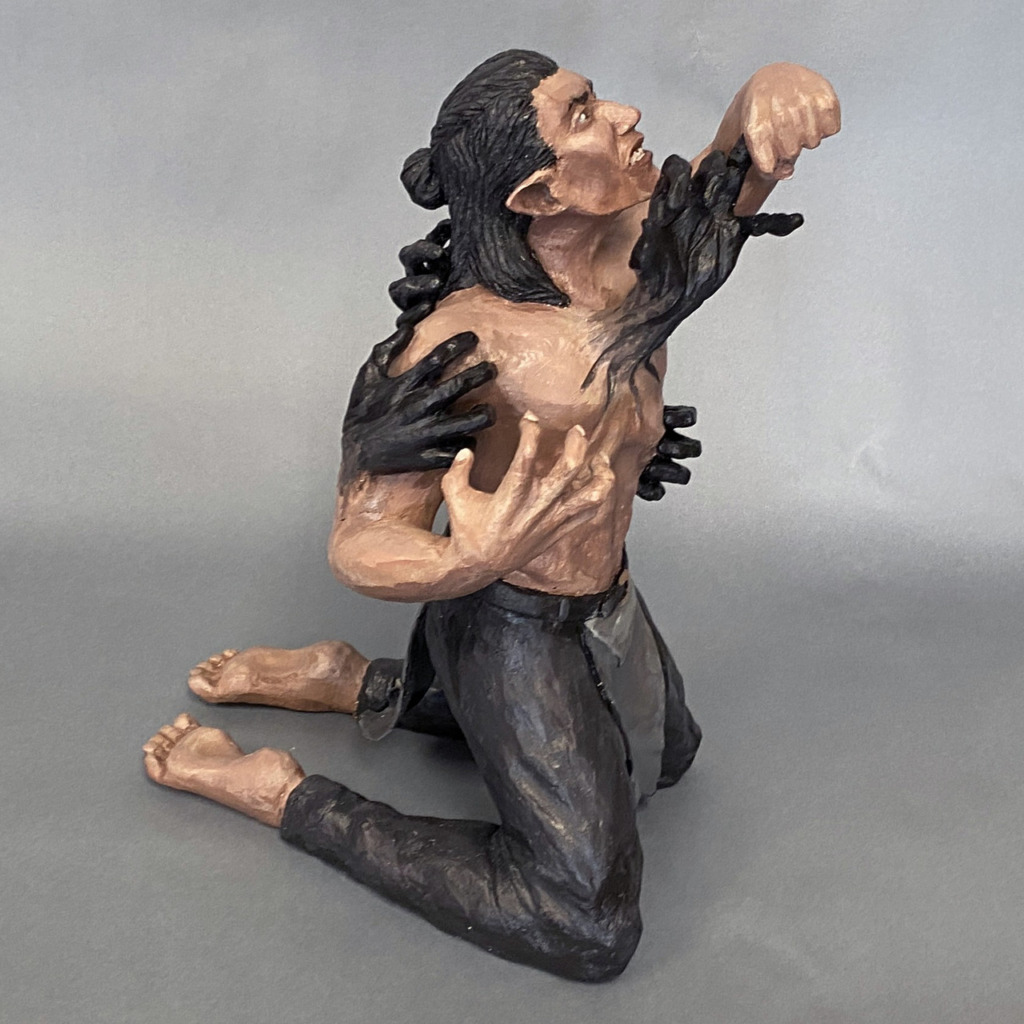
Ava (Axel) Weeks, III of Swords, 2025. Clay, Acrylic. 10” x 7” x 16.” Liberty High School, OR.
Honorable Mention: Katelyn Stoffregen
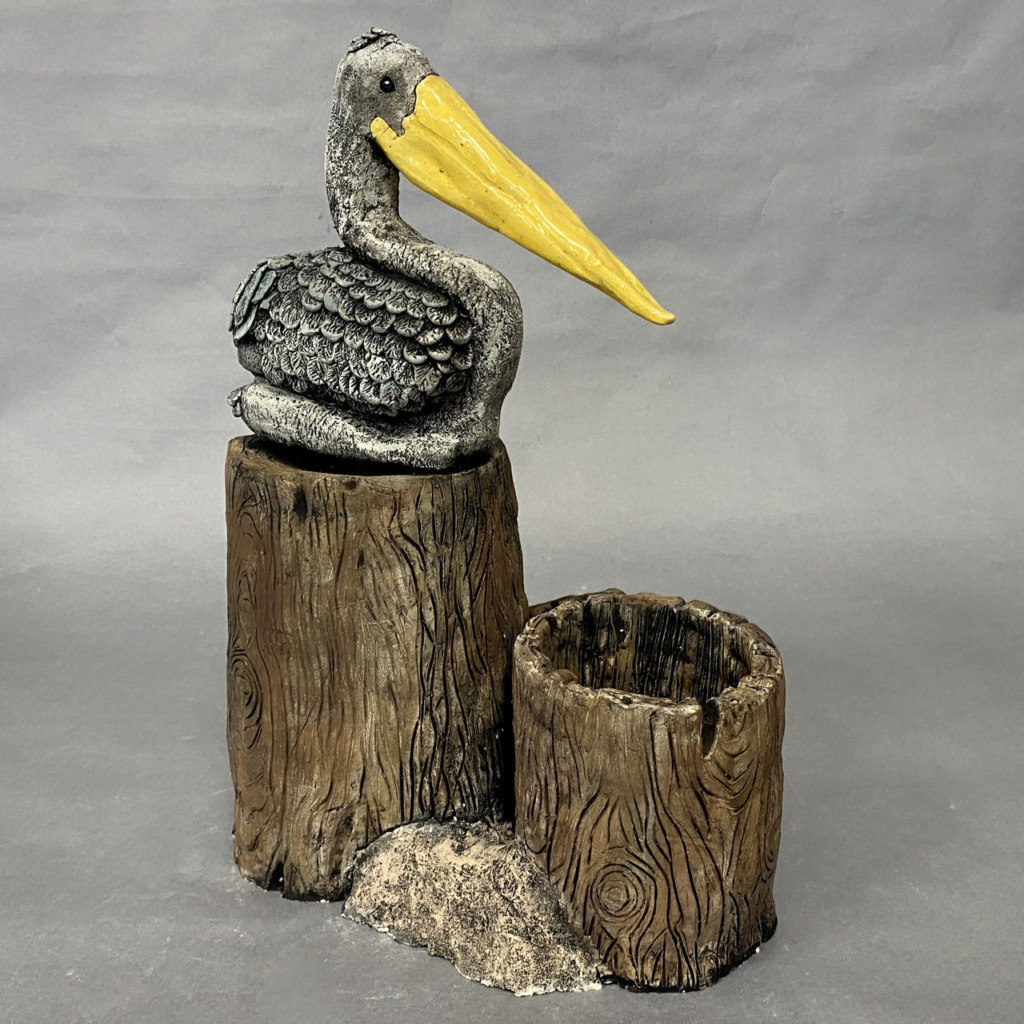
Katelyn Stoffregen, The Pelican, 2025. Ceramic, stain, glazes. 15” x 10” x 9.” Liberty High School, OR.
Honorable Mention: Fengyuan Yu
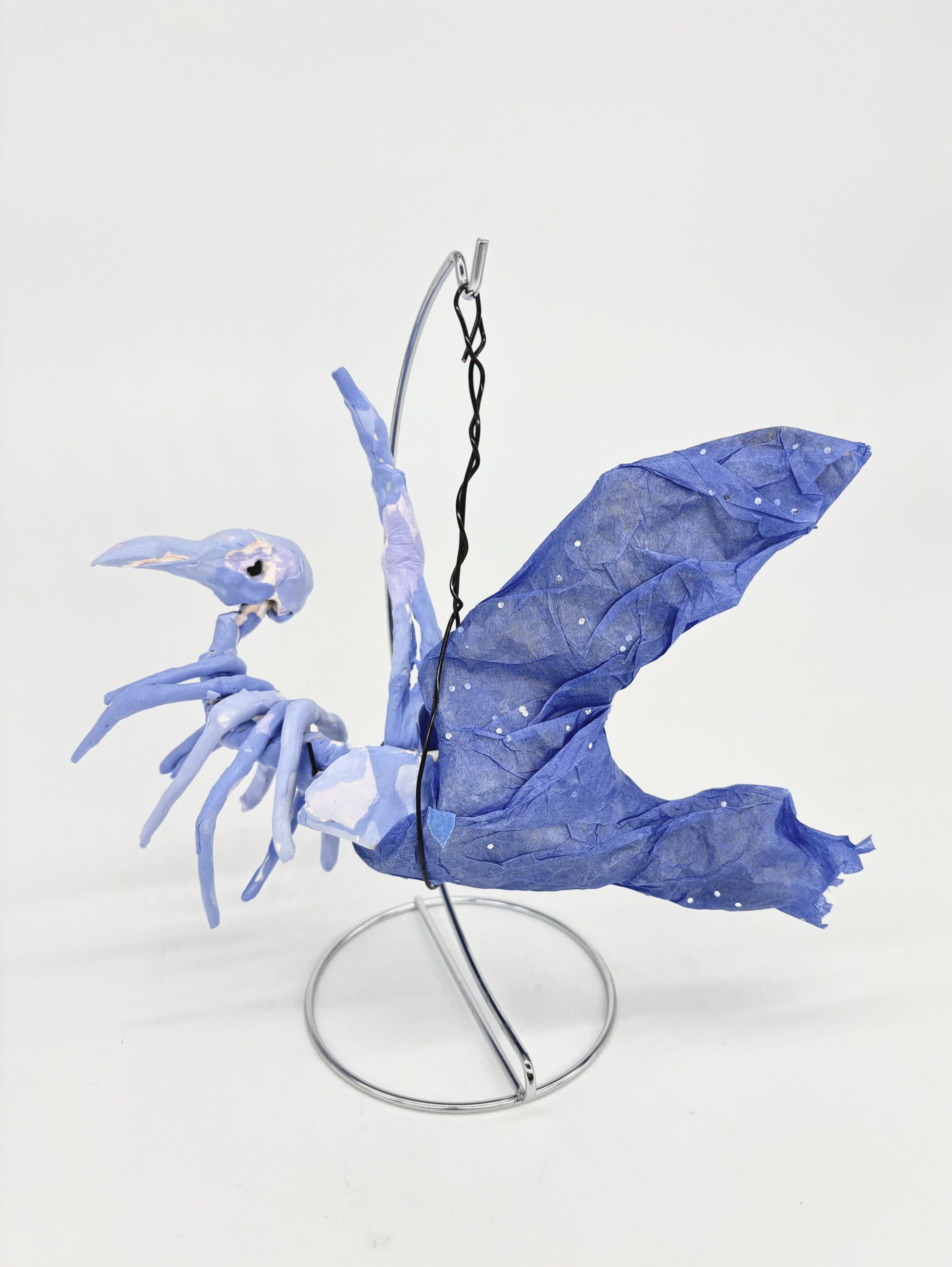
Fengyuan Yu, Change is the Extinction of Life, 2025. Ceramic, wire, sulfuric acid paper, light clay. 7.8” x 7.5” x 6.” Lake Washington High School, WA.
Honorable Mention: Thao Yun
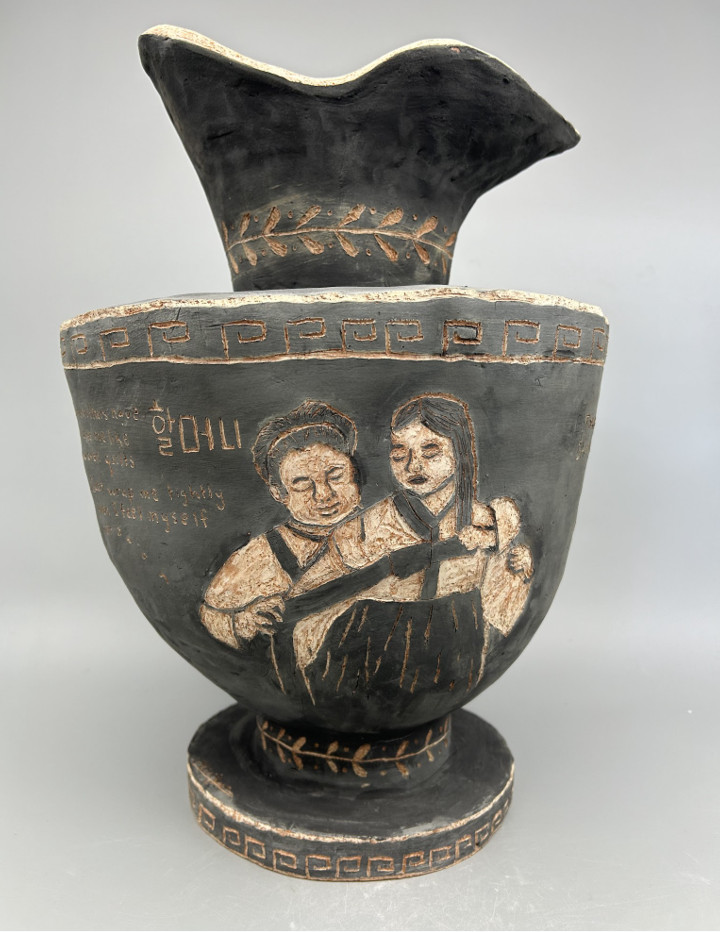
Thao Yun, Grandmothers, 2024. Terra Cotta Clay, Black Underglaze. 16.5” x 12” x 12.” Francis Parker School, CA.
12th Grade
Best of Show: Alexandra Liu
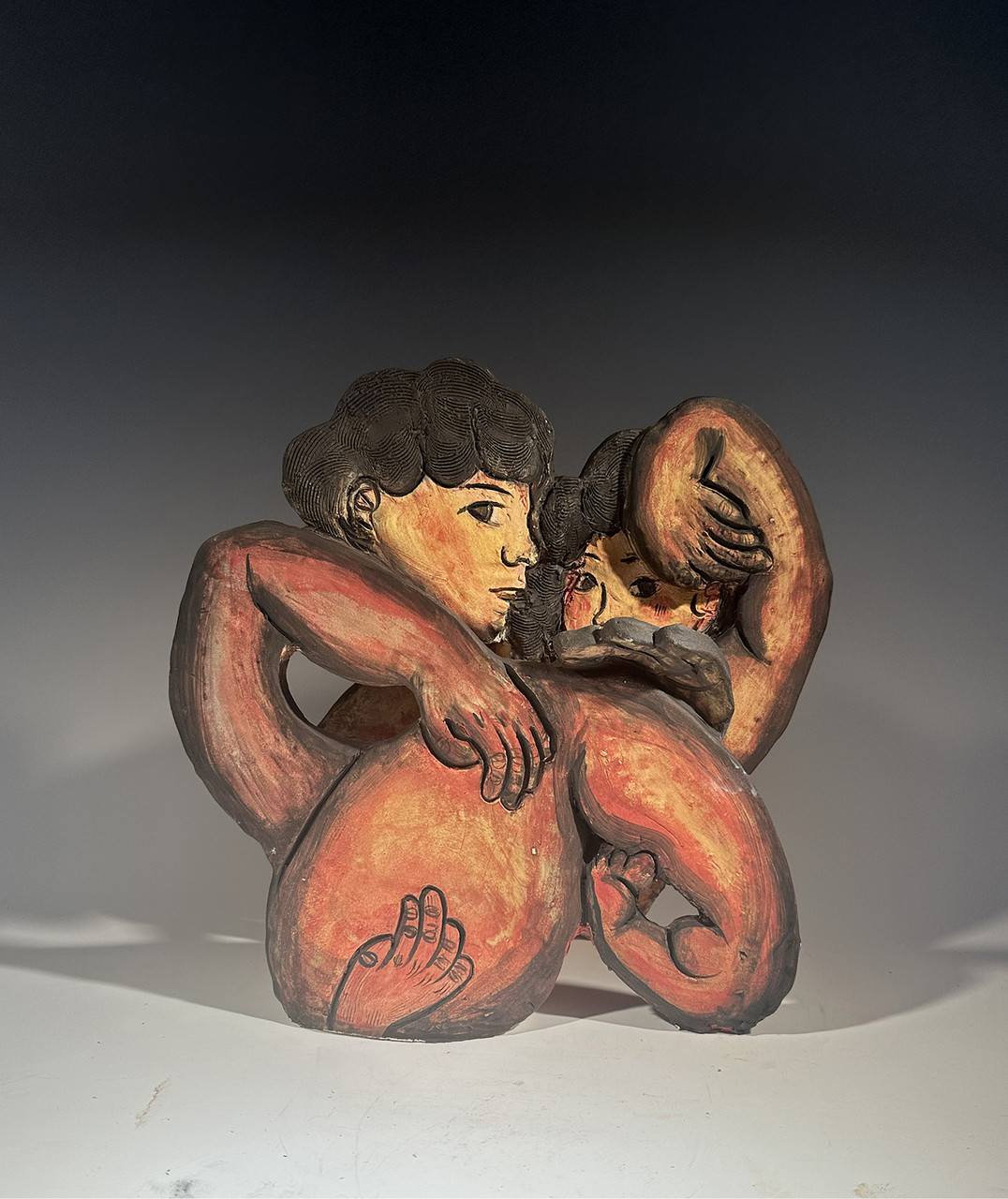
Alexandra Liu, Internal Conversation, 2024. Hopkin’s white clay, underglaze. 14.5” x 15” x 6.” Harvard-Westlake School, CA.
Honorable Mention: Cara Mortimer
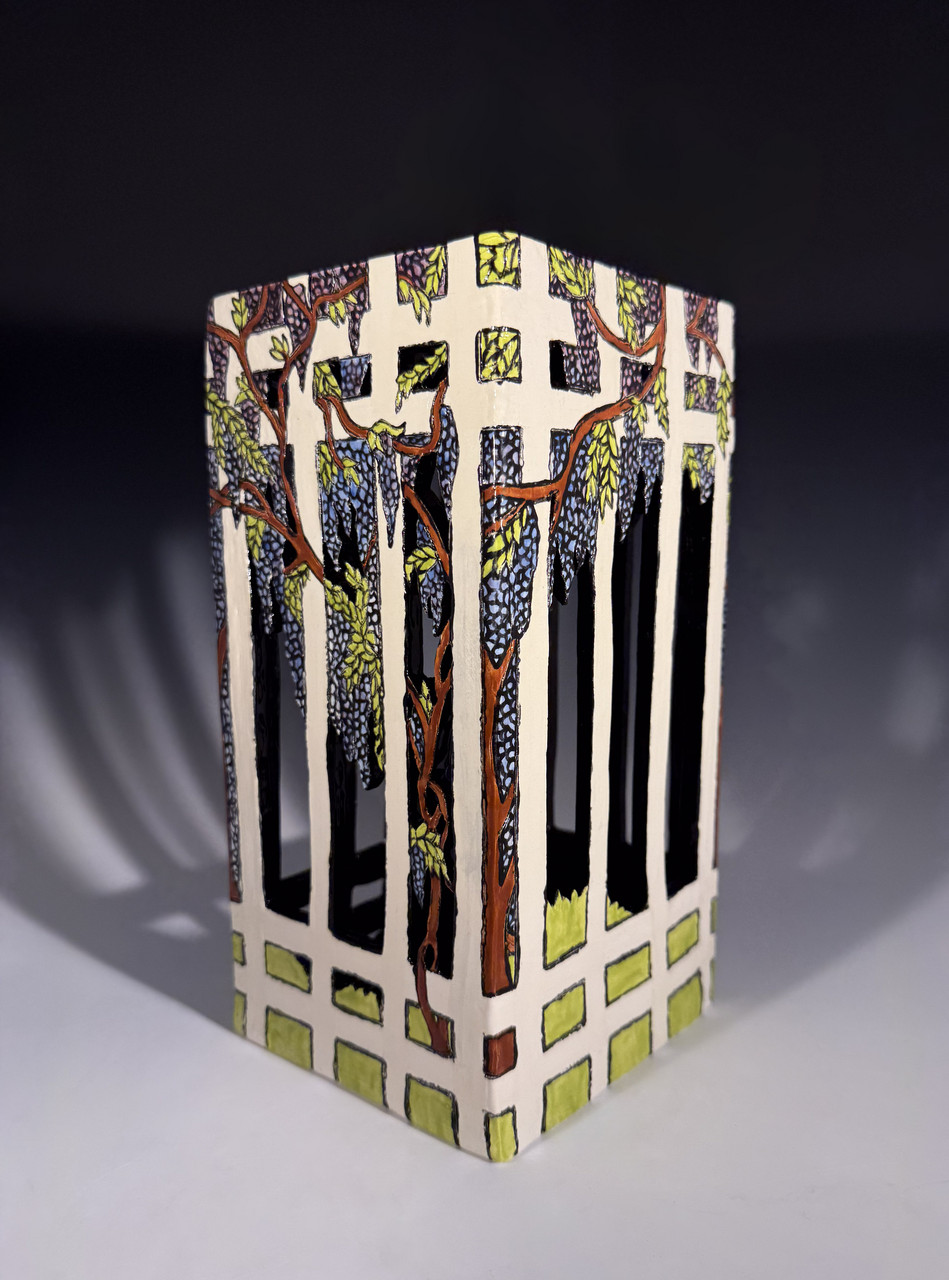
Cara Mortimer, Wisteria, 2025. Stoneware, underglaze. 5″ x 5.25″ x 8.25.” Trinity Preparatory School, FL.
Honorable Mention: Stefany Sedra
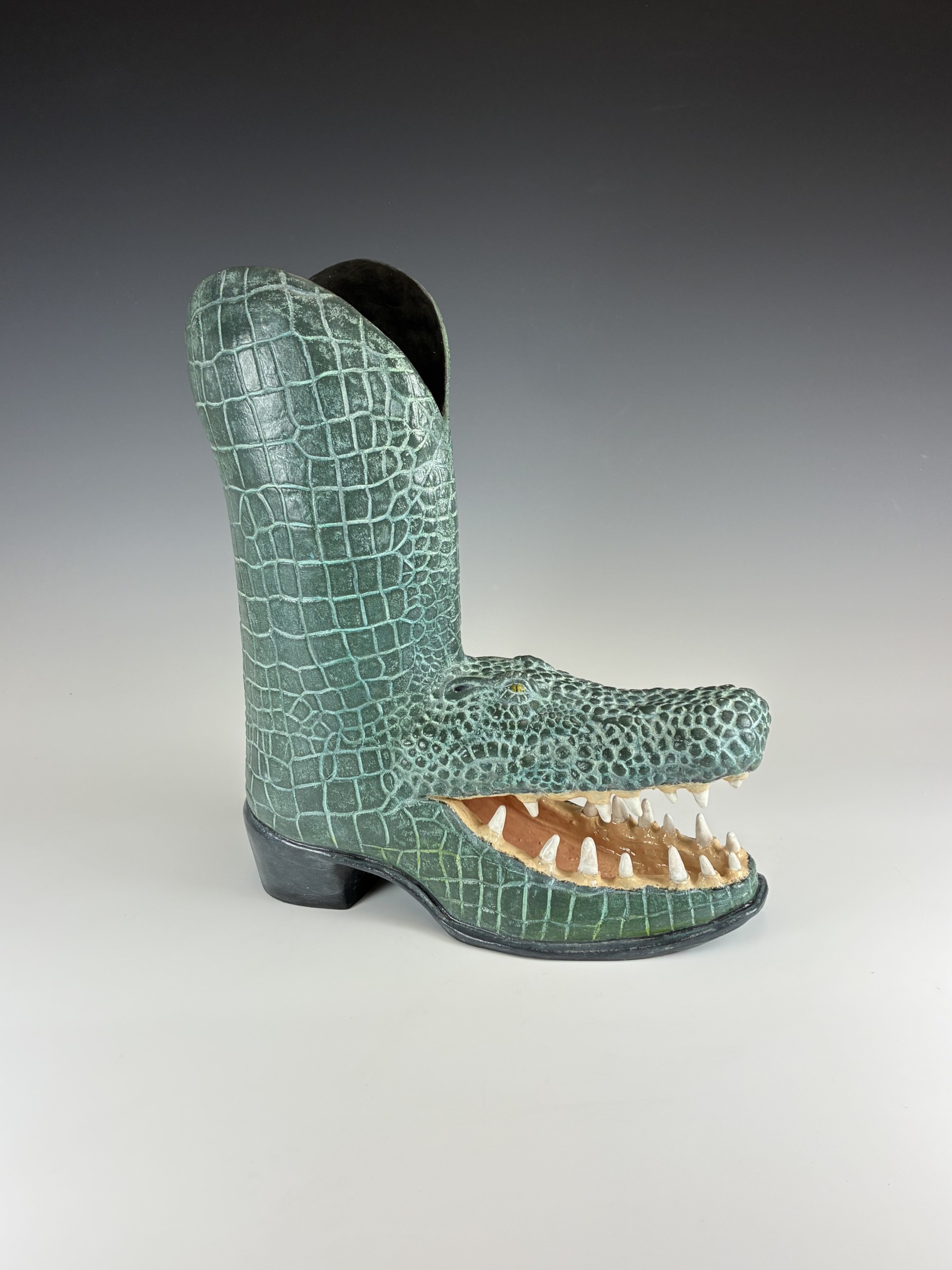
Stefany Sedra, CrocBoy Boot, 2025. Ceramic, glaze. 13” x 4” x 11.” El Toro High School, CA.
Honorable Mention: Yina Yoon
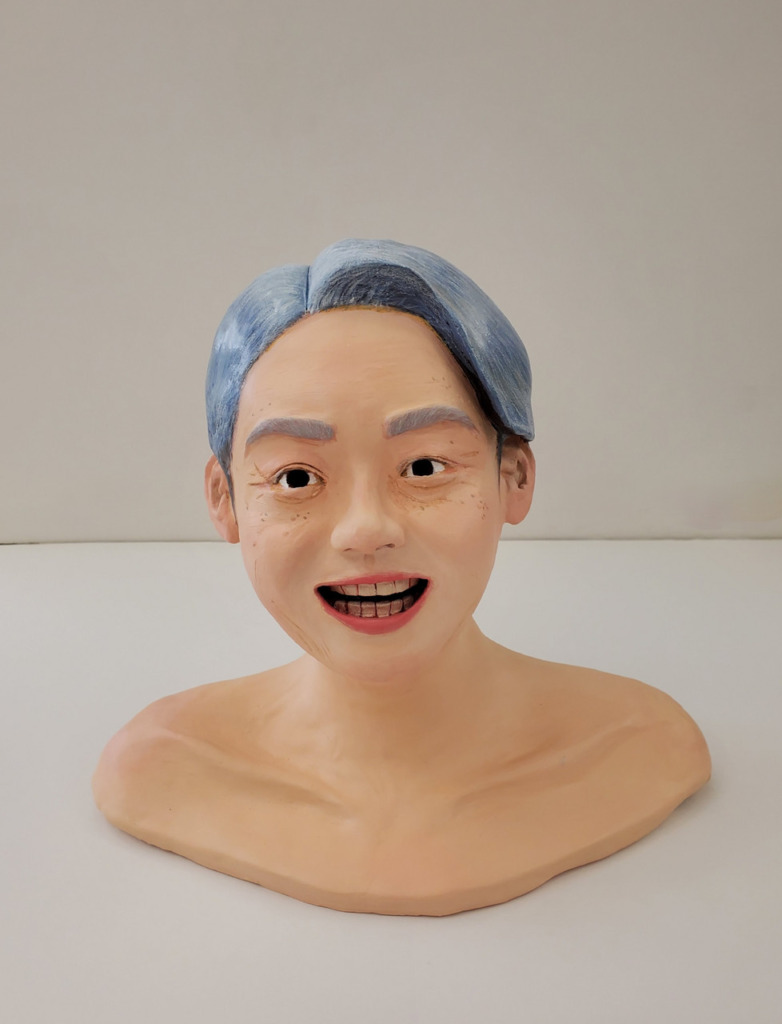
Yina Yoon, Halmeoni, 2025. BMix clay, Acrylic paints, Water, Color pencils, 11” x 12″ x 11.” Dublin High School, CA
Exhibition Works
Works are listed in alphabetical order by last name of the artist. Photos of works are submitted by participants. Click or tap on a photo to see a larger image.
9th & 10th Grade
Nandita Bangalore
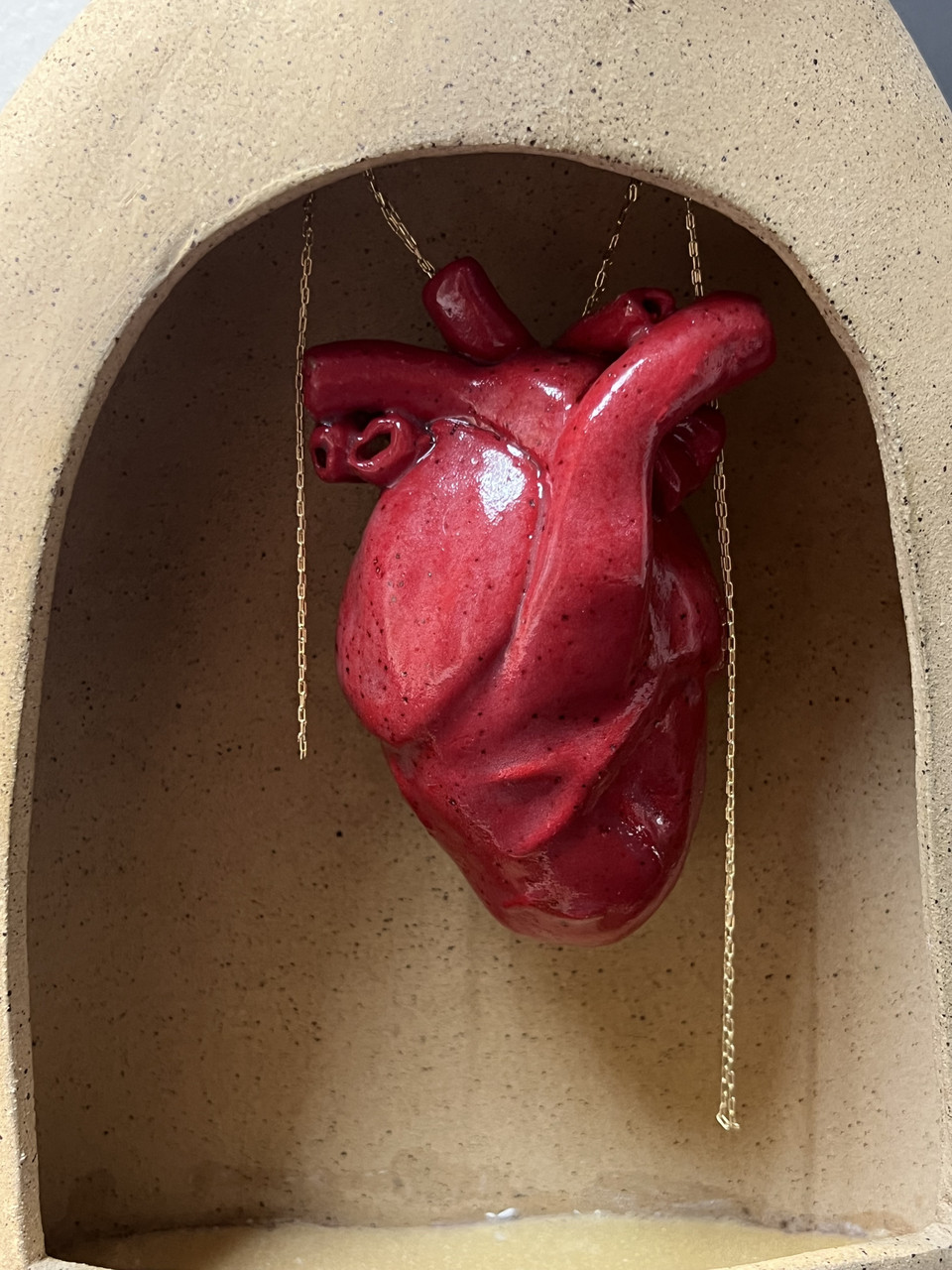
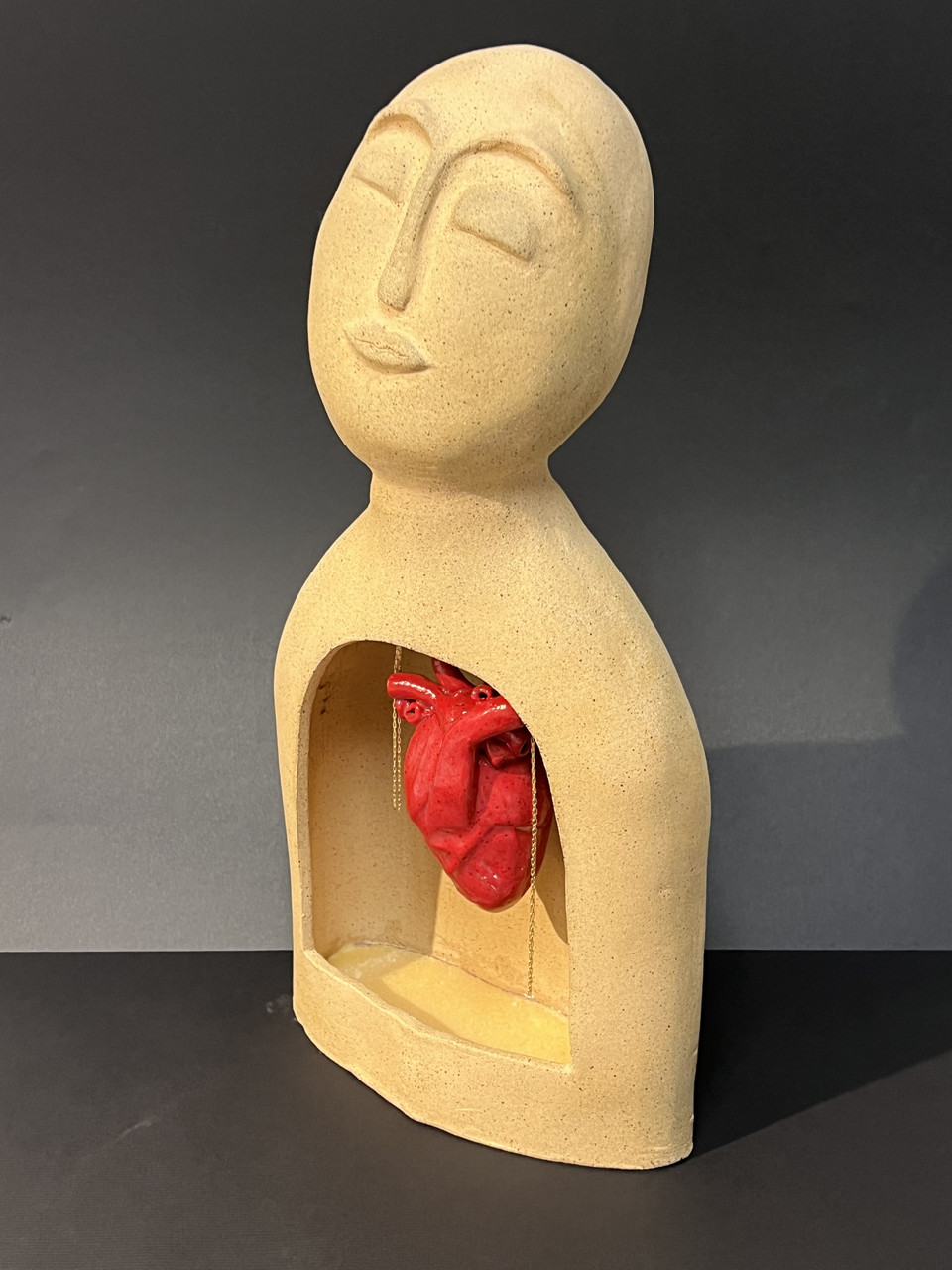
Nandita Bangalore, Healing Heart, 2025. Stoneware, metal chain, sponge, 16” x 8” x 2.” Holton-Arms School, MD.
Artist statement: I was influenced by an artist named Michele Fabbricatore. I have always wanted to be a doctor, and I used this piece to show my love for human anatomy by creating a realistic heart. I wanted the outside (the body and face) to be simple and calm, keep the heart bright and realistic, and show that even if you don’t feel real sometimes, your heart is always beating and your life is real and continuing.
Ashley Chan-Mott

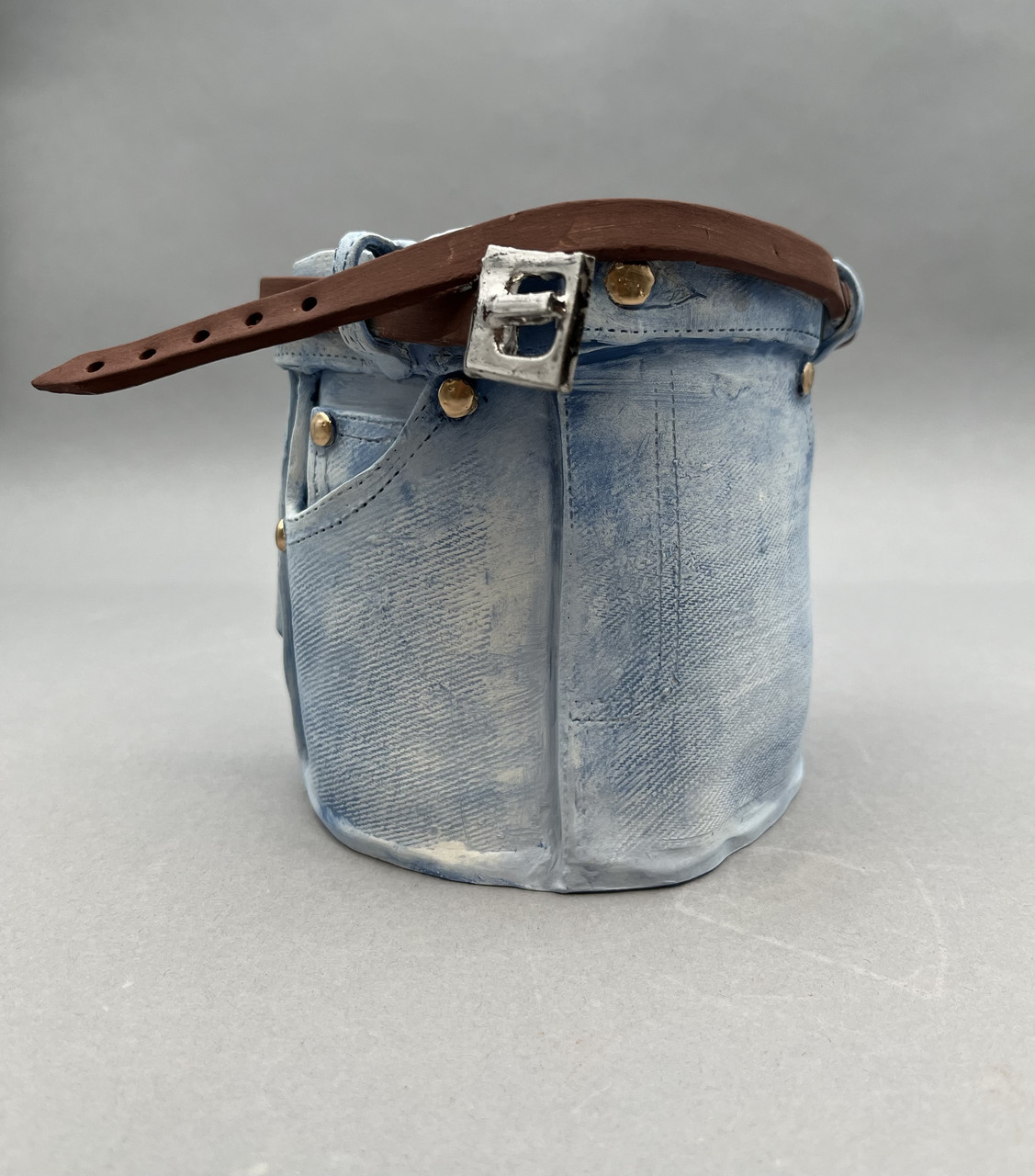
Ashley Chan-Mott, Worn In, 2024. Earthenware clay, Underglaze, Luster. 4.5″ x 7.5″ x 4.5.” Chadwick School, CA.
Artist Statement: “Worn In” is a sculptural cup I made to represent the overlap between the outward and inward embrace of femininity. To achieve a trompe l’oeil look, I used real denim to imprint the vessel, with the belt acting as a handle for my work. The rub-on-rub-off glazing method gives my skirt a worn-in, well-loved feeling. The skirt is often a symbol of femininity and has restricted women to fitting the ‘proper’ image. Through the casual look of my piece, I aim to show how femininity has been embraced in a way that reclaims power as a means of self-expression.
Conrad Chern
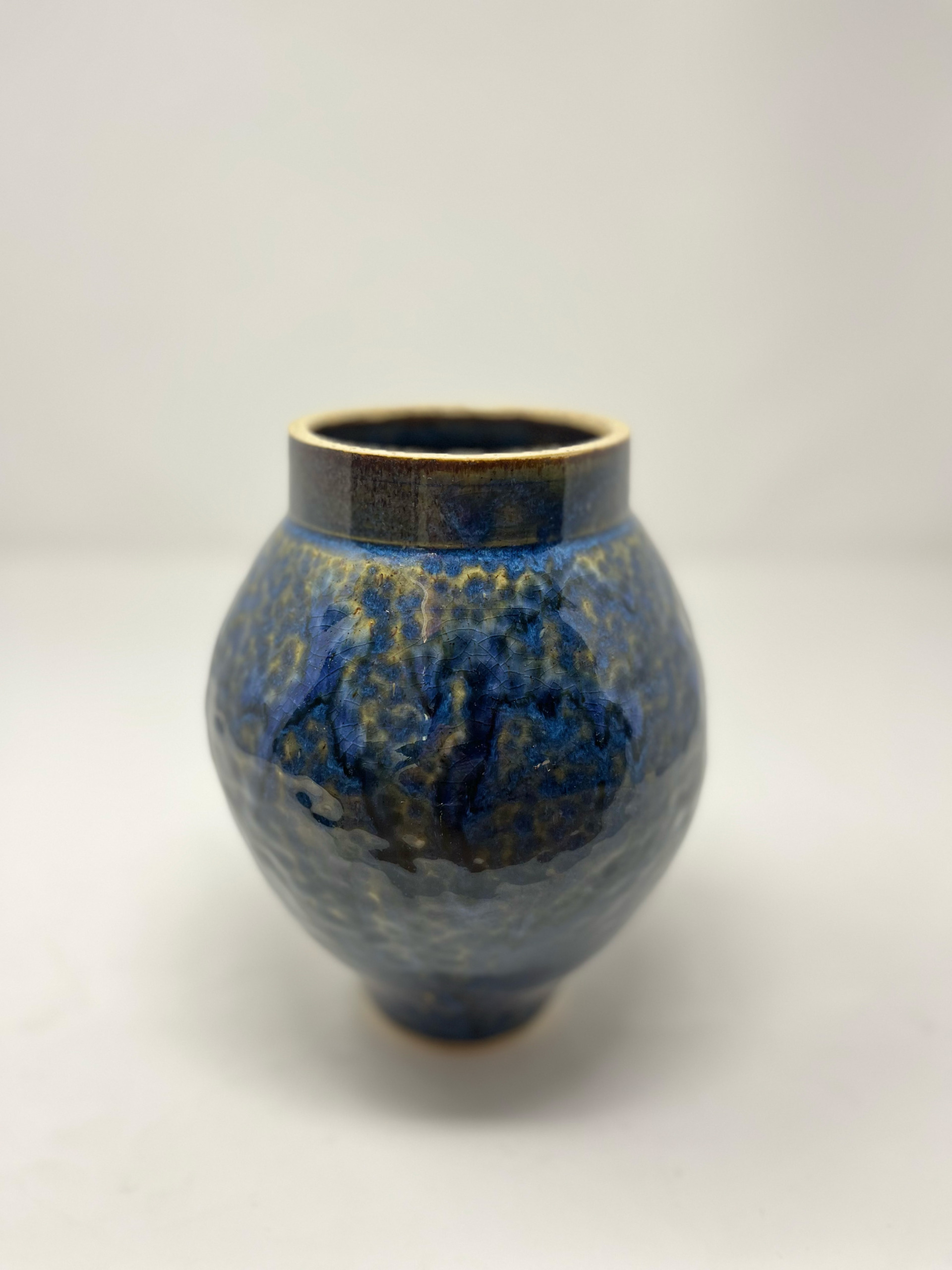
Conrad Chern, Panning for Gold, 2025. Wheel thrown, Clay fired to Cone 6. 7.5″ x 6″ x 6.” Crystal Springs Uplands School, CA.
Artist Statement: I used the circular end of my trimming tool to create texture on the main body of my pot. This not only allowed the glaze to interact with the surface texture but the texture also created a very satisfying sensation when picking up the artwork. In terms of glazing, I chose a deep blue that was rich in iron oxide because I heard if you put clear on top of a glaze with iron oxide, you get a very nice blend of colors with the glaze. After dipping the whole pot in a deep blue and gold base glaze, I chose to use a dropper and twist the pot while dropping the clear glaze to create a subtle spiral effect while maintaining verticality to accentuate the curves of the form. At the last minute, I decided to leave the rim bare to serve as a nice, raw distinction compared to the glassy, smooth finish of the glaze. In the end, this vase turned out way better than I envisioned, with the gold of the glaze serving as a nice juxtaposition of the deep and medium blue.
Anz Edmundson
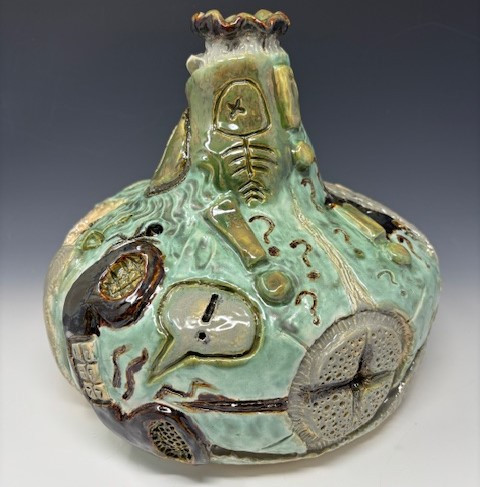
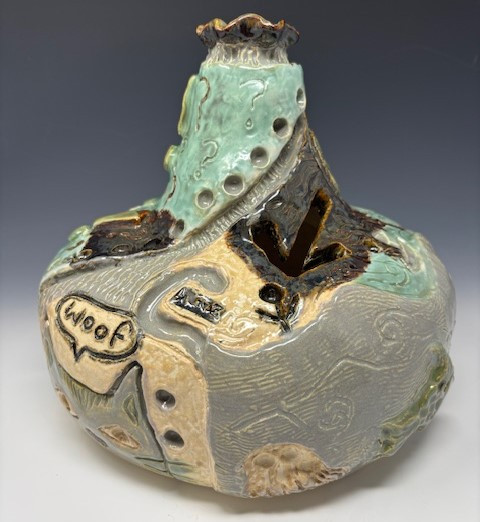
Anz Edmundson, Glyphs, 2024. Ice Man Clay, Potters Choice Glazes. 9.5” x 10.5″ x 10.5.” Belleville East High School, IL.
Artist Statement: Glyphs is a modern day interpretation of ancient hieroglyphics; I used doodles and graffiti to inspire the decoration. I used a coil building technique with a ruffled lip and added cut-outs and carved graffiti onto the surface. I wanted this pot to be interesting to look at while providing room for interpretation as to what the different signs and symbols mean. I used a variety of glazes in muted tones inspired by the comic character The Riddler, adding to the perplexing questions that might arise after viewing the piece.
Hazel Garrison

Hazel Garrison, Berry in Tiles, 2024. Ceramic, Glaze, Bamboo handle. 9″ x 22.25″ x 2.25.” Breck School, MN.
Artist Statement: I created my piece “Berry in Tiles” with clay and underglaze. I wanted vibrant and bright colors for this piece, so I made a strawberry. I sculpted the elements onto a leather hard slab and carved out the more intricate designs. The piece was then fired, and after that, I carefully glazed all the elements.
Kennedy Kornfield
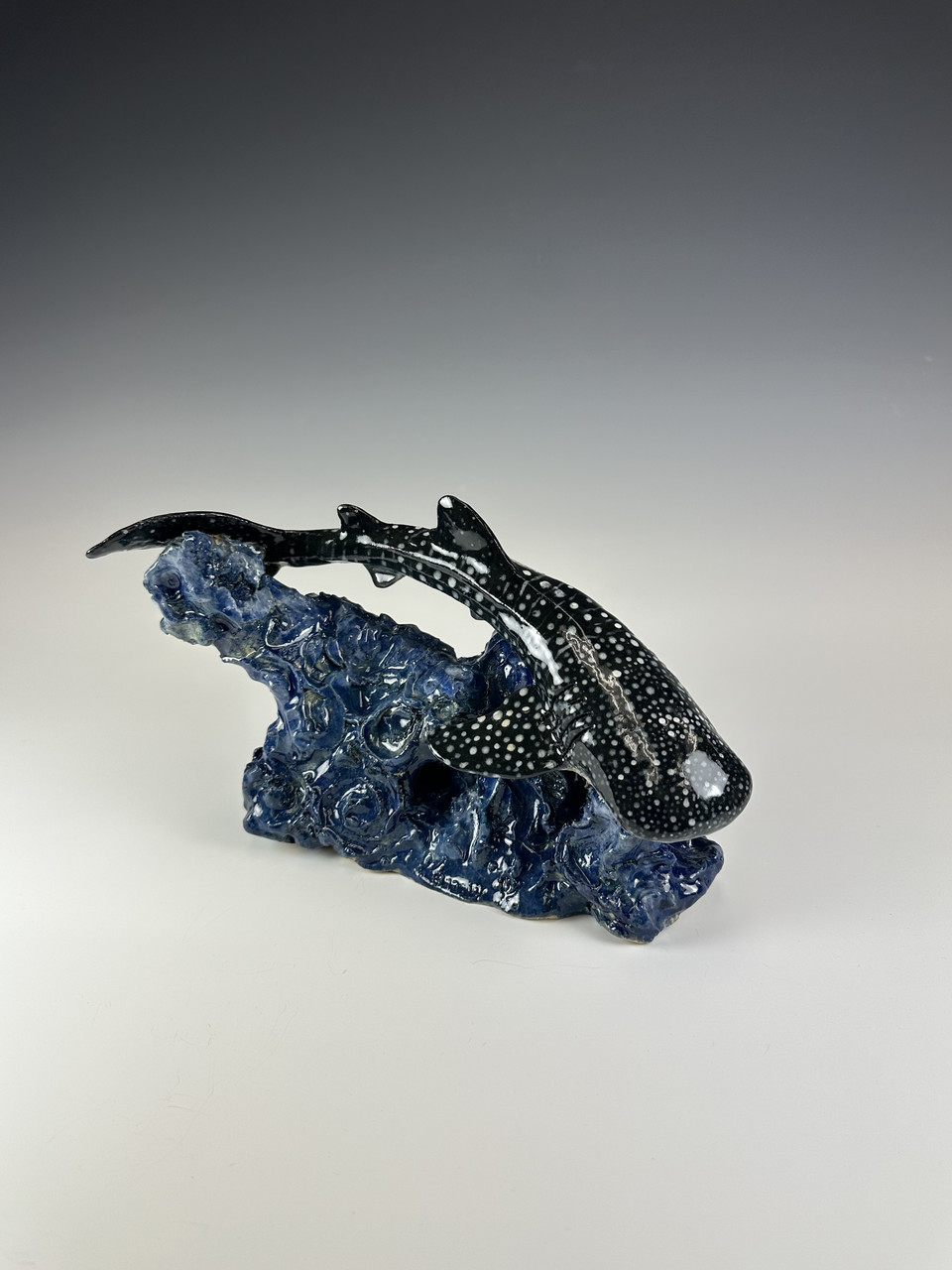
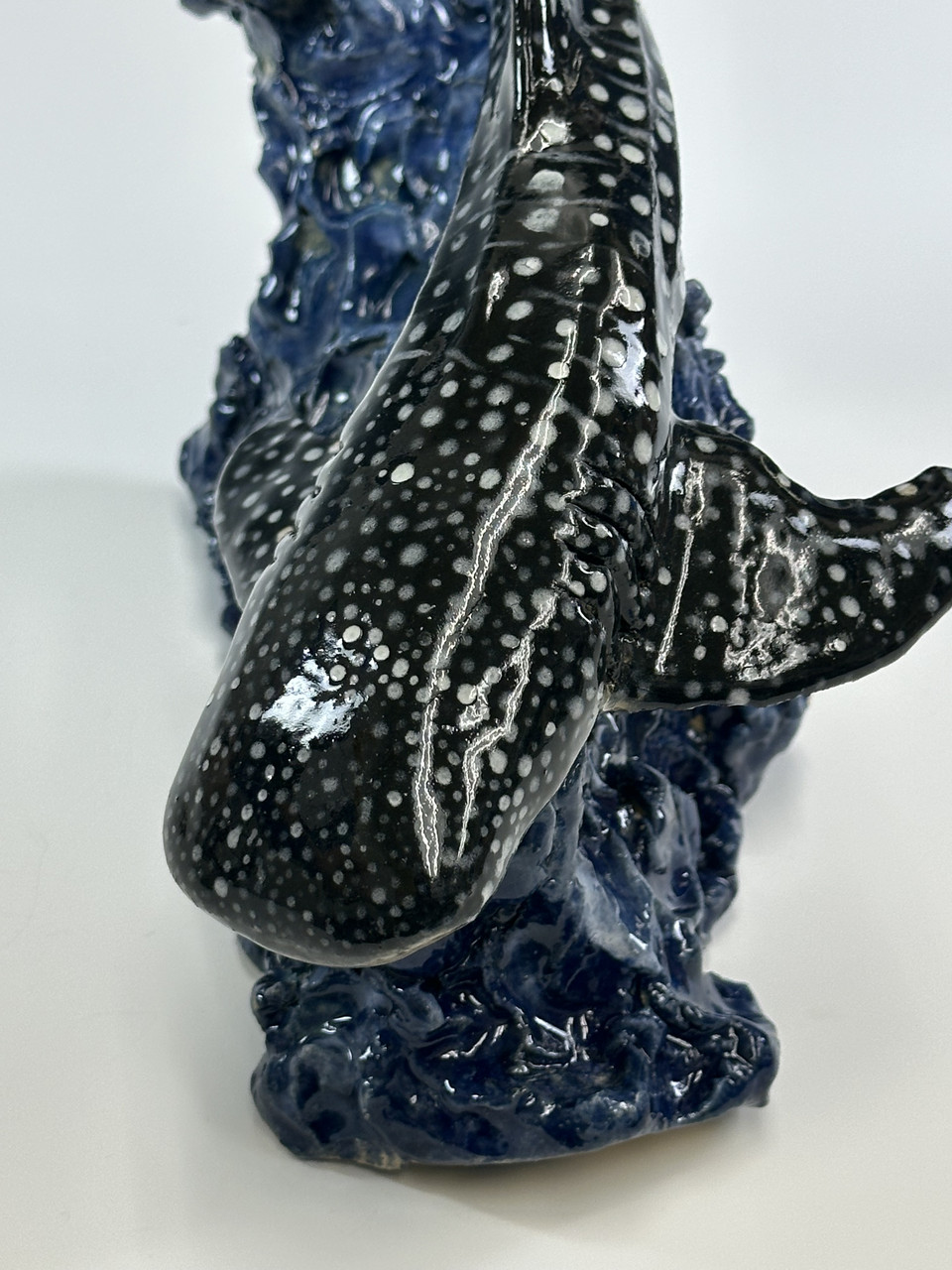
Kennedy Kornfield, Unwavering Whale Shark, 2025. Underglaze and Glaze, 11” x 6″ x 6.” El Toro High School, CA.
Artist Statement: I love whale sharks and anything marine life related!! It inspires me to follow my passion of marine biology and to become a diver and marine biologist. I find the ocean so mesmerizing, and my favorite part is the creatures that lay inside. For this work i used underglaze and clear glaze. My goal was to make the water look like there were white spots to emphasize it was the wave of the ocean and i also wanted to create swirls to add texture to the water.
Annie Lippard
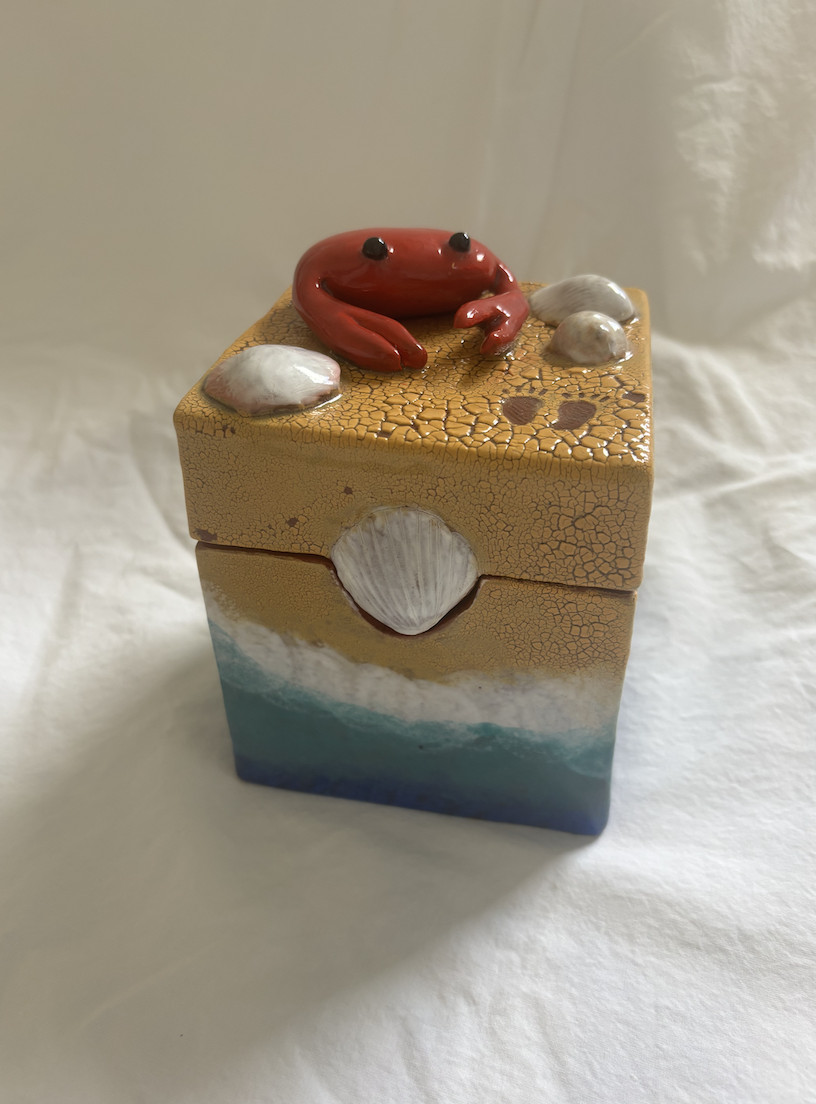

Annie Lippard, Tide’s Treasure, 2025. Terracotta, Slab built, painted with underglaze at the greenware stage, hand molded crab on top, shells on the top and sides, 5” x 4” x 4.” Holton-Arms School, MD.
Artist Statement: In creating this ocean-themed ceramics box, my vision was to reflect the beauty and fragility of the ocean while highlighting the urgent need for environmental care, especially in the face of global warming. I wanted to craft a piece that would evoke the serenity and majesty of the sea, but also provoke thought about its vulnerability due to human activity and climate change. While crafting this piece, I used simple techniques to make a box, showing that no matter how simple your impact is it can make a difference. I also decided to use terracotta clay because it can be easily covered by many different paints and glazes, but what is underneath does not change. This represents that although the effects of climate change towards wildlife may be covered up in the media, it still is there in its core. The color palette was carefully selected to reflect the natural hues of the ocean—from deep blues and greens to sandy beiges and bright reds—intended to evoke both the vibrancy and vulnerability of sea life. In developing this piece, I also explored the role of art in environmental activism. I believe art can spark important conversations and encourage viewers to consider the broader impact of their actions on the planet. Through this work, I hope to inspire a greater awareness of environmental responsibility, particularly in relation to the ocean, which is so crucial to sustaining life on Earth.
Charlotte Mount
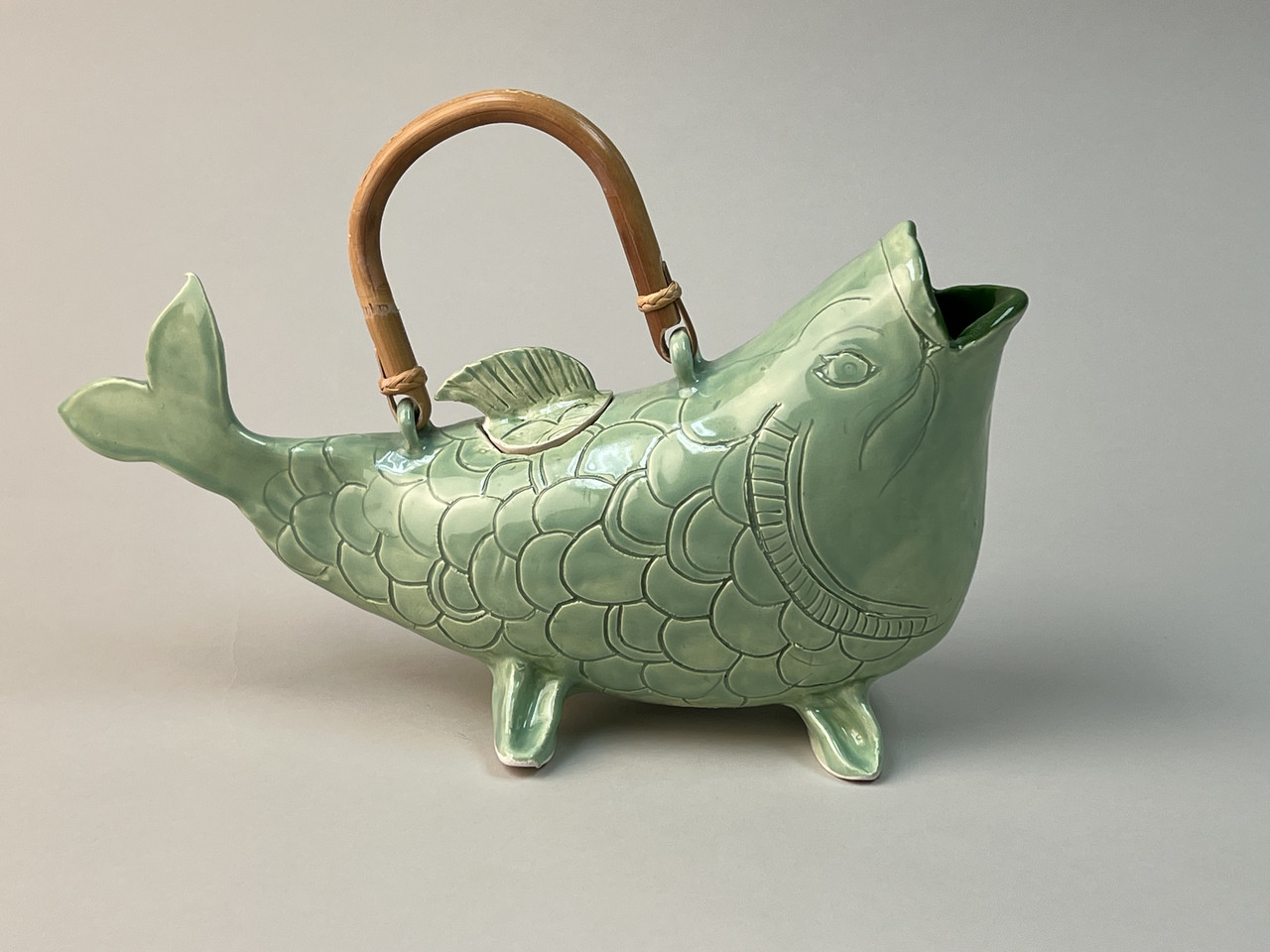
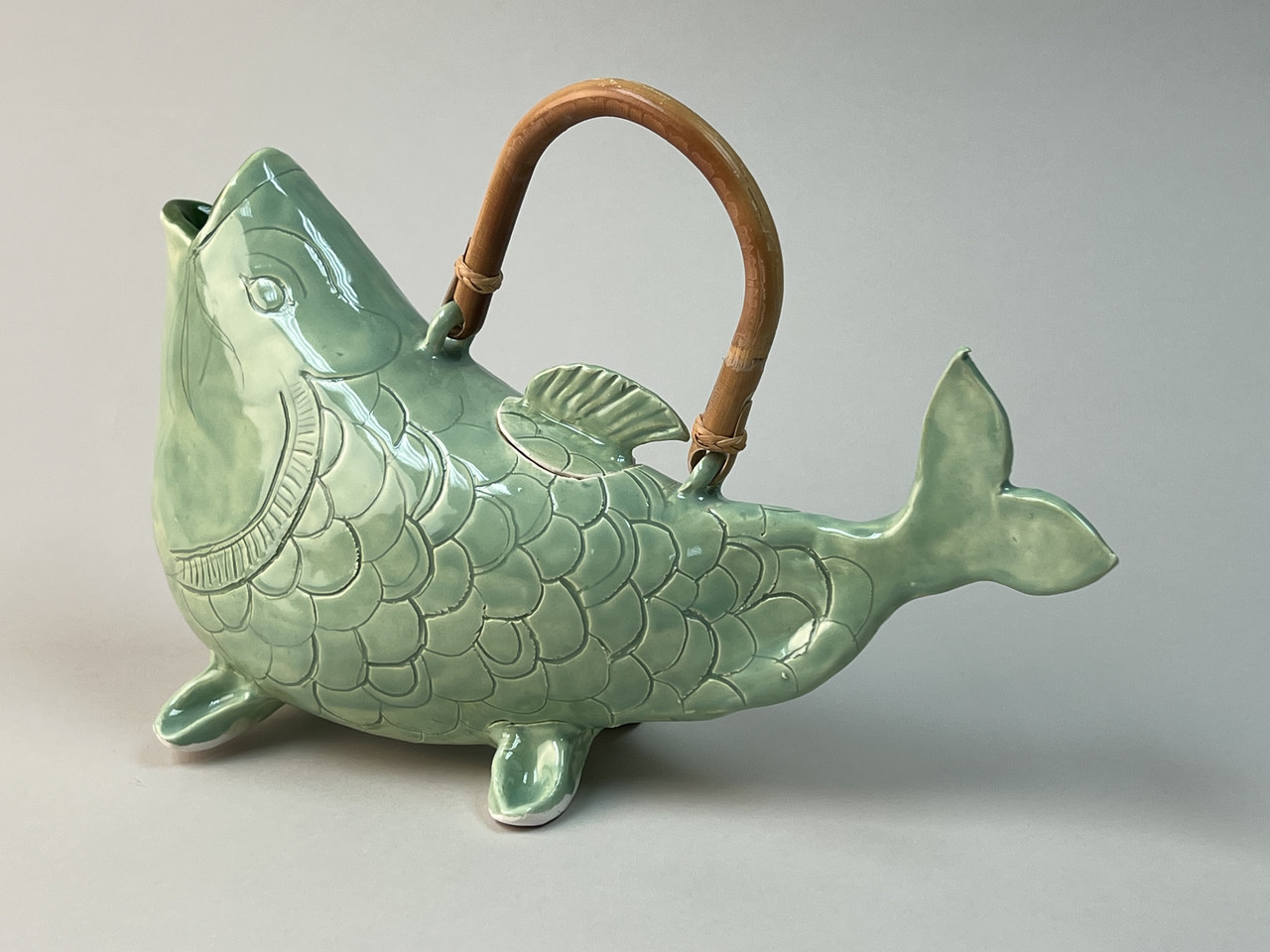
Charlotte Mount, Koi Ocha, 2024. White stoneware, Celadon glaze, Bamboo handle. 9” x 12” x 6.” Holton Arms School, MD.
Artist Statement: Koi Ocha: Fish out of water, or fish full of tea? This koi teapot celebrates traditional Japanese design and practice and synthesizes many of its elements, namely the seigaiha wave pattern. Its form is a product of the natural flow of creativity by making an armature, joining two slabs of clay around the body, and hand shaping its mouth, tail, and fins. The color is meant to match that of matcha – earthy, calm, and meaningful. The koi fish symbolizes the love and strength between those engaging in chanoyu, or the ancient Japanese Tea Ceremony. My hope is to bring together members of my community around this shared experience.
Natalie Oren
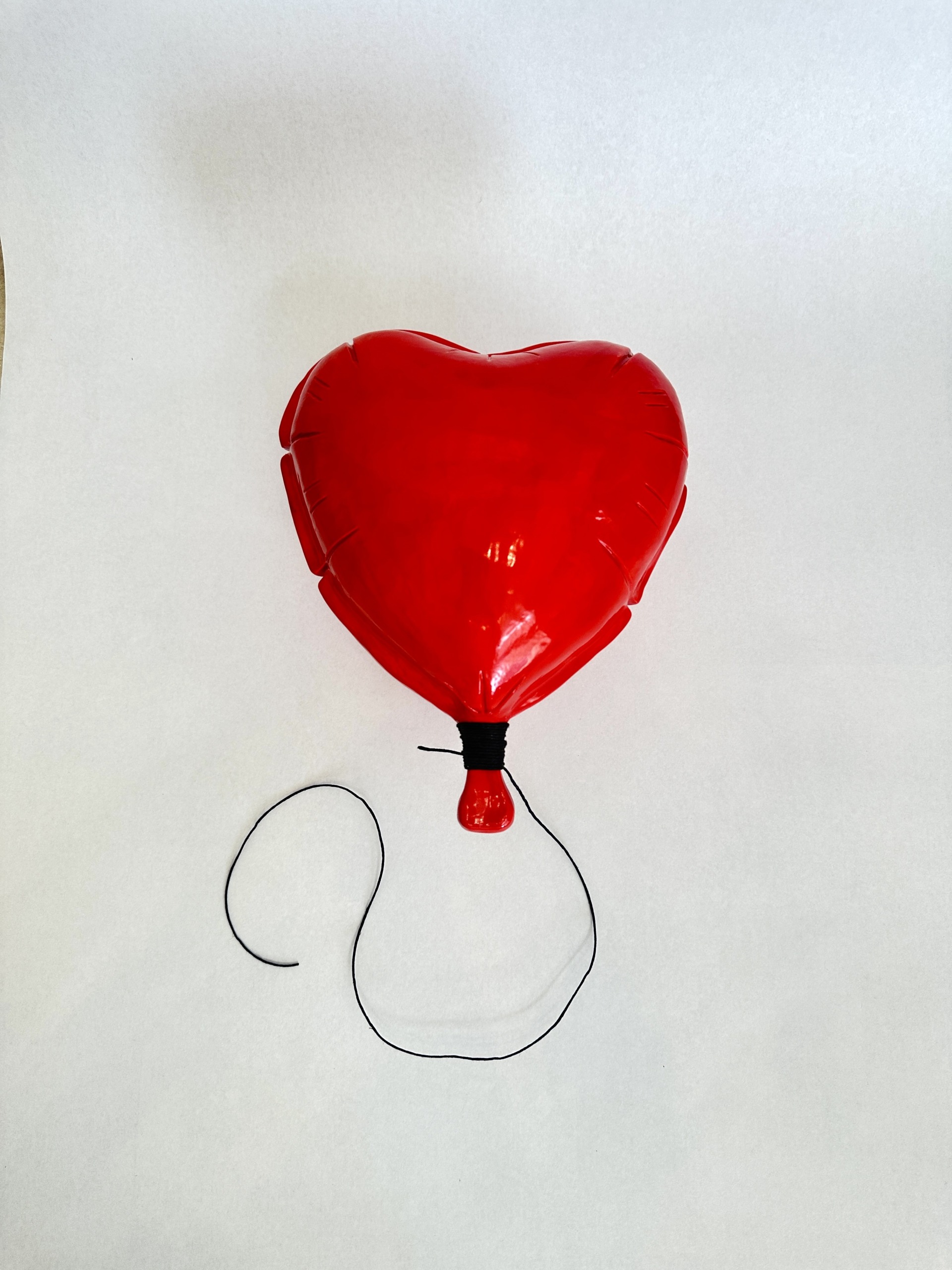
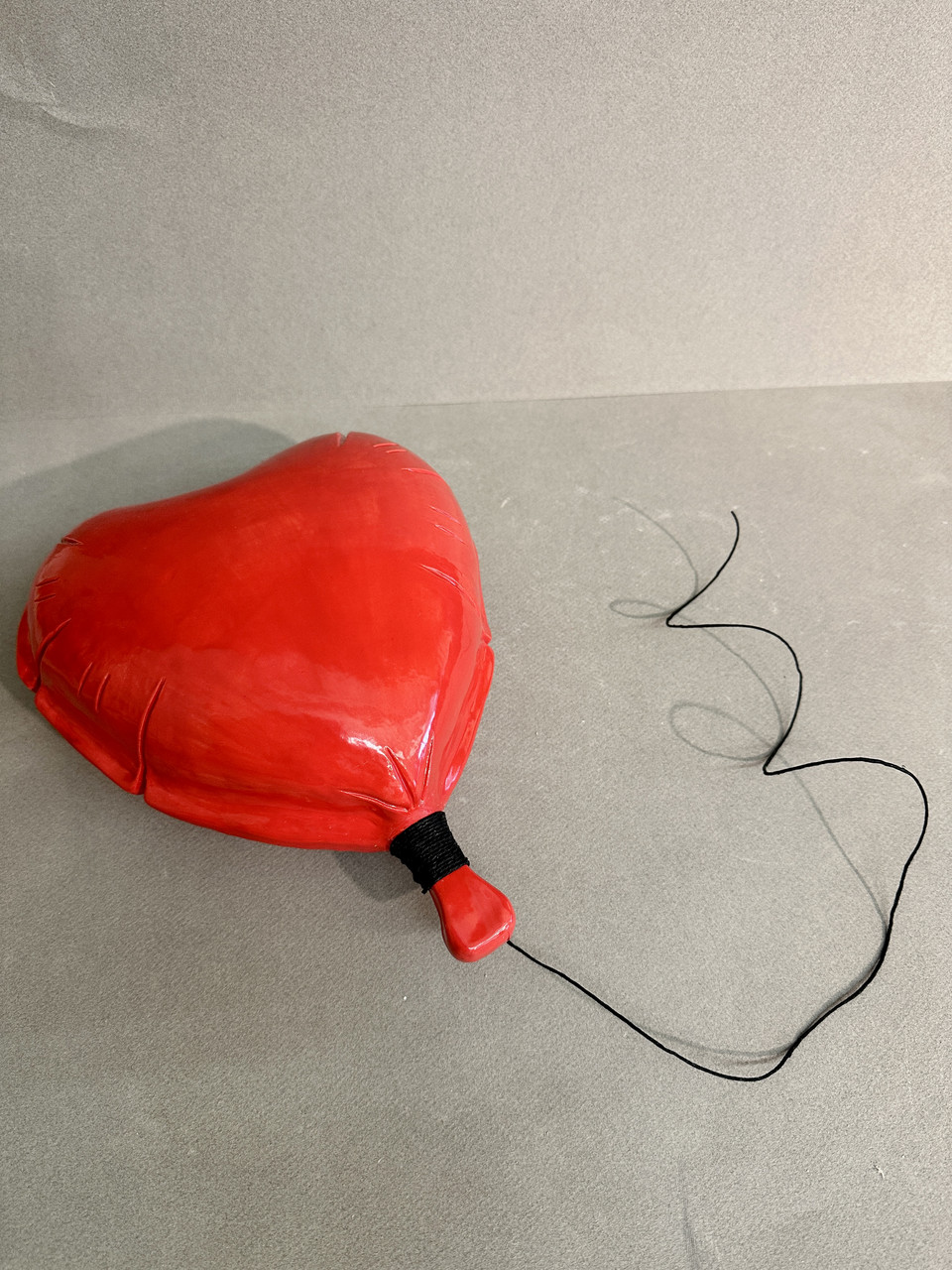
Natalie Oren, Love is in the Air, 2025. Stoneware ceramic clay, Red glaze, Black jute, 9” x 8” x 4.” NSU University School, FL.
Artist Statement: For this piece, I created a ceramic sculpture resembling a metallic mylar heart balloon. I chose clay because it allowed me to shape realistic folds and creases. The glossy red glaze gave it a shiny, metallic look. To enhance the realism and add movement, I attached black thread and string, making it feel even more like an actual balloon when hanging on the wall. I also viewed many real deflated balloons and tested different glazes to gain the most realistic effect.
Cody Taylor
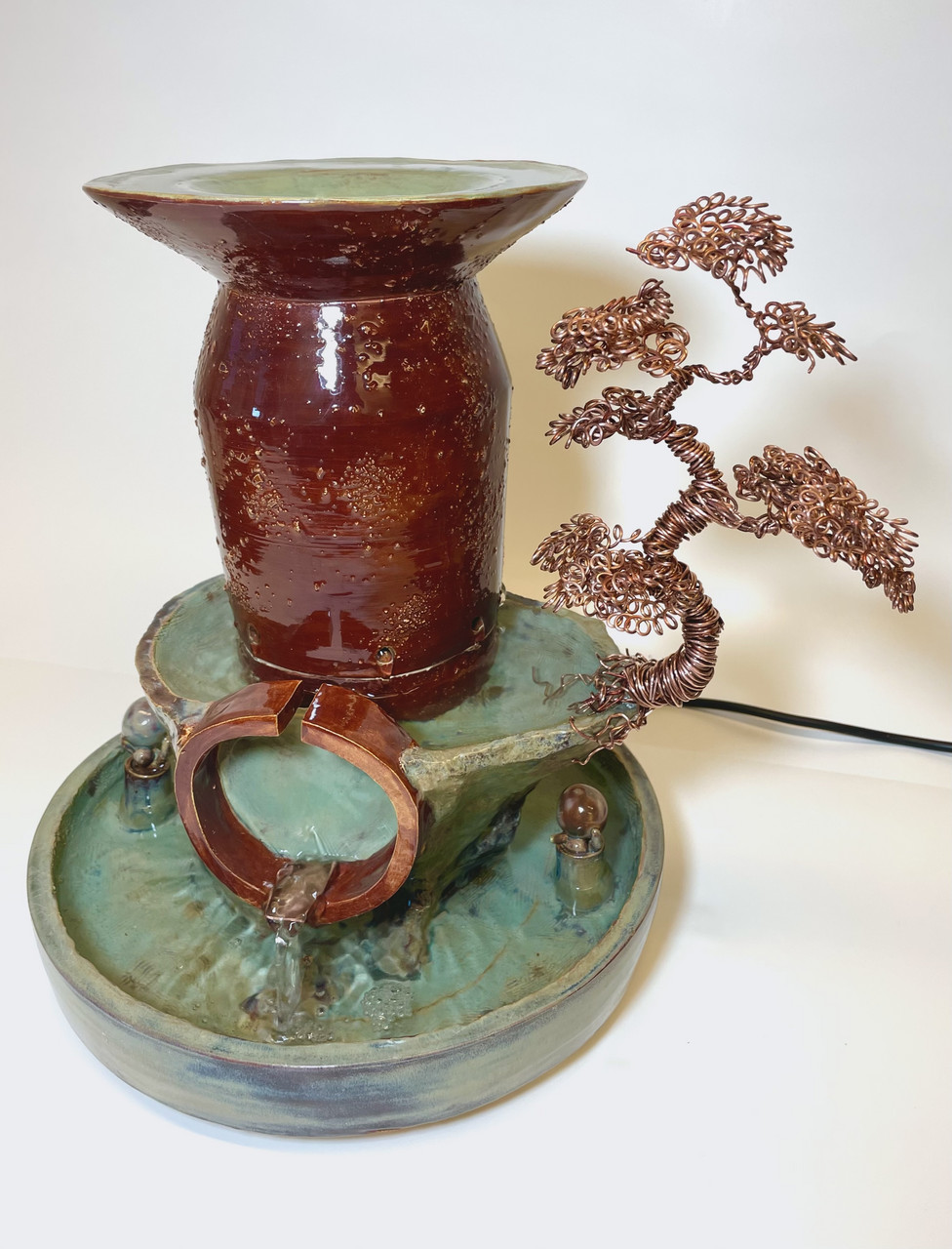
Cody Taylor, Untouched Silence, 2025. Ceramic, Glaze, Copper Wire Coils, Water Pump. 13” x 11” x 13.” Sacopee Valley High School, ME. Click for video.
Artist Statement: “Untouched Silence” stands at 13 inches tall as a functional three-tier water fountain made using slab and coil techniques. Inside is a working pump, tubing, and hand-built ceramic venting system that guides the flow of the water. Extensive testing was done with a variety of glazes to determine the final surface colors. The bonsai tree was made from copper wire coils. Each wire coil was individually twisted and wrapped. This piece was designed to give viewers a pleasing thought of imagination, with a mysterious land of water. It expresses a quiet environment throughout.
Julia Zou

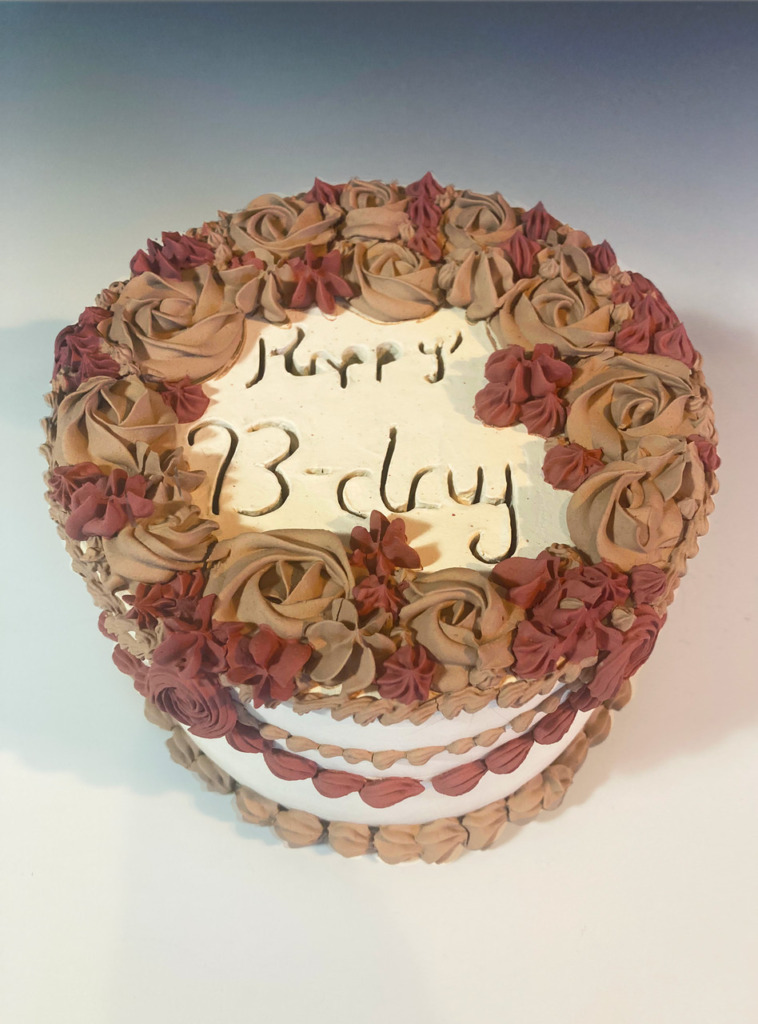
Julia Zou, Cake, 2025. Stoneware,5.5 x 7.” The Stony Brook School, NY.
Statement: In this assignment students were asked to create a lantern. This student decided to make a birthday cake to celebrate the birth of her younger sister. The form was slab built. Then she created a mason stain slip the consistency of frosting to pipe on the decorations like a cake.
11th Grade
Connor Albers
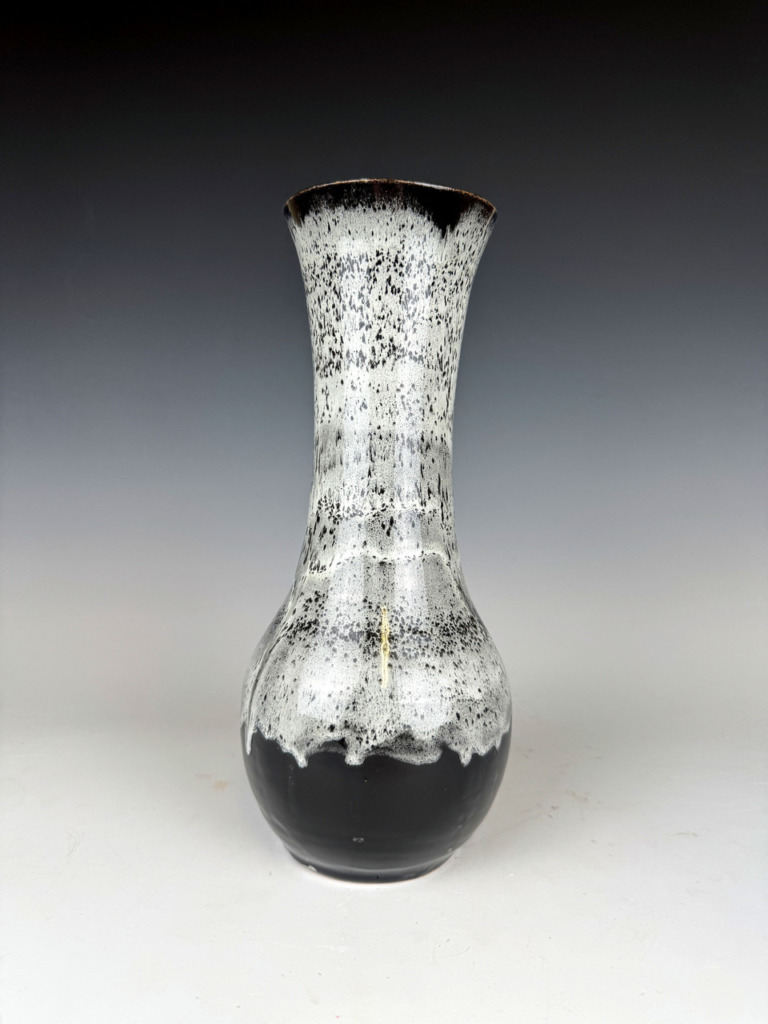
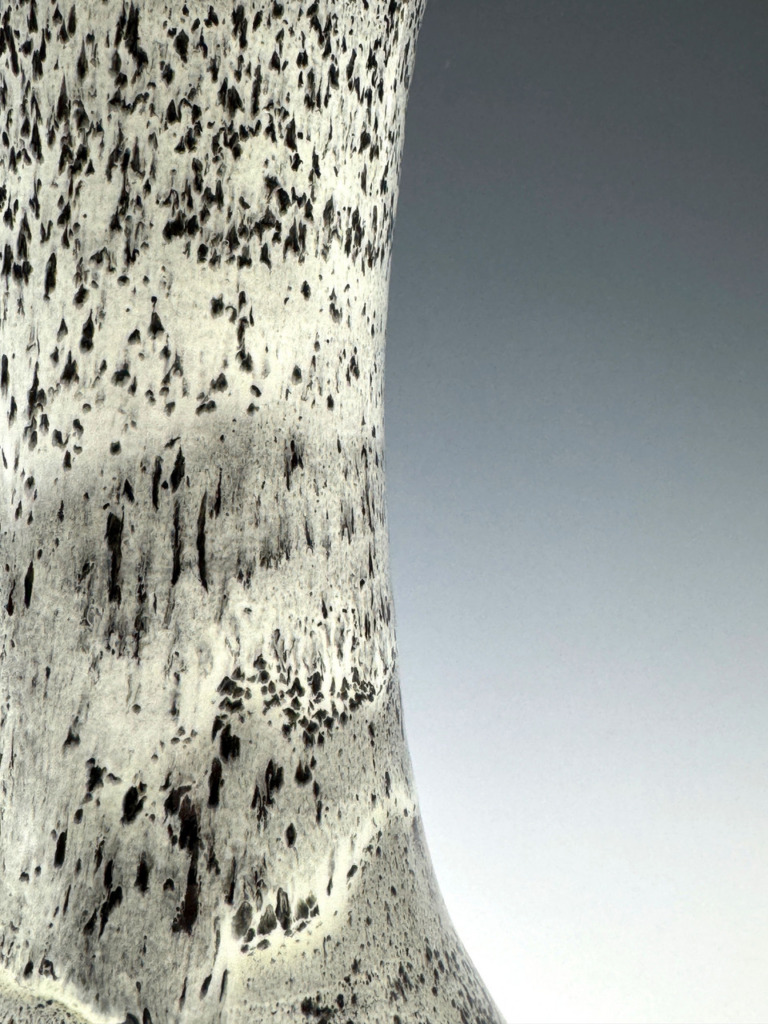
Connor Albers, Untitled, 2025. Stoneware, Glaze,18.” Osseo High School, MN.
Artist Statement: My vision was a vase with a long neck that flared out at the top. I created the vase with one peace and pulled the walls and used a wood modeling tool to shape the neck. I trimmed the peace with a S tool and smoothed the vase with a metal rid. For glaze i used a black dip for the first coat and then i used a white dip one the neck and half of the belly.
Emma Butler
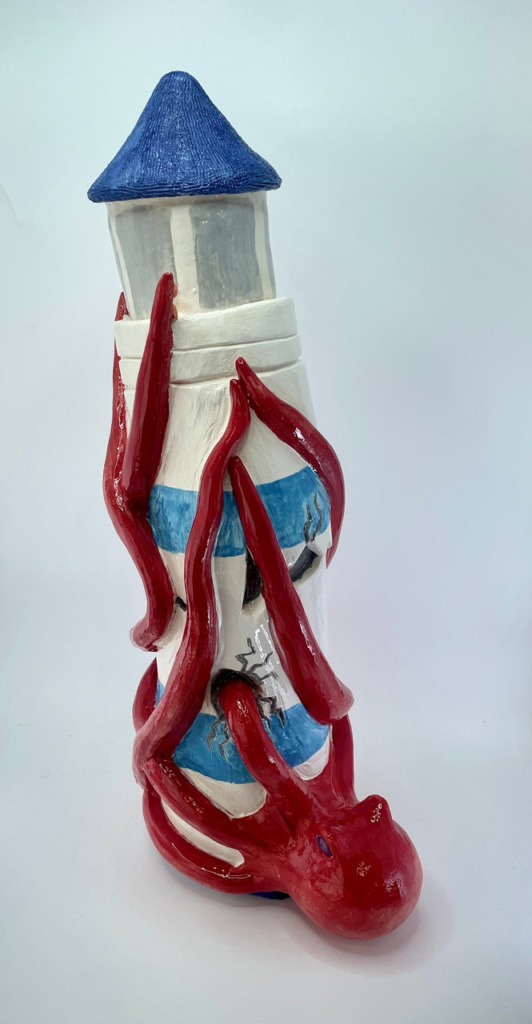
Emma Butler, Embrace of the Abyss, 2025. Ceramic Stoneware with Strock and coat glaze, 24” x 8” x 9.” Vista Murietta High School, CA.
Artist Statement: This is a hauntingly beautiful ceramic work of art featuring an octopus that had taken over a lighthouse, capturing the balance of nature with man’s development. Each tentacle of the octopus has been painstakingly hand-made with its fluid movement and grace reflected in each delicate form. I used vibrant glazes in the blues and the grays while the texture in the legs of the octopus offers a tangible quality. The lighthouse itself, hand-built, is a testament to mankind, but it appears fragile as the legs of the octopus engulf it, some of them even penetrating the walls. The shiny octopus against the flat lighthouse contributes to the tension in the painting. This work not only tells a story of the power of nature but also works to convey my passion for ceramics and the laborious process of crafting each component by hand.
Chloe Chrobocinski
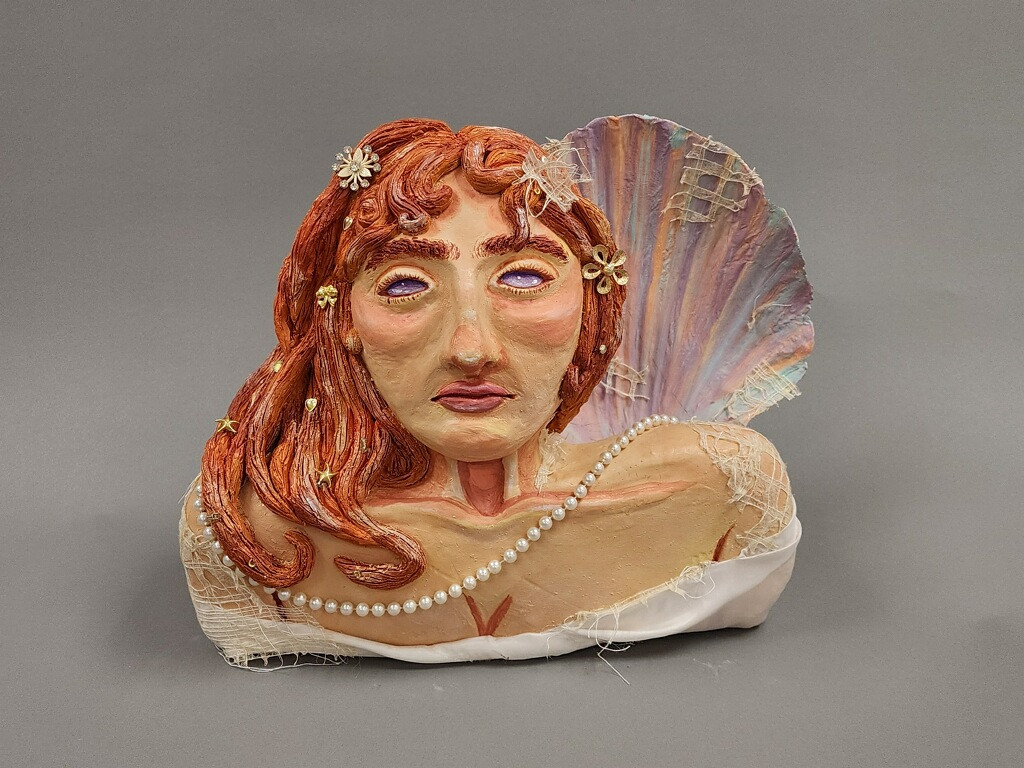
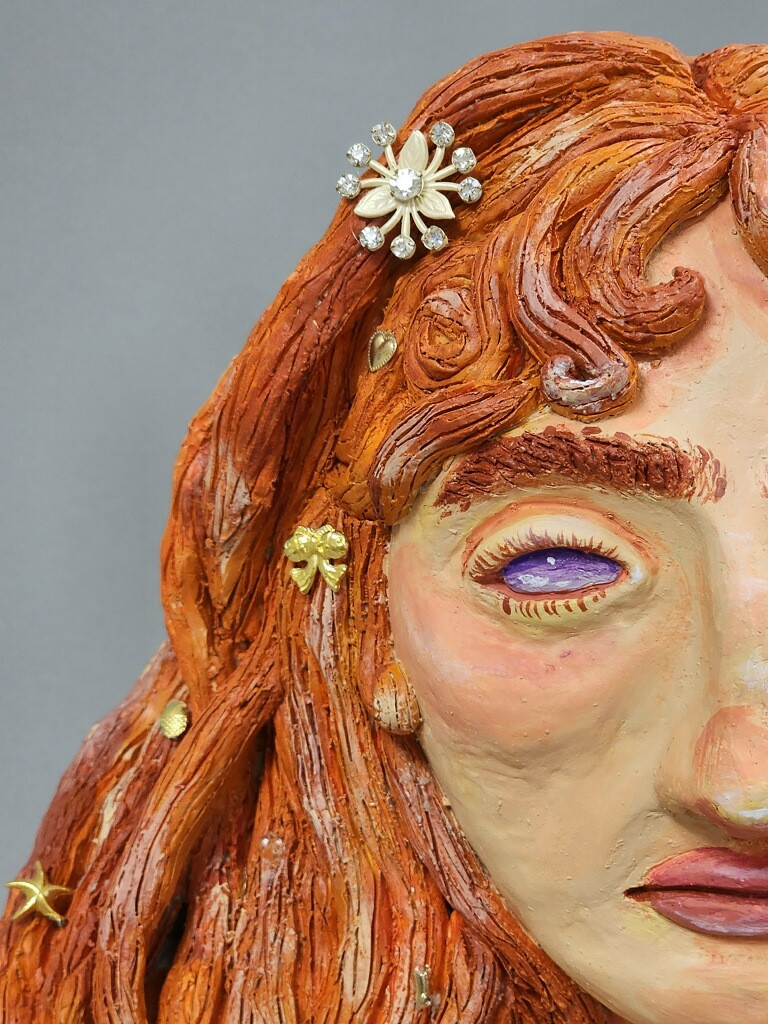
Chloe Chrobocinski, Venus 2025. Clay, acrylic paint, fabric, pearls, paper mache, 12.5” x 14” x 6.” West Orange High School, NJ.
Artist Statement: I was inspired by The Birth of Venus by Sandro Botticelli as well as ancient roman sculpture. I wanted to create a bust that paid tribute to both of those things while using my own creativity to do so. I used various fabrics, metals, and pearls to portray the softness and richness that I associate with Greek goddesses, especially Aphrodite, as well as the ocean. I used warm colors that work well together as well for the same effect.
Mila Davis
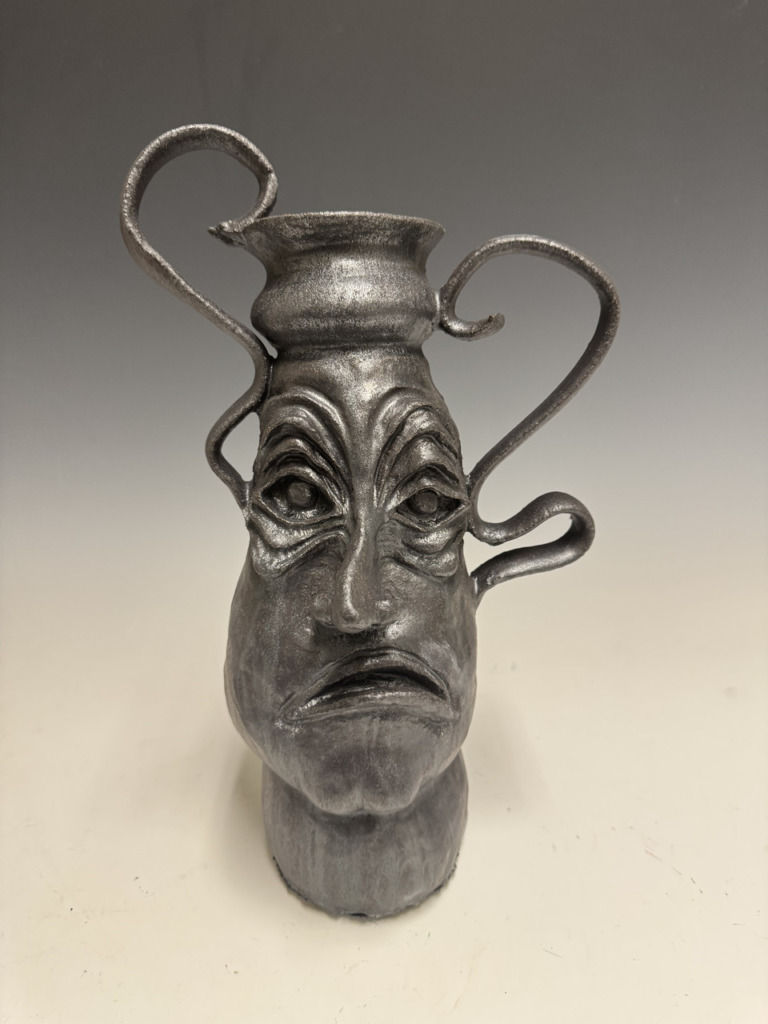
Mila Davis, Metallic Face Vase, 2025. Ceramic, metallic cone 6 glaze, 14” x 9” x 5.” Laguna Beach High School. CA. Click for video.
Artist Statement: I like to create whimsical pieces of art. I made a unique vase out of three pinch pots and then created the top part of the wheel. I then made handles and carved the face. For the glaze, I was inspired by the look of lost waxing technique I learned in AP art history so I used a metallic glaze over the whole thing to mimic this.
Andy Dümmar
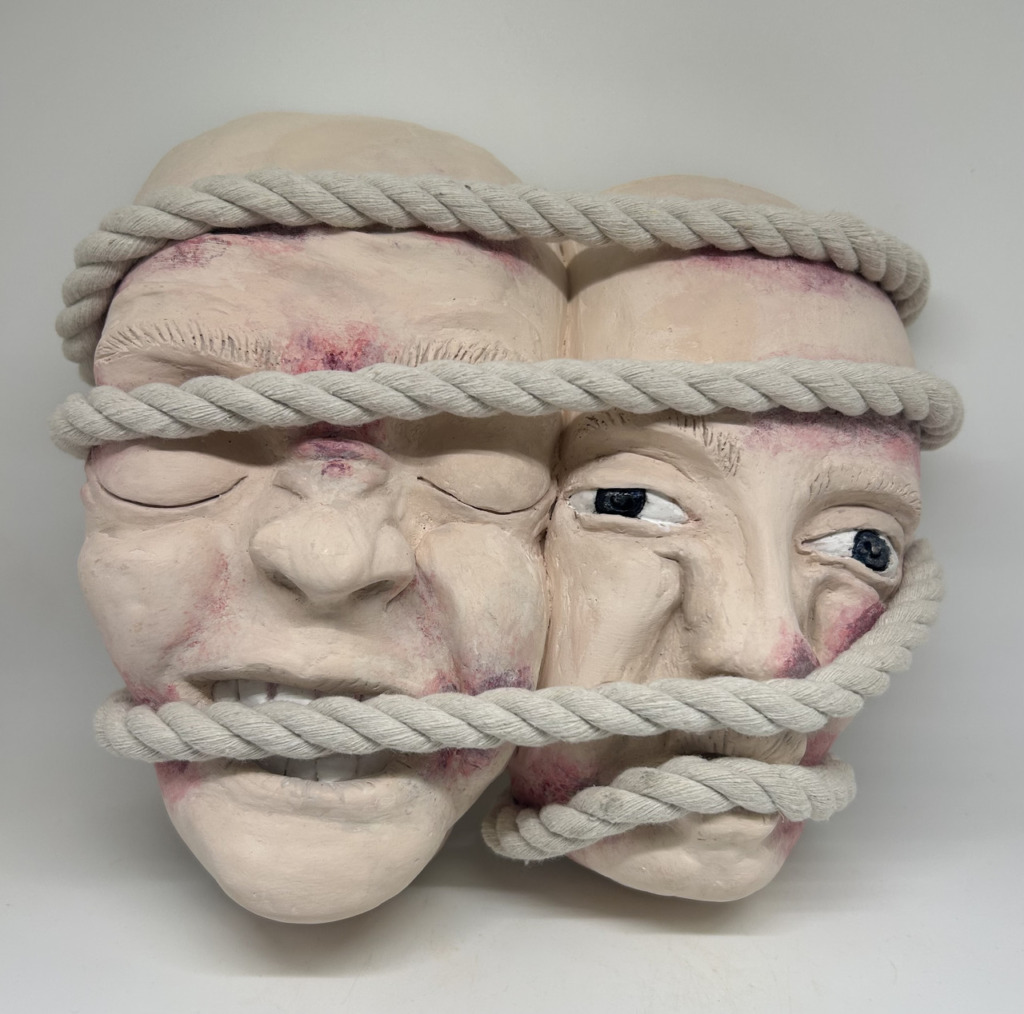
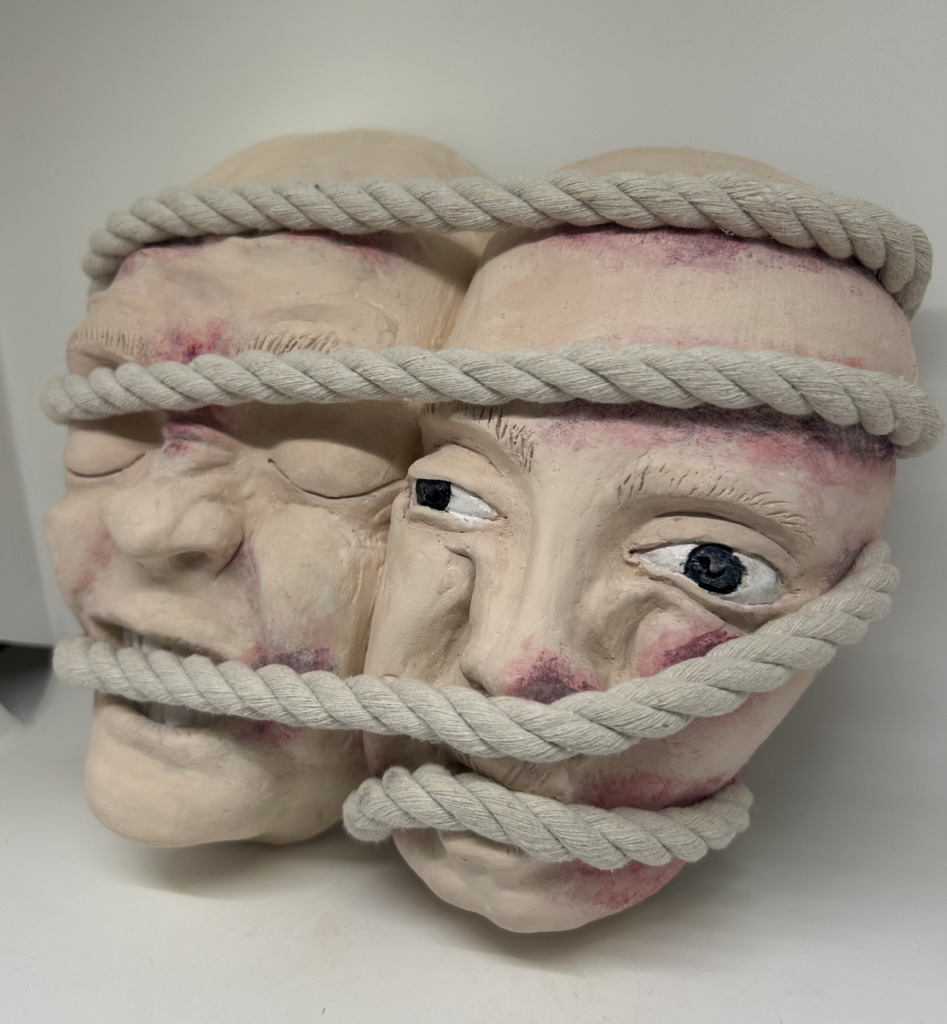
Andy Dümmar, Squished, 2024. Cone 6 Laguna bmix clay, rope, 12” x 6” x 3.” Wasatch High School, UT.
Artist Statement: At the beginning of the school year I chose I topic I would base all my projects on for the year. The topic I chose was “how can I invoke emotions in people just by looking at my projects?” For my first project i chose to do “squished.” I used plaster to cover my face to make a mold. I laid clay over that to create the shape of a face. Then I carefully sculpted each face using reference pictures, one being of my teacher. After firing I painted the faces with a light skin color and used watered down acrylic paint to make burn-like marks where the rope would go. I wrapped the rope around the faces (using grooves I created before firing) to make it seem like the faces were being pulled together.
Joel Duncan
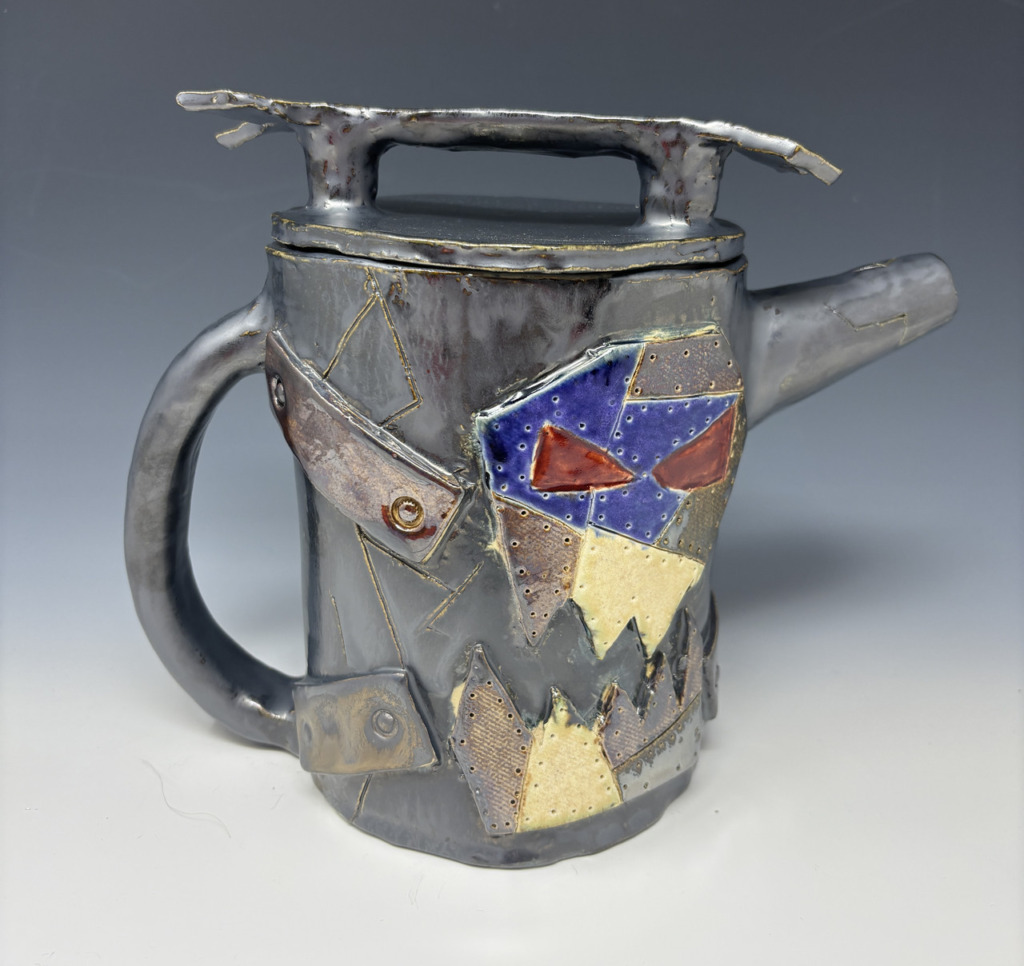
Joel Duncan, Scrap Teapot, 2024. Kentucky MudWorks Ice Man Clay, 9” x 7” x 5.” Belleville East High School, IL.
Artist Statement: At this time I was very into Warhammer 40K. My favorite faction was the Orks, so I wanted to design my teapot after the ramshackled theme of the Orks.
Kate Dunn
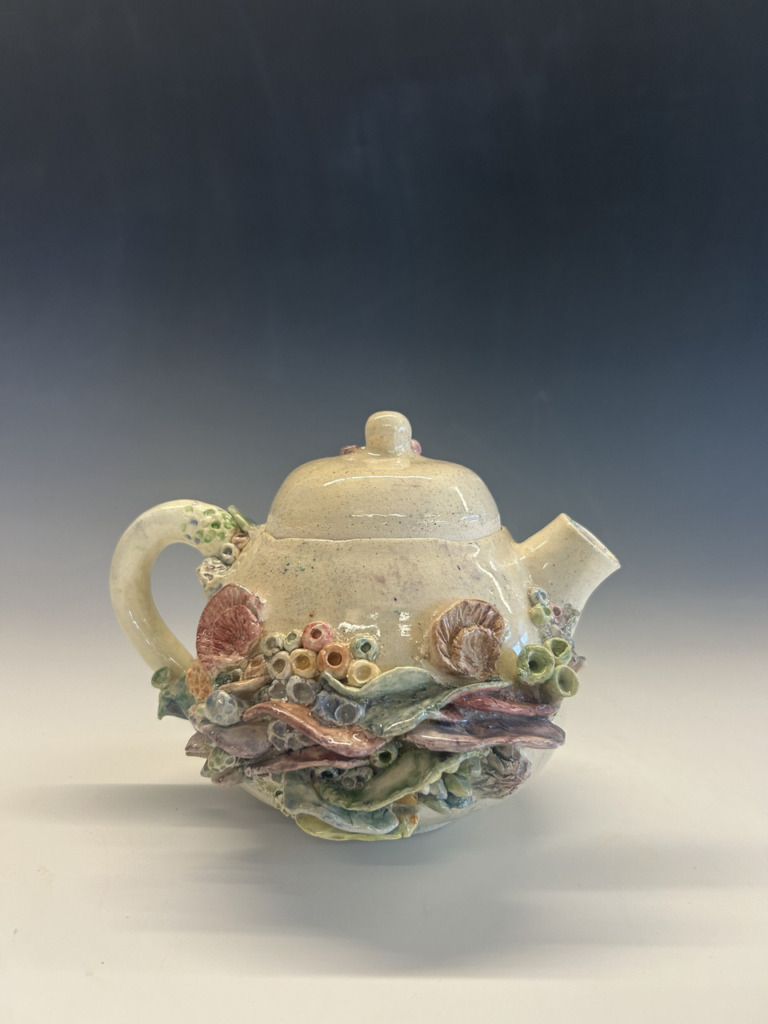
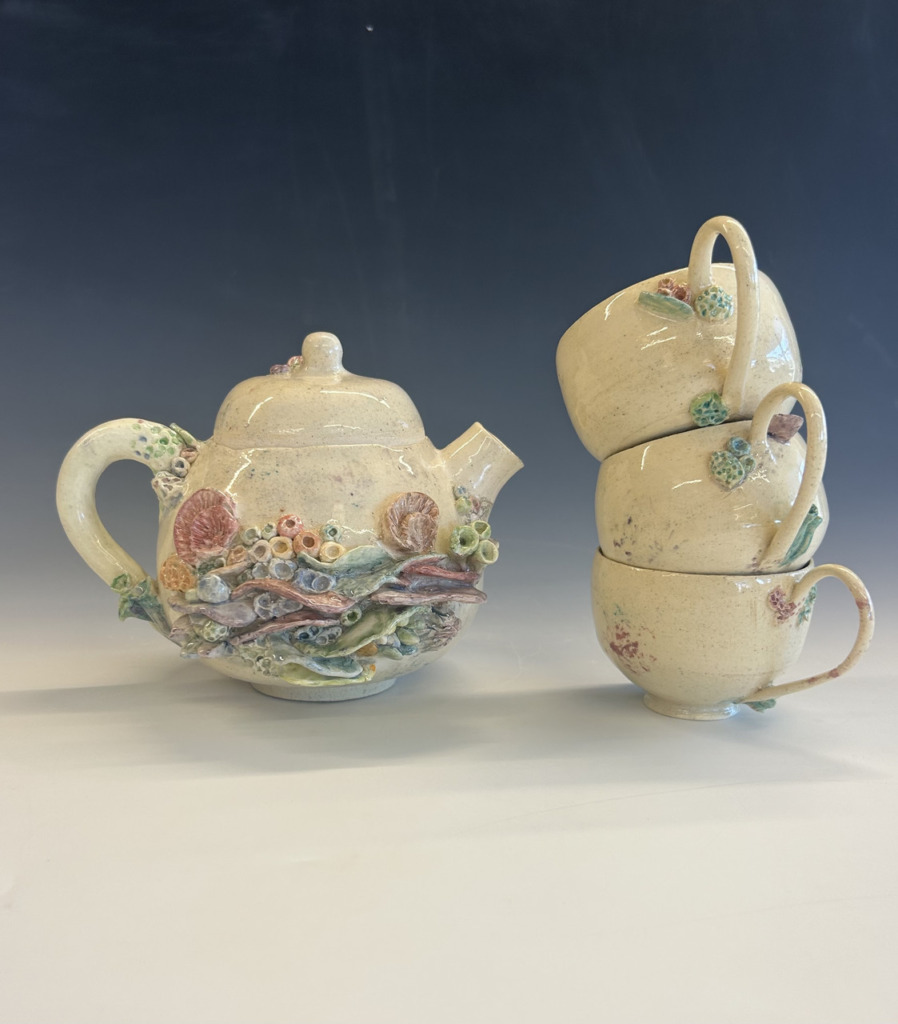
Kate Dunn, curiosities, 2025. Stoneware and underglaze, 5” x 6” x 5″ (teapot). Stone Ridge School of the Sacred Heart, MD.
Artist Statement: What is a shelf? A shelf is an object that holds up others. These could be precious objects, dreams, life, etc. This is the question that inspired my project. I decided to make work inspired by coral reef formations and the curiosities they harbor. This was my first attempt at creating a teapot, so the entire build was a new experience for me. I began with a wheel-thrown form using white stoneware clay. The challenge, was to transform that into a functional teapot using new hand-building techniques and anatomically correct sculpting. I finished the work using a watered-down underglaze and a zinc-free, midfire, clear glaze. The result is my visual portrayal of what a shelf can be and what I am interested in. I am very proud of my work and excited to share the results. The teacups were made after the fact to accompany the teapot.
Keyla Echevarria
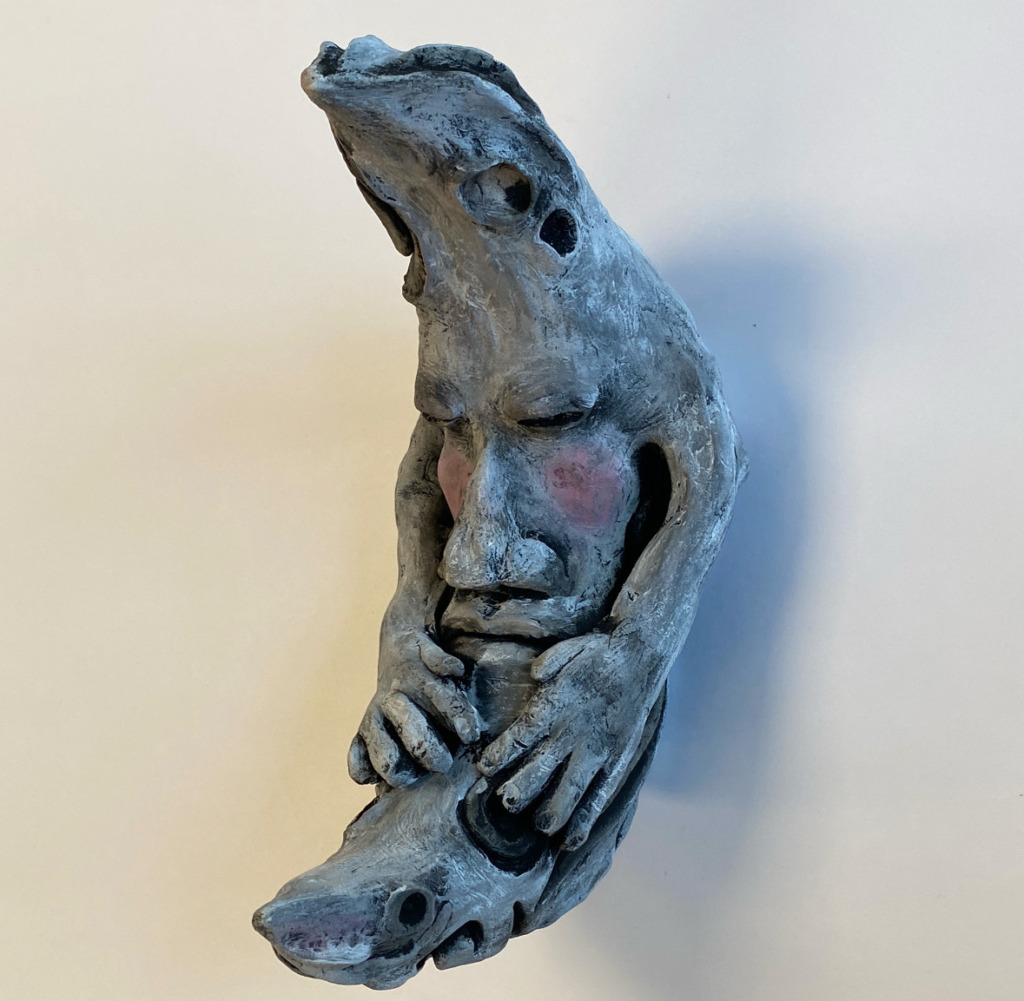
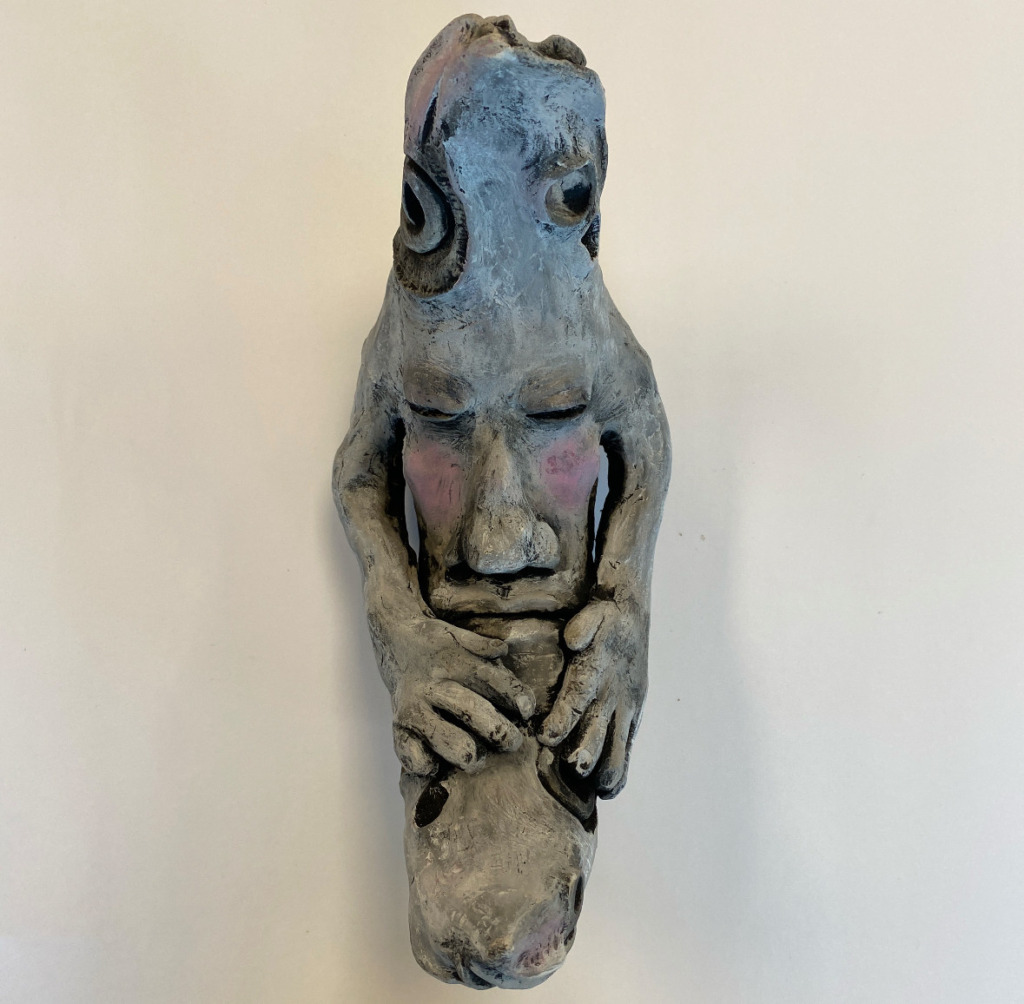
Keyla Echevarria, Man in the Moon, 2024. Ceramic, 4” x 9.” Liberty High School, OR.
Artist Statement: My vision was first gonna be the moon by itself but then I started playing around with the nose and the eyes and decided on making it a moon with the face of a man on it. I started thinking deeper of the meaning behind it and I decided on making the moon look sad. To kinda symbolize the story of some people and what they go through on a day to day basis. In my head I made up a story of the man being lonely and added that onto the facial features. The man is sad because he feels lonely and that resembles most people today. It started off as just me sculpting the moon because I found it fascinating, to a deeper meaning the more I thought about it.
Winona Ettawageshik
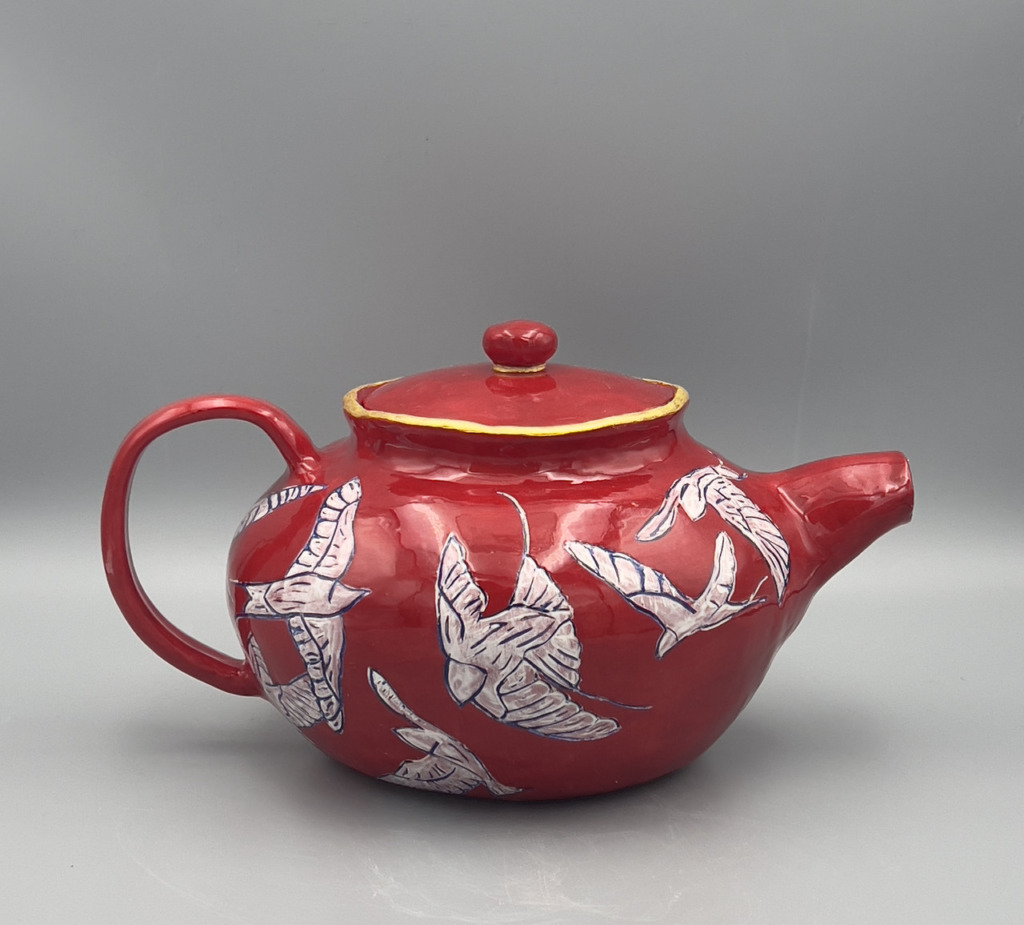
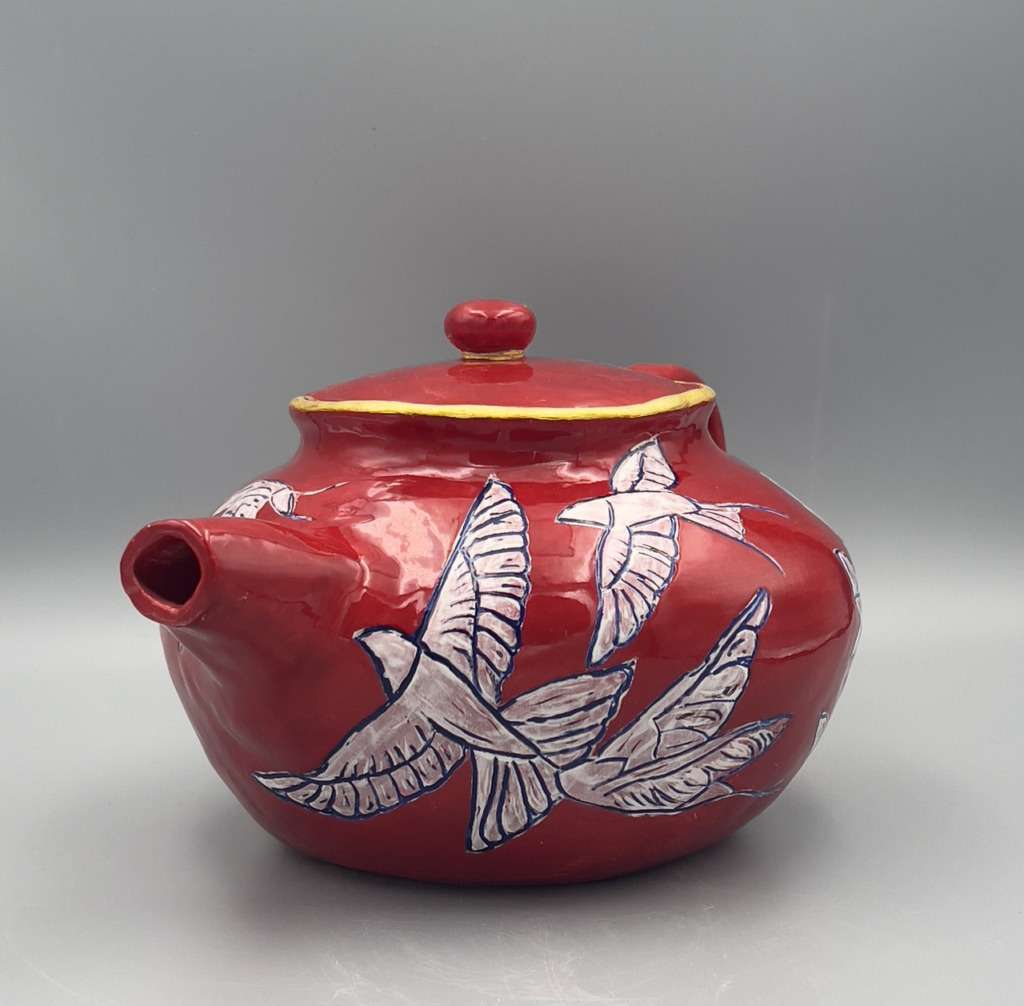
Winona Ettawageshik, Birds Across a Red Sky, 2025. Ceramic, Underglaze, Acrylic paint, 7” x 11” x 9.5.” Breck School, MN.
Artist Statement: In my ceramics class we had an assignment to create a teapot, structural or sculptural. When researching and looking through other teapots, I was drawn towards the teapots that had a simple form with a more intricate design. There was nothing that specifically that drew me to include sparrows in my design other than the fact that I found their form interesting and thought that they would add movement to the overall composition. I chose to include birds of multiple different poses in order to create a flying affect across the teapot. I also decided to use the sgraffito technique to not only allow for more variance in color in the piece but to also add detail and texture to the birds. I decided to paint the background of the birds red, the actual birds white, and their outlines blue because I enjoy that combination and also wanted for the sgraffito to have contrast from the rest of the piece.
Luke Ghammachi
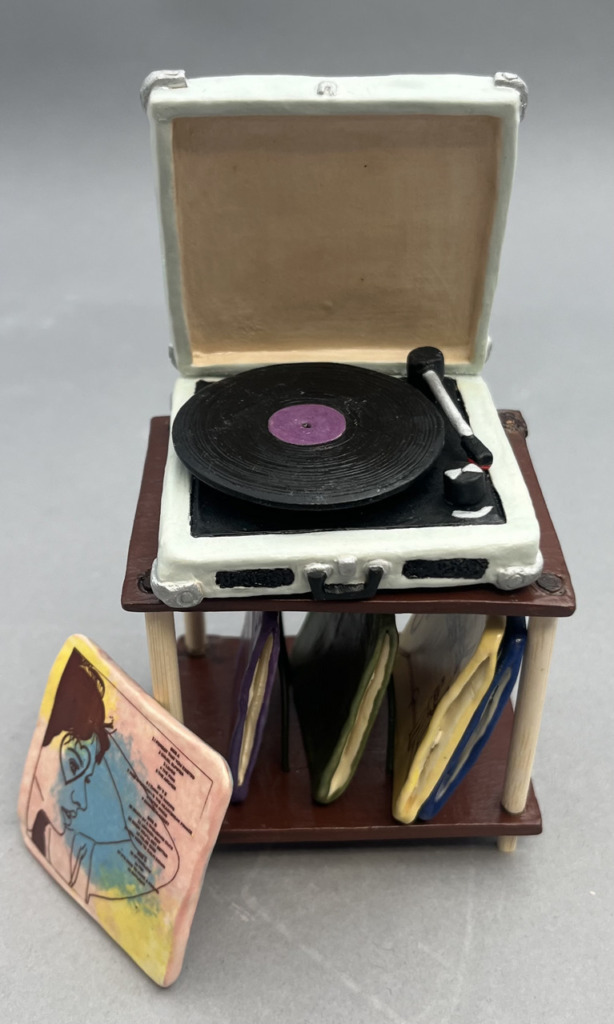
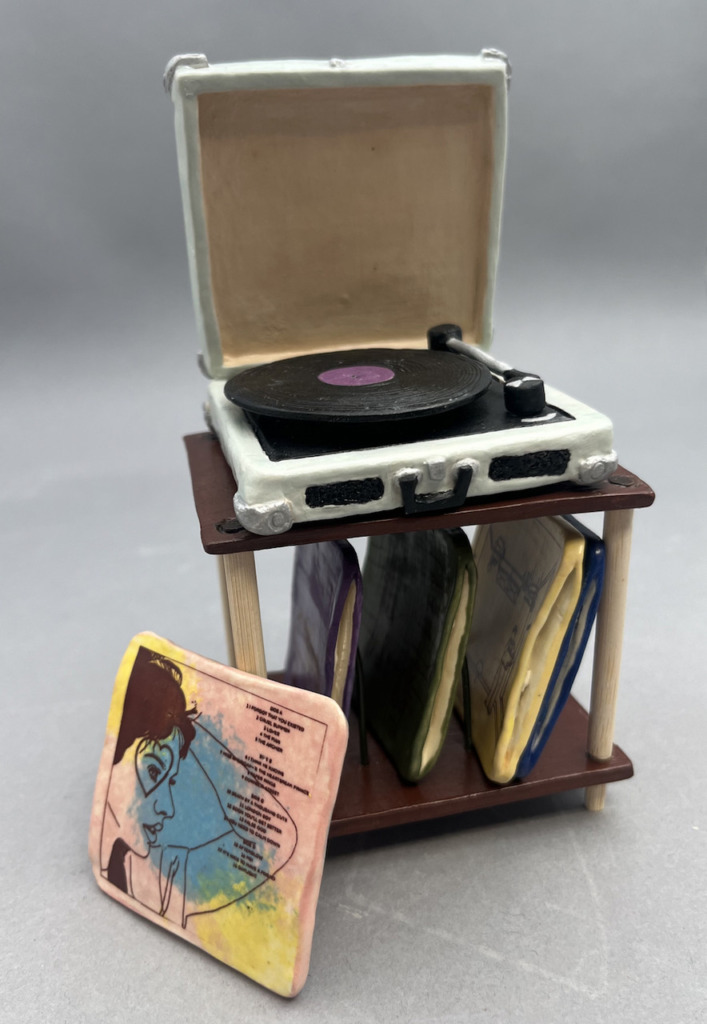
Luke Ghammachi, Music to my Ears, 2024. Low-fire Clay, Underglazes, Decals, 3” x 2.5” x 5.75.” Chadwick High School, CA.
Artist Statement: My vision while making this piece was to recreate my record player and record that I have at my house on a small scale. I really enjoy music, and it is a big part of me, so this was a way of expressing myself through clay. My process of making this piece was that I started off by molding the record player, the stand, and the albums with clay. After they were fired, I glazed each of the pieces with underglaze, then gloss glazed. The record player I built fully with glaze and clay. For the stand I made, I used clay and glaze for each shelf, but then for the legs, I used wooden dowels. For the miniature albums, I used clay, glaze, and decals. I drew pictures of albums I listen to often on my ipad and then used decals to transfer the drawings onto the piece. This project took a lot of time and a lot of trial and error to get things to work, but I am happy with how it came out in the end. This piece is slab-built, painted with underglaze at the bisqueware stage, and gloss glazed. Decals were added to the albums after gloss glaze firing and wooden dowel legs were added to the stand after all firings. Also, the record on the record player can spin, the needle that would “read” the record moves, and you can move the on and off button.
Victoria Haraden
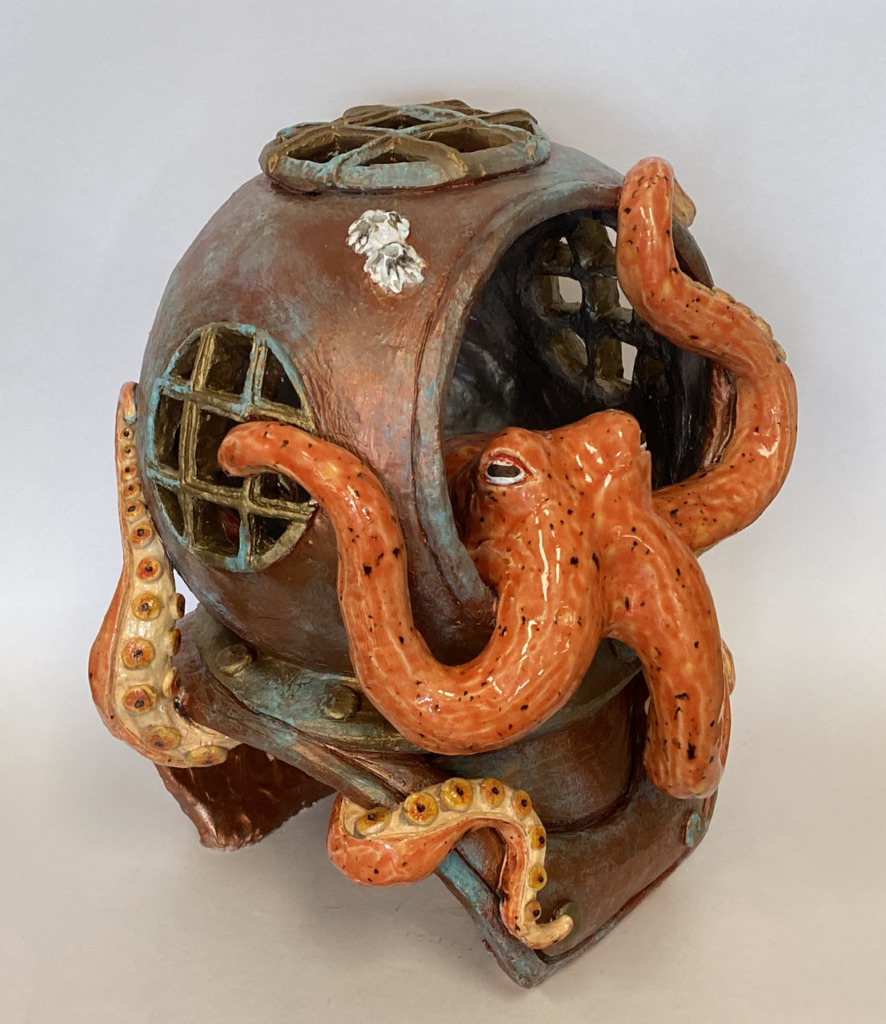
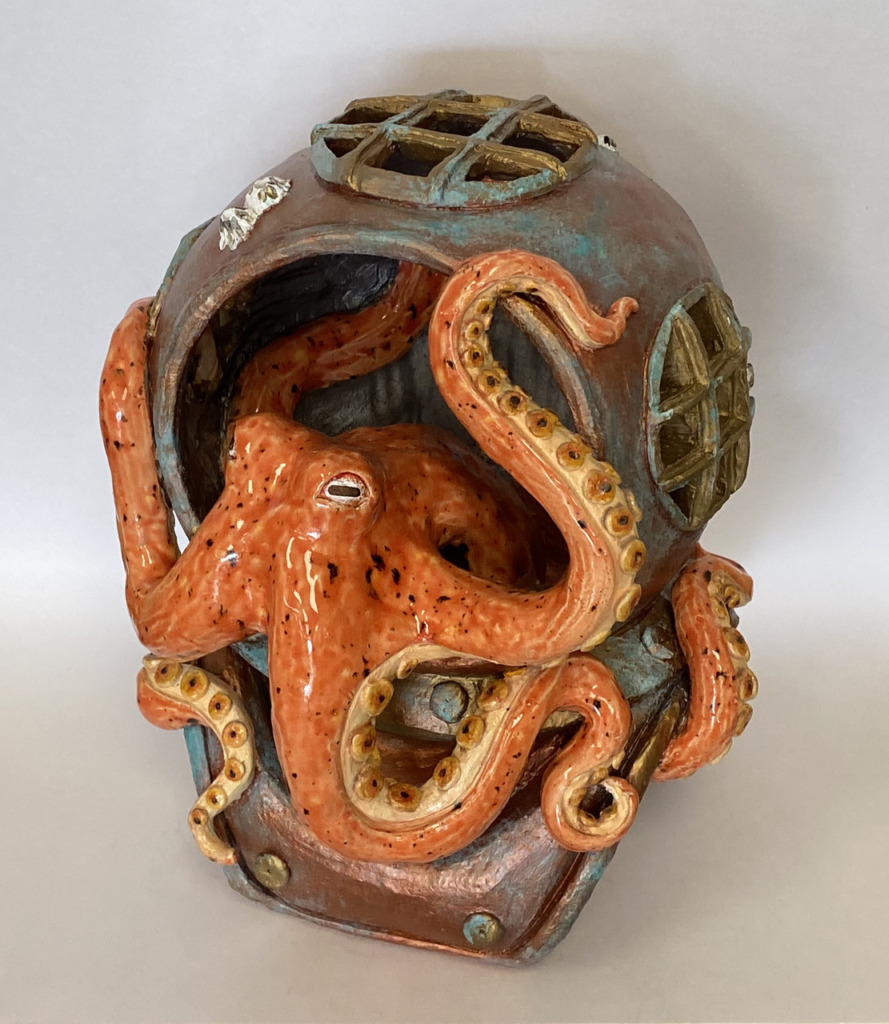
Victoria Haraden, Ink, 2025. Ceramic, 9” x 9” x 13.” Liberty High School, OR.
Artist Statement: Research was primarily directed toward the flow and movement of the octopus and the natural colors and movement of the creature. The helmet structure and details were researched as well and the aging process of metal that has been oxidized and the color of the patina and rust around all of the details. This piece was created using medium dry clay. The helmet was sculpted first by rounding it out and smoothing around the entire sphere. Then when the helmet was finished being sculpted, the octopus was then created and attached to the inside of the helmet using a needle tool and other carving tools as well as knives. Its legs were wrapped around it and intertwined in and around the entire piece. When the piece was done drying and being fired in a kiln, the octopus was painted with glaze and acrylic paints. The helmet was sculpted using metallic acrylic paints as well as some blue and turquoise acrylic paints for the rust and patina. These experiences as well as working with clay regularly have helped me expand my way of thinking and looking at artwork. It challenges my mind to think of all dimensions of art and to find new ways to creatively express my life experience. In addition, working with clay has encouraged me to share some of my personality and creativity with my peers and fellow artists in my community.
Ananya Menon
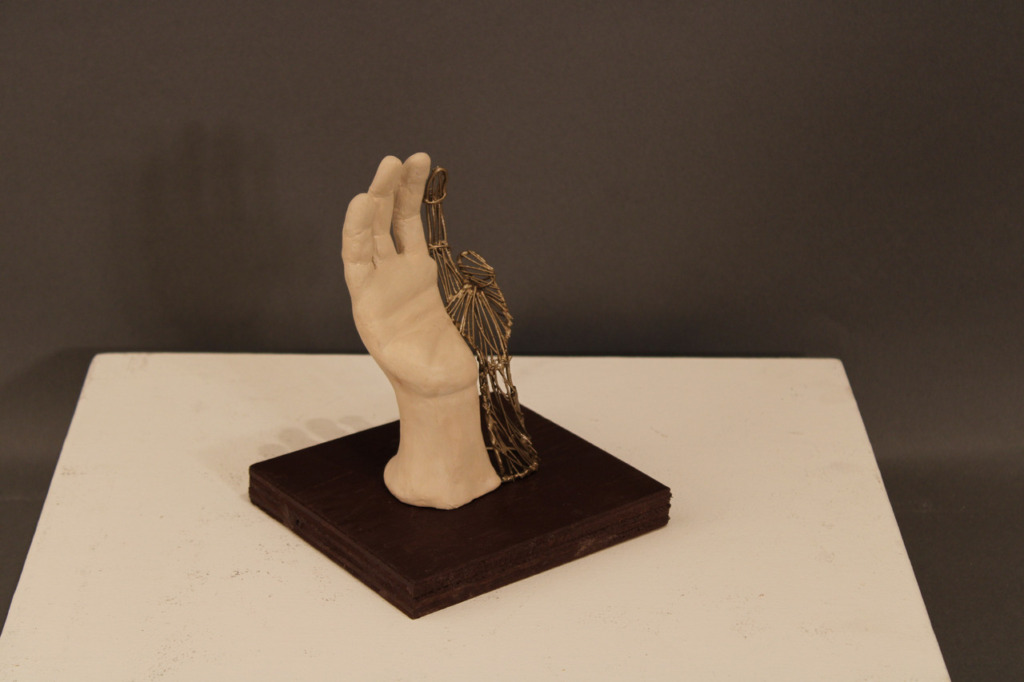
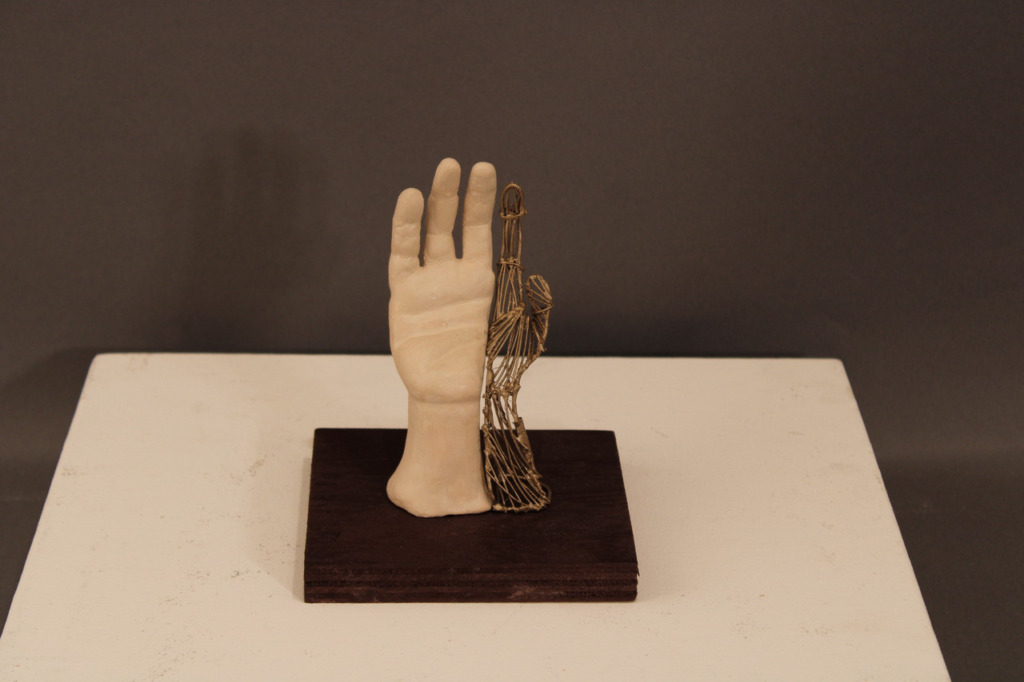
Ananya Menon, Redefining Touch, 2024. Ceramic, acrylic paint, wire, spray paint, 5.4” x 3.4” x .9.” Dublin High School, CA.
Artist Statement: “Redefining Touch” represents a fusion of humanity and technology, highlighting an evolving relationship between human nature and its artificial counterparts. In creating this project, I had to constantly reference human anatomical forms in order to replicate the form and gestural intricacies of a hand.
Ben Sanvik
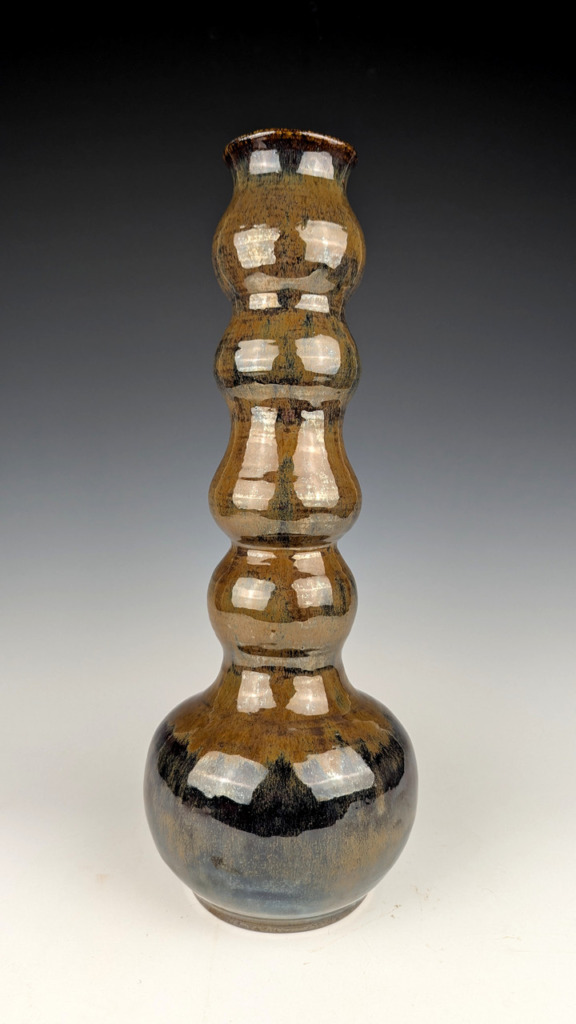
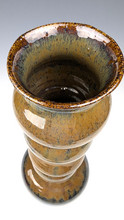
Ben Sanvik, Bubble Vase, 2025. Stoneware, glaze, 20” x 8” x 8.” Osseo Senior High School, MN.
Artist Statement: My vision was to have 4 bubbles up the neck and one large belly on the bottom. I did this by throwing a tall cylinder and then add four bubbles into it. I then threw a bottom belly and slip and scored them together to make the bubbled vase.
Kavya Singh
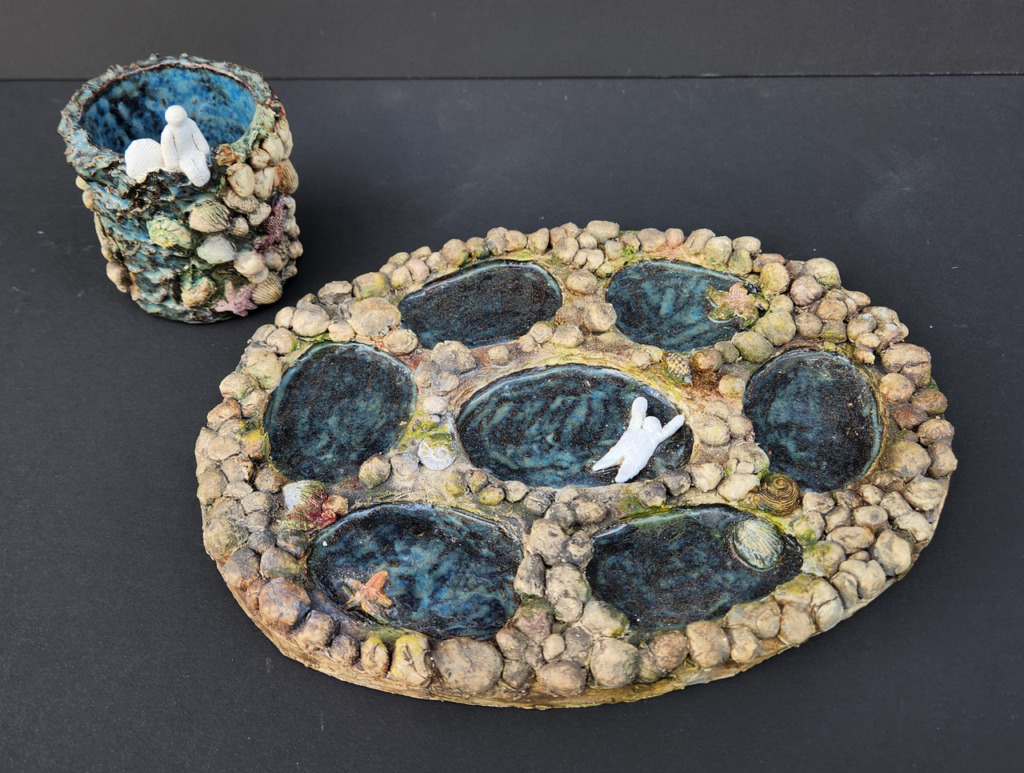
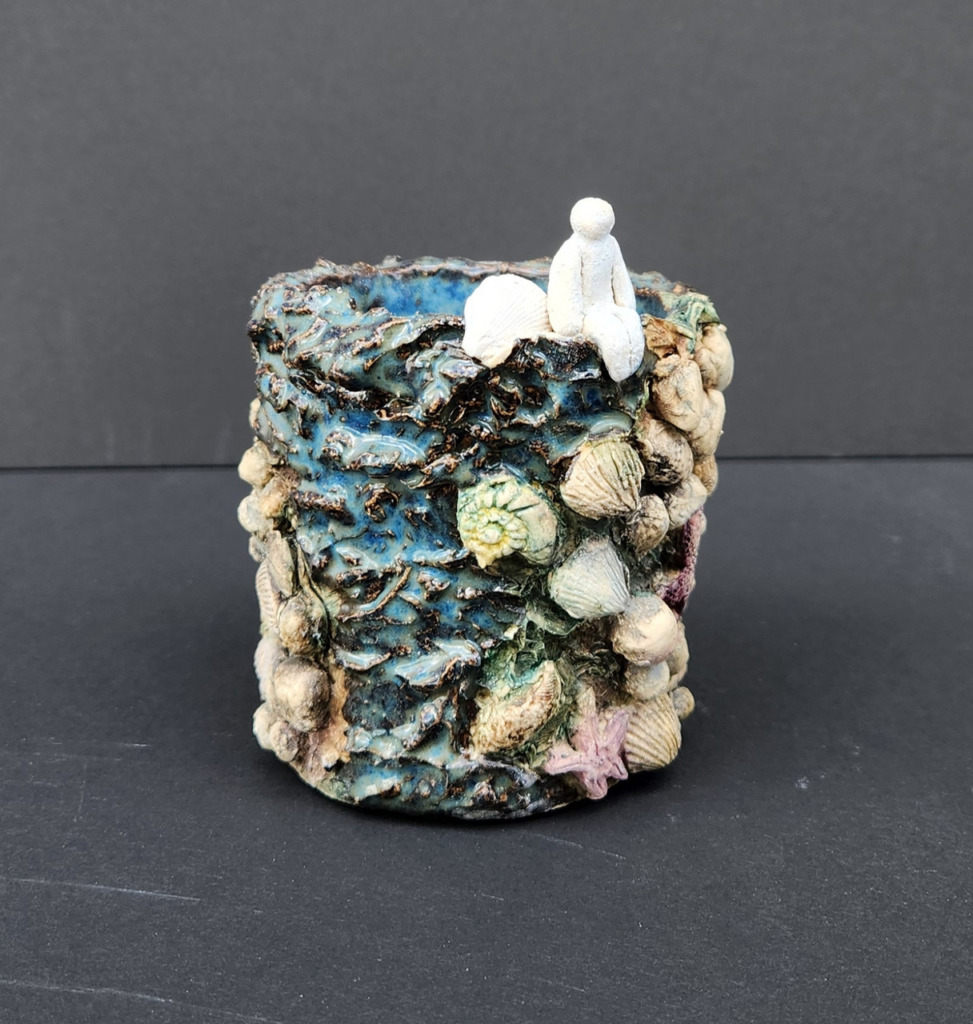
Kavya Singh, Afloat, 2024. White clay, stains, glaze, acrylic paint, 12” x 8” x 4.” Dublin High School, CA.
Artist Statement: I wanted to display a moment of relaxation for the little people in my sculptures. Although things can seem bleak at times, and it can feel like you’re deep in struggles, drowning, you’ll find a way to stay afloat despite everything. You will find relief and happiness, no matter what; hence the little person floating among the dark pools of water, representing them finding some solace.
Katelyn Stoffregen

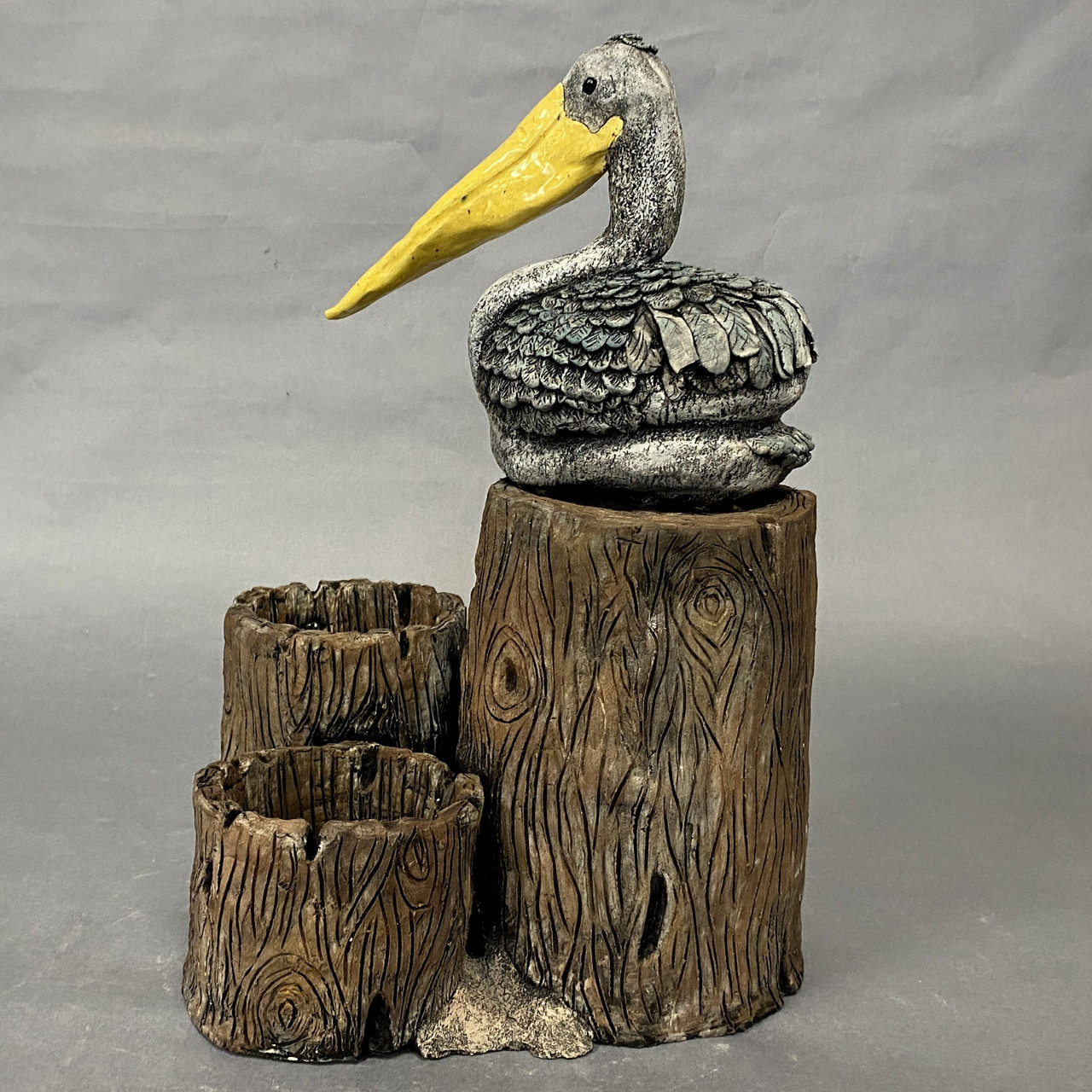
Katelyn Stoffregen, The Pelican, 2025. Clay, Glaze, stain, tools, 15” x 10” x 9.” Liberty High School, OR.
Artist Statement: While creating the pelican piece I wanted it to be very realistic and detailed. I did all of the detailing on my own hand drawn on because I didn’t feel the stencils I had available were realistic enough. I used both techniques of coils and carvings while creating the piece. Then while painting I wanted their to be a part of the project that stood out so I glazed the beak and then stained the rest of the project. I did a black stain wash under the colors so all the details would stand out and then I dry brushed colors on top of black stains to give its color effect.
Axel Weeks

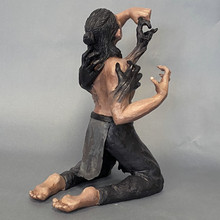
Axel Weeks, III of Swords, 2025. Clay, acrylics, 10” x 7” x 16.” Liberty High School, OR.
Artist Statement: “III of Swords” is a portrayal through an original character that the pain of damaging thought patterns and self-doubts will one day give way to peace if one allows themselves to believe that they deserve that peace and goes through the effort to prove their negative self-talk wrong. The name references a tarot card, the three of swords, which stands for pain, sorrow, and low points as well as the hope that one day things will be better. Meanwhile, the reversed meaning of this card is forgiveness for oneself after having negative thoughts that they believed were true, and the release of pain after difficult times. This figure, who is covered in hands that represent self-doubts and harm, is finally allowing himself to believe that he isn’t the monster that he thinks he is, as shown by him tearing out one of the pain inflicting hands.
Reagan Wakeman
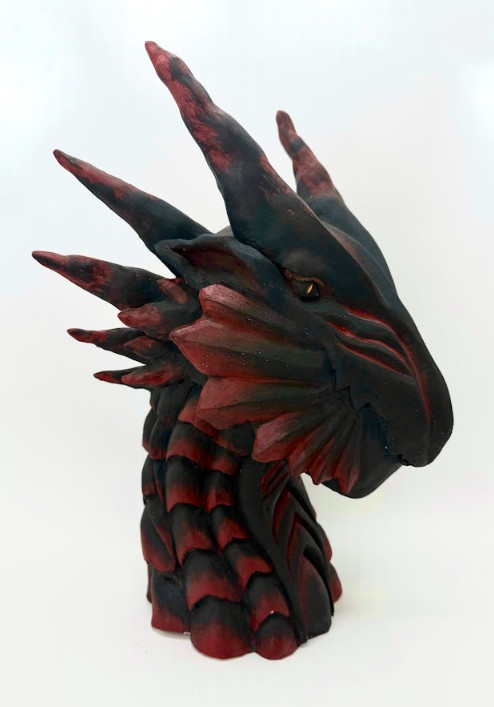
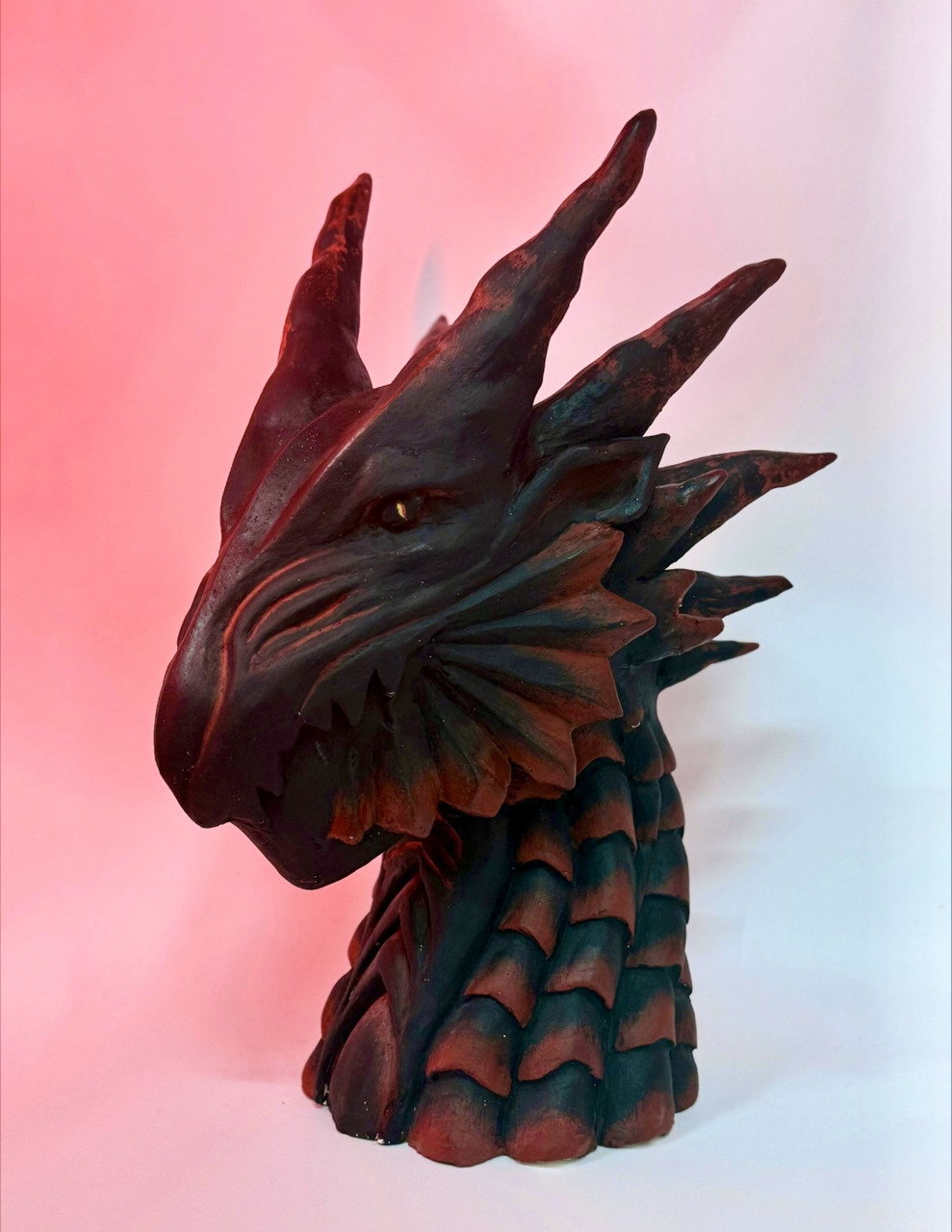
Reagan Wakeman, Obsidian Blaze, 2025. Acrylic on Stoneware, 16” x 9” x 10.5.” Vista Murietta High School, CA.
Artist Statement: From a young age, I have been fascinated by mythical creatures, especially dragons. Their strength, mystery, and power inspire my artwork, and I wanted to bring that energy to life in my ceramic piece. I wanted to capture the power and mystery of these legendary creatures through bold contrasts and intricate details. Throughout the process, I focused on intricate details, from the texture of the scales to the sharpness of the spikes, to make the piece feel alive. Hand-building and sculpting this form challenged me to push my skills, especially in shaping expressive features and capturing movement in a static piece. My teacher and I explored incorporating colored lighting in the product photography to enhance the dramatic mood of the overall piece.
Fengyuan Wu

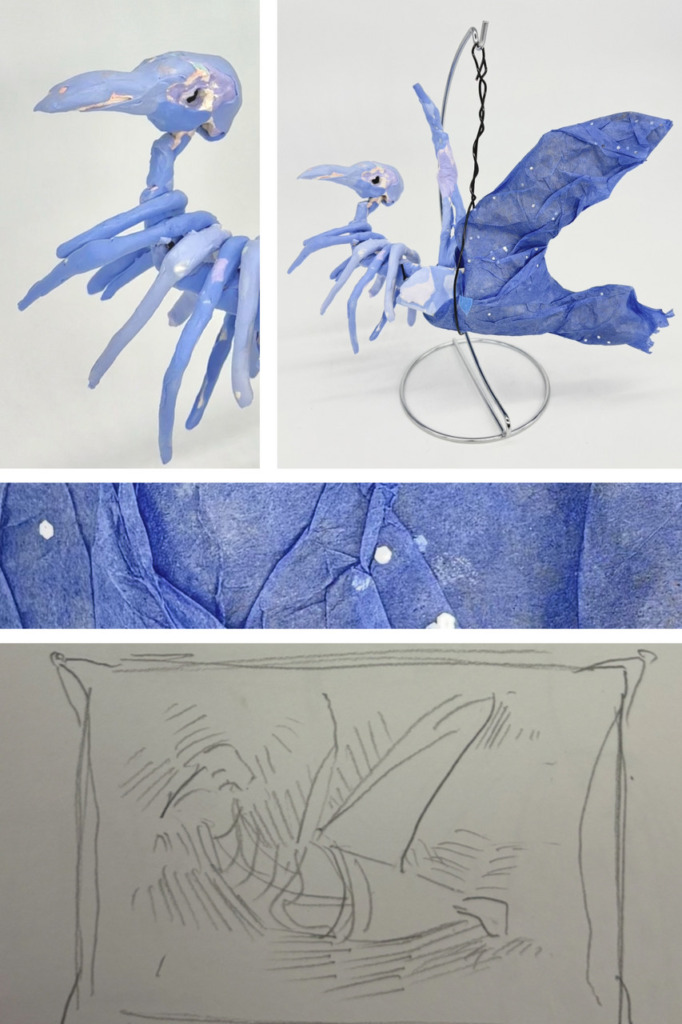
Fenguan Wu, Change is the Extinction of Life, 2025. Ceramic, wire, sulfuric acid paper, light clay, 7.8” x 7.6” x 6.” Lake Washington High School, WA.
Artist Statement: How does nature change fragilely? Many things in the natural environments are fleeting, such as weather, seasons, ecology, and even the extinction of a species. Unlike man-made objects such as plastic, which takes thousands of years to decompose, life is fragile. To explore this question I created a number of works that exercised a sense of vulnerability and natural themes, such as birds with exposed bones, withered lotus leaves, and bleeding rhinos, connects the transformation of time and space with the display of fragility. I used ceramic, wire, sulfuric acid paper, light clay, and glue to made this project. Bones made of clay break easily; blue clay glues them back, while fragile cracks are still visible, not erased. The idea of this work is how fragile life is under the ruthless passage of time. Passenger pigeon’s death body shows the changes in time, and the fragility of life under it.
Thao Yun

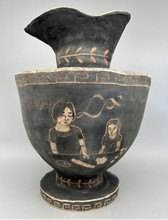
Thao Yun, Grandmothers, 2024. Terracotta Clay, Black underglaze, 16.5” x 12” x 12.” Francis Parker School, CA.
Artist Statement: Why ceramics? Why clay? These are questions I come back to time and time again as I create art and move through the world as an artist. Time and time again I return back to one singular fact: Ceramics is an enduring craft. The material itself doesn’t deteriorate, it doesn’t disintegrate, it doesn’t disappear. Pottery outlives us a thousand lifetimes over. The art that remains tells a story about the artist itself and what was important to its creator and the culture in which it was created. It is a physical legacy. It is immortalized.
That being said…what do I wish to immortalize? Through my art I wish to immortalize the people who shape me, I wish to remember the people I love. That is why I create tributes to my loved ones in ceramics. For example, this piece “Grandmothers” is a terracotta coil built vase with a black graffito surface design I made in 2024. Carved images of my two grandmothers (my Korean Halmoni and my Vietnamese Ba Ngoai) adorn the surface, depicting moments of profound life lessons. Interspersed with the images are lines of original poetry. I chose terracotta and black underglaze to mimic the aesthetics of black and red vases from ancient Greece, further diving into the historic aspect of ceramics. I also chose to carve the images with sgraffito technique and leave the pot unglazed to highlight the rawness of the material itself –it’s supposed to be imperfect, it’s supposed to look like an ancient artifact dug up out of the ruins. One of my major inspirations was LA based ceramicist Roberto Lugo who does a similar thing with his artistic practice. He uses traditional aesthetics and forms to tell modern stories and to reclaim ceramics as an artform and remember the past.
12th Grade
Lynx Adawag
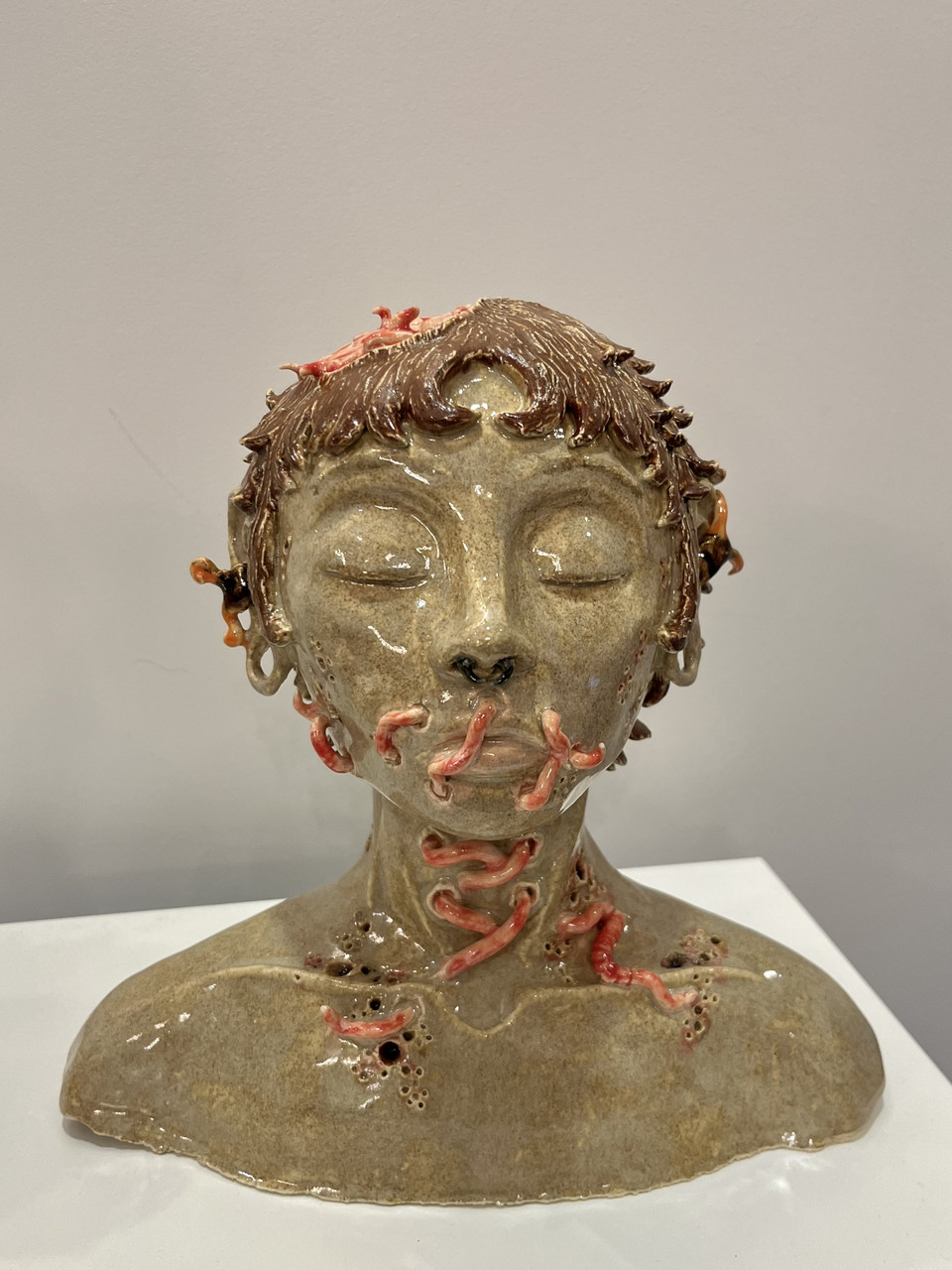
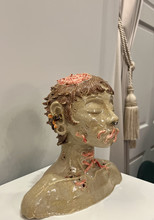
Lynx Adawag, Infestation, 2025. Stoneware, Cone 5 Oxidation, 13″ x 11″ x 5.” El Dorado High School, CA.
Artist Statement: When creating my artwork, I had a vision in which focused on the complexity of human emotions. These included the struggles in attempting to silence inescapable thoughts, and the desire for freedom, peace, and autonomy over oneself. I utilized stoneware clay, techniques such as hand building, and making use of drape molds and an armature to lay a foundation on. These processes allow me the ability to add satisfactory detail to very specific sections within my pieces. Furthering my research, I asked advice from my teacher, used photographic references, and online sculpting videos.
Peyton Alch
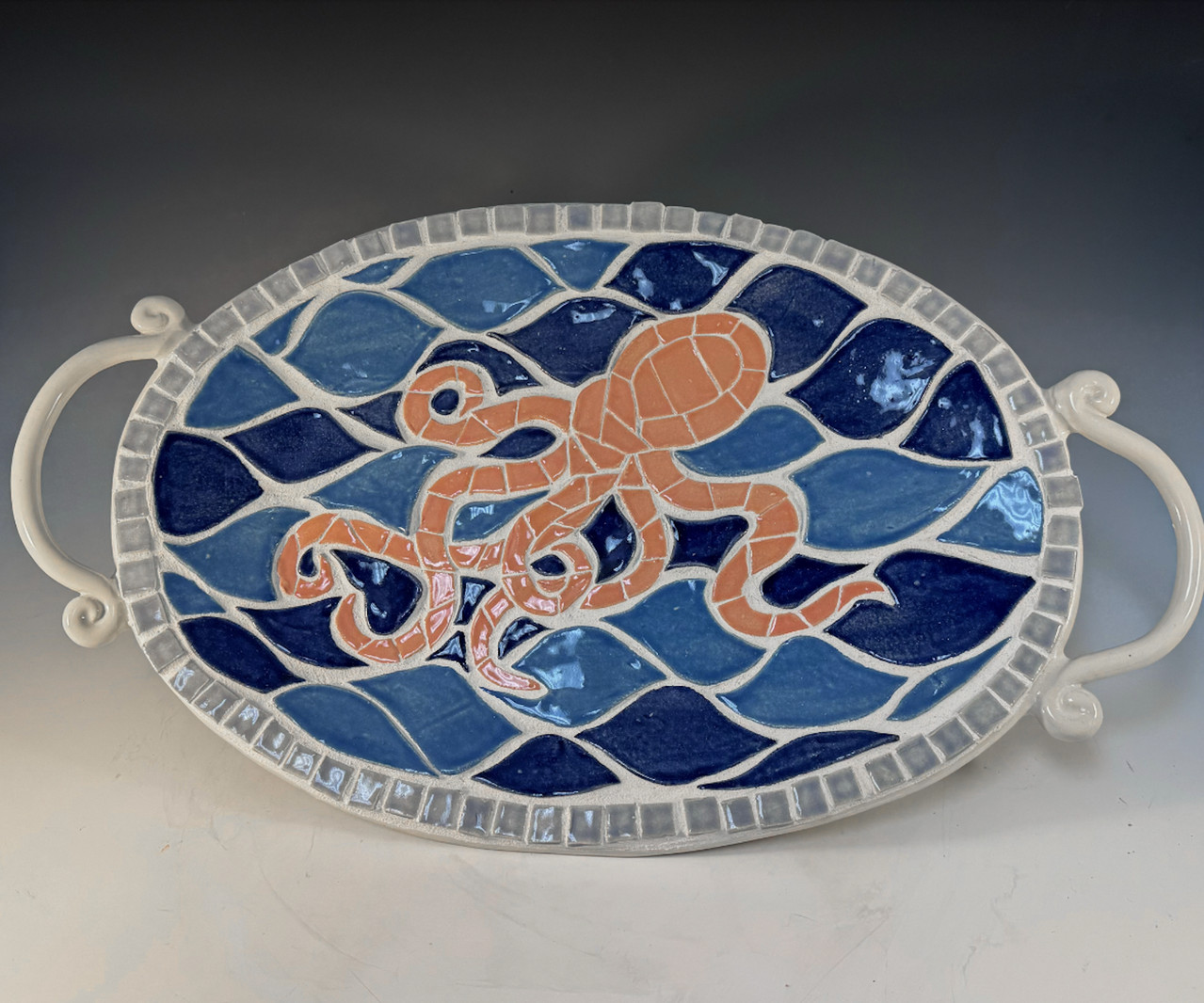
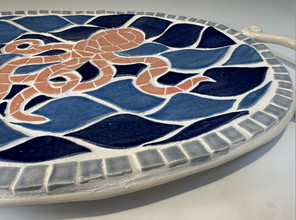
Peyton Alch, Roman Mosaic Platter, 2025. Clay, rib, exacto knife, sponge, grout, underglaze, 1.1” x 11.5” x 19.5.” Trinity Preparatory School, FL.
Artist Statement: I wanted to explore how different cultures use distinctive art styles to express and preserve their traditions and values. Growing up, I didn’t fully understand cultural connections and traditions, but my school trip to Greece sparked a deeper interest. My limited knowledge of my heritage left me with a strong curiosity about the rituals and customs that connect people to their roots. I explored how diverse cultures use art, both functional and symbolic, to express their values and preserve their histories, gaining a deeper understanding of how art shapes cultural identity and continuity. This platter is inspired by the Roman tradition of mosaic art, with an octopus as the central motif. The small pieces forming the octopus contrast with the larger ocean tiles surrounding it, highlighting the complexity and intricate detail of the technique. To construct this piece, I treated it like a traditional mosaic, using grout to secure the pieces to the platter.
Ayla Bickel
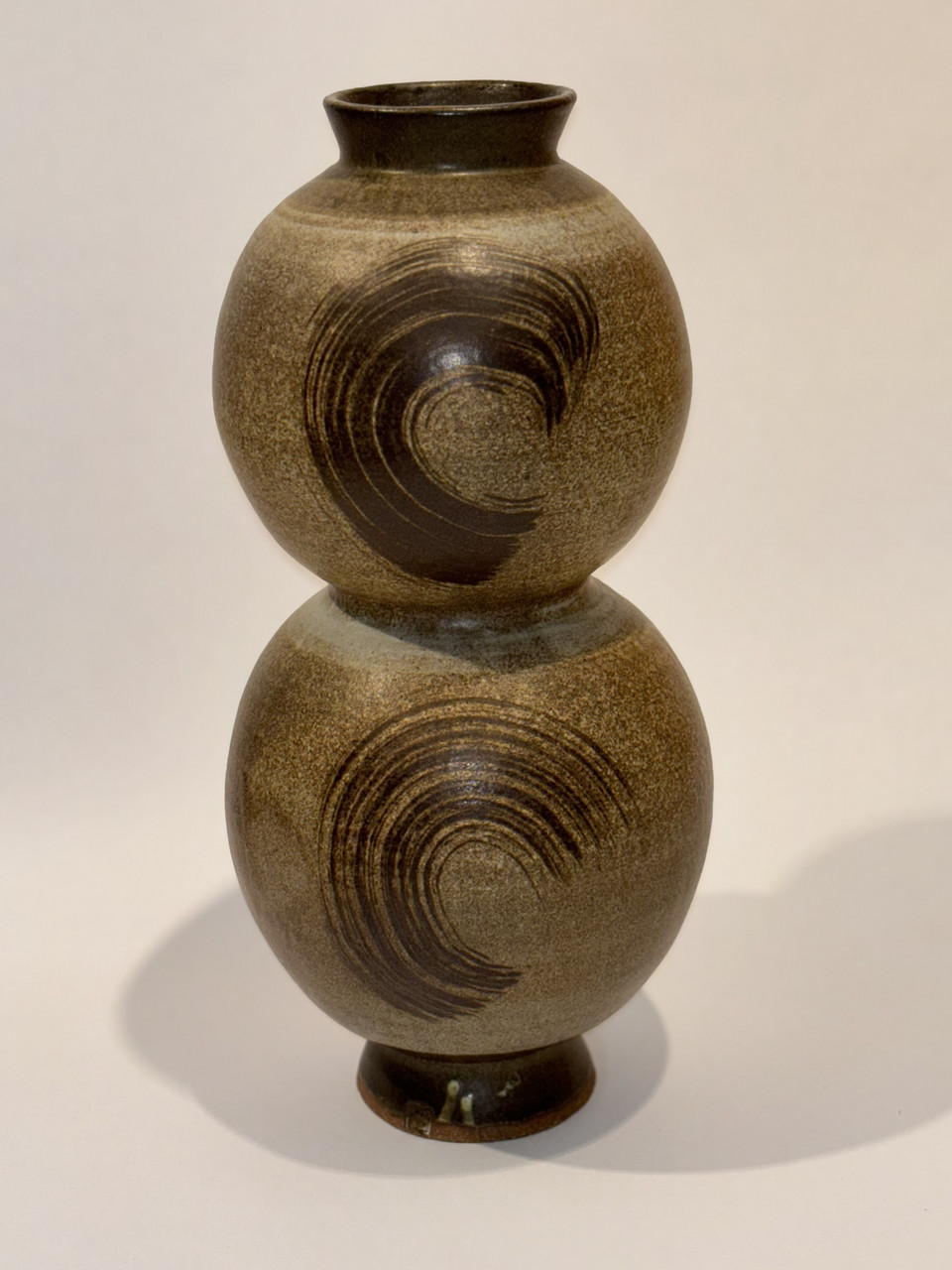
Ayla Bickel, Bubble Vase, 2025. High Fire Stoneware, 15” x 8” x 8,” Huntington Beach High School, CA.
Artist Statement: I made the bubble vase because I was inspired by mid-century American pottery and I wanted to try doing something like that for myself. I added the brush strokes to add balance to my piece.
Evelyn Castillo Lopez
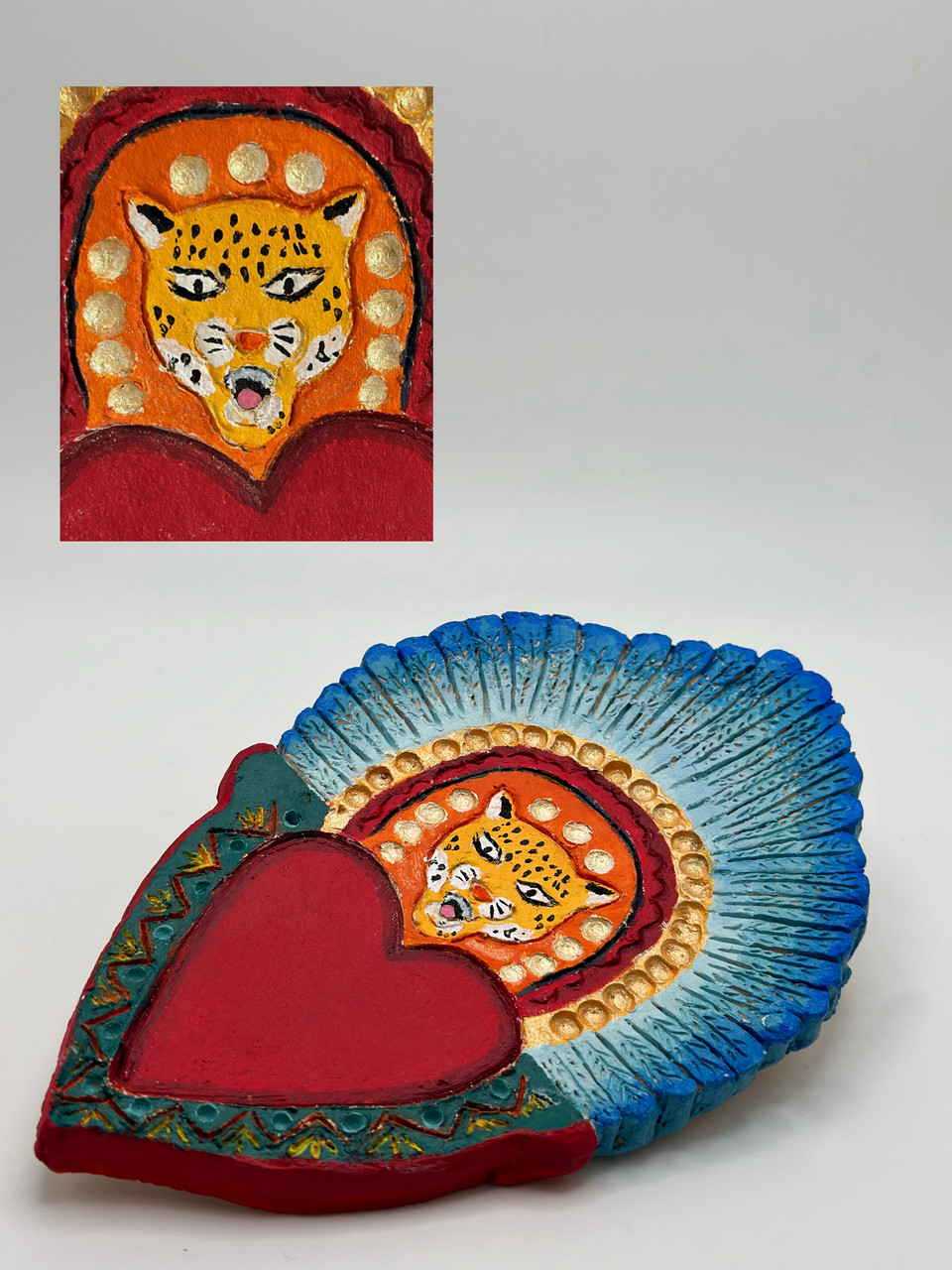
Evelyn Castillo Lopez, Untitled, 2024. Cone 06 ceramics, Acrylic paint, 7” x 5” x 1.5.” Laguna Beach High School, CA.
Artist Statement: Growing up in Laguna Beach, a predominantly white community, I often felt a sense of embarrassment about my heritage and where I came from. This internal conflict sparked a deep desire within me to explore and embrace my cultural roots through my art. My art focuses on Mexican folk art that changes along the many different states. With my art, I try to honor my parents and make them proud.
Adrian Chau
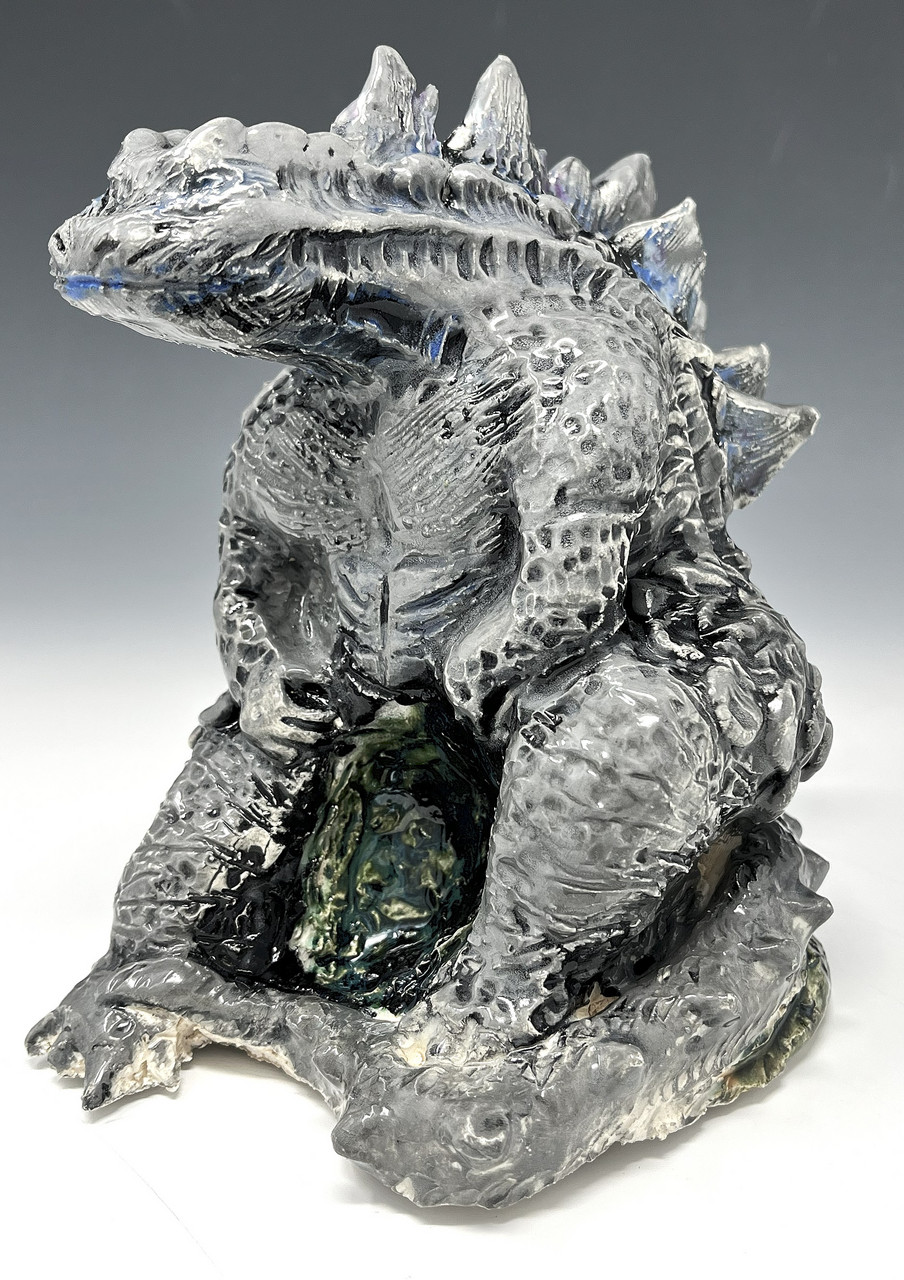
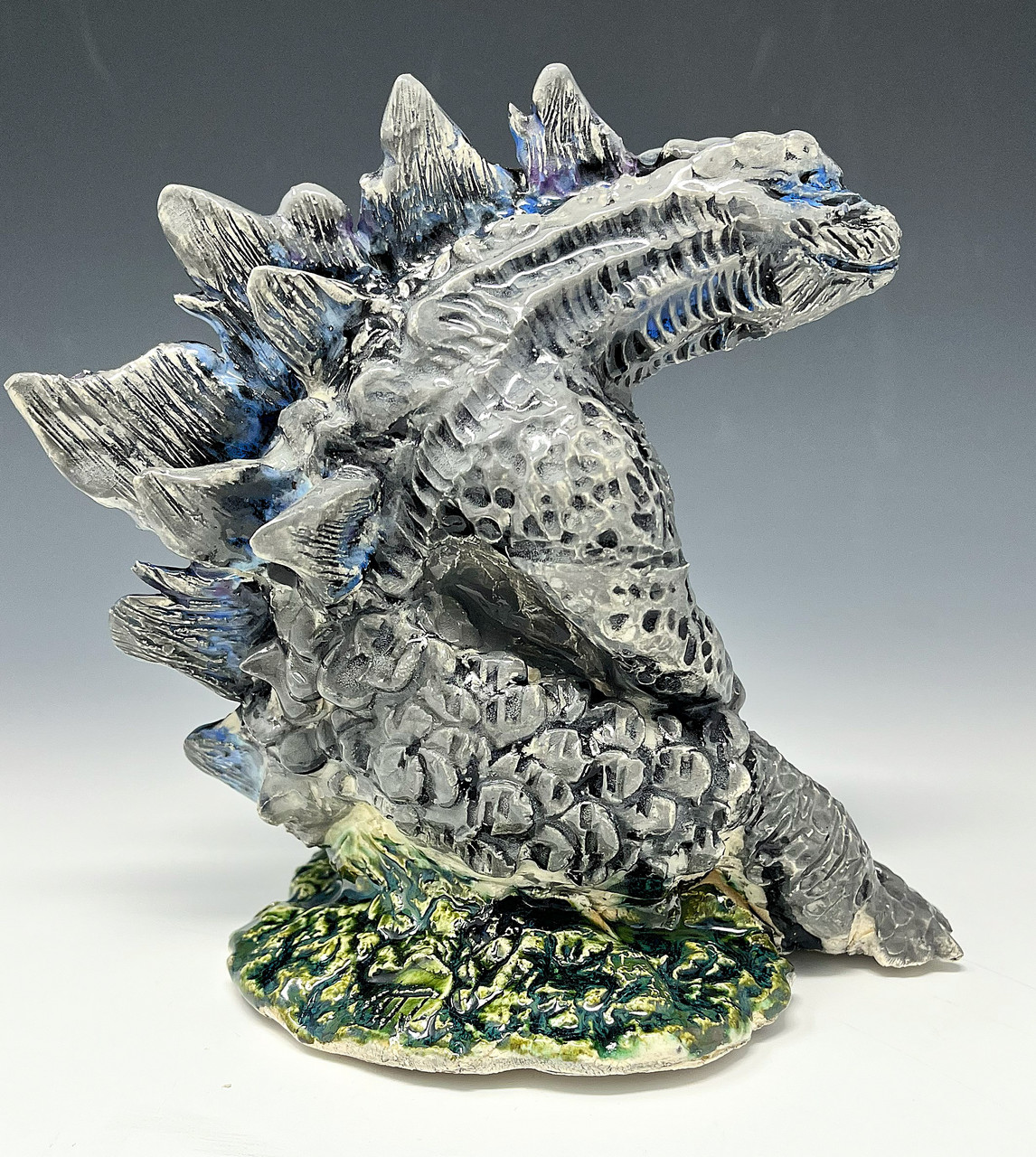
Adrian Chau, Godzilla on a Monday Morning, 2025. B-mix Clay, Low Fire Glazes, 8” x 4” x 4.” Maria Carrillo High School, CA.
Artist Statement: I was drawn to the contrast between dynamic narratives, and introspective, quiet moments. The Godzilla statue is a reimagining of the monster icon, depicting him not in his usual city-destroying rampage, but instead in a relaxed, calm pose. I had Godzilla remaining stationary, almost looking sleepy, which sets up an interesting juxtaposition with the typical image of him wreaking havoc on cities. The juxtaposition of the usual chaos and the relaxed stance invites viewers to see the character in a new way and to think about the possibility for stillness and vulnerability, even in such a powerful character. To achieve this, I used muted colors to give Godzilla a tired, gentle demeanor, cultivating soft yet earthy energy through the sculpting process. I experimented with a layered glaze to impart a feeling of texture and depth, a subtle contrast to the otherwise crude figure. In this work, I tried to tackle the ideas of strength, vulnerability, and surprise. I wanted to draw viewers into a new narrative, encouraging them to look at familiar subjects in an emotional way, while allowing myself the freedom and uncertainty of ceramics as a medium.
With ceramics, I focus on incorporating art into people’s everyday lives by creating functional pieces and sculptures altered through glazing, trimming, and sculpting techniques such as chattering. A major motif in my work is the blending of traditional styles. Many of my pieces draw inspiration from various cultures — ranging from traditional Chinese porcelain to modern darting. In addition, my biggest strength as an artist is that I am not afraid to “ruin” pieces. Overall, my goal as an artist is to display my art in the effort to inspire viewers to take risks in their everyday lives.
Joyce Gorbunov
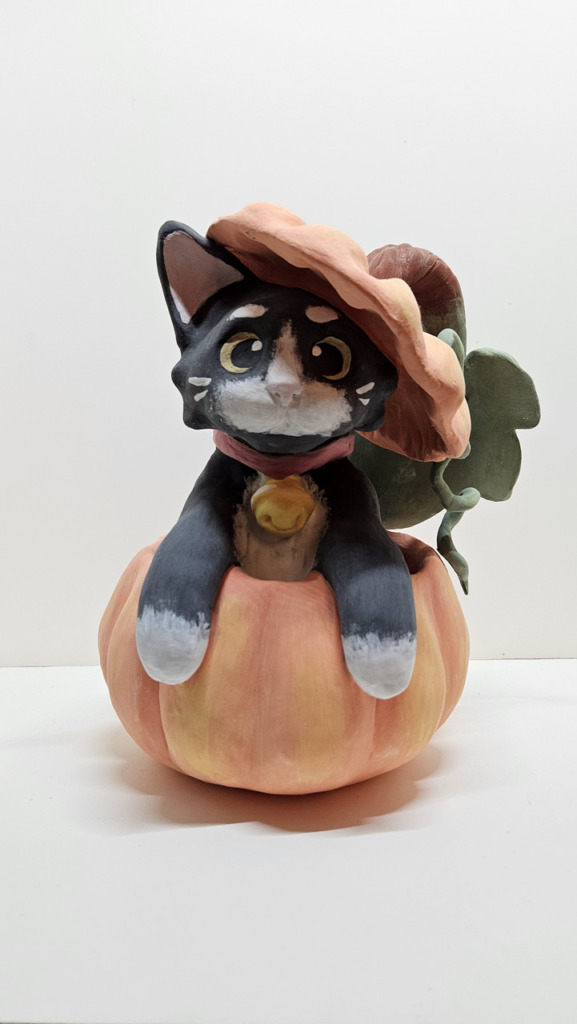
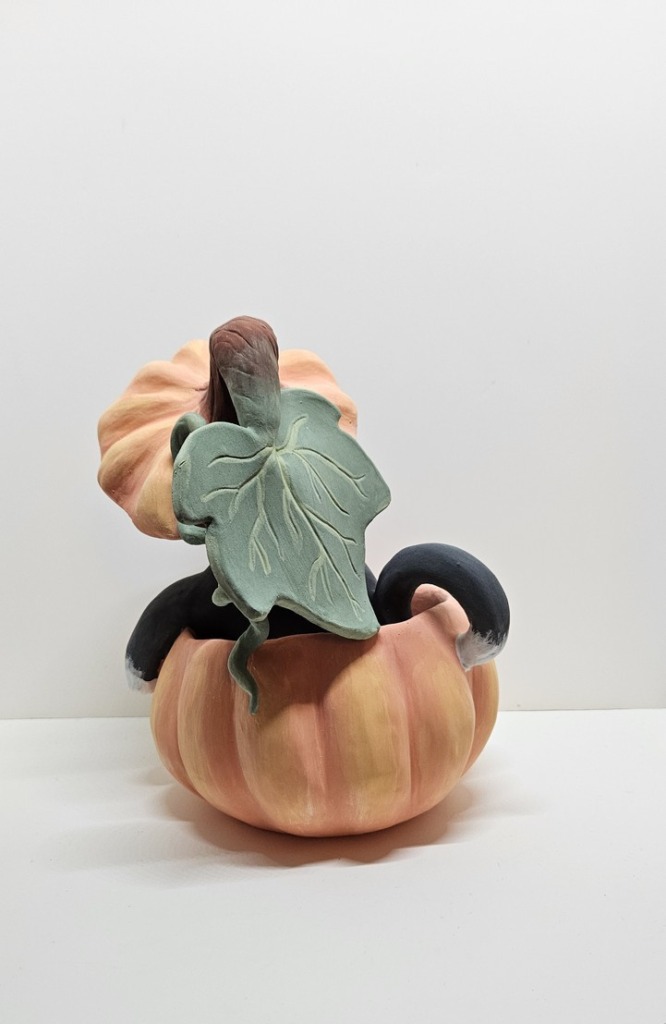
Joyce Gorbunov, Fall Festivity, 2024. Ceramic, underglaze, 9” x 7” x 8.” Post Falls High School, ID.
Artist Statement: I wanted to represent fall through creating a pumpkin with a cat inside. I chose to color the cat within the pumpkin black and white because I wanted to separate it from the holiday Halloween. I wanted the piece to give more of an autumn vibe rather than a spooky Halloween decoration. I created this piece as a hollowed form. I first started with a chunk of clay which I molded into a large pinch pot. I worked the pinch pot into my desired shapes in order to form a cat-like body and pumpkin. I let it dry slightly before hollowing it out and attaching all the pieces together to complete the overall look.
Jack Green
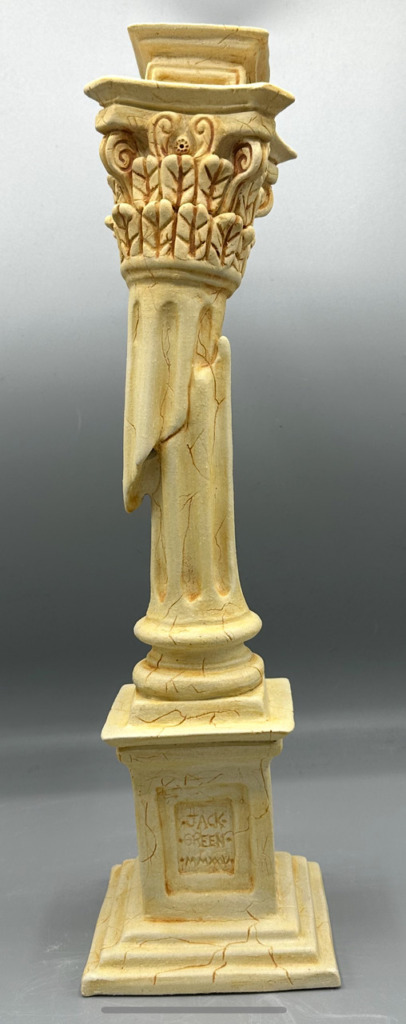
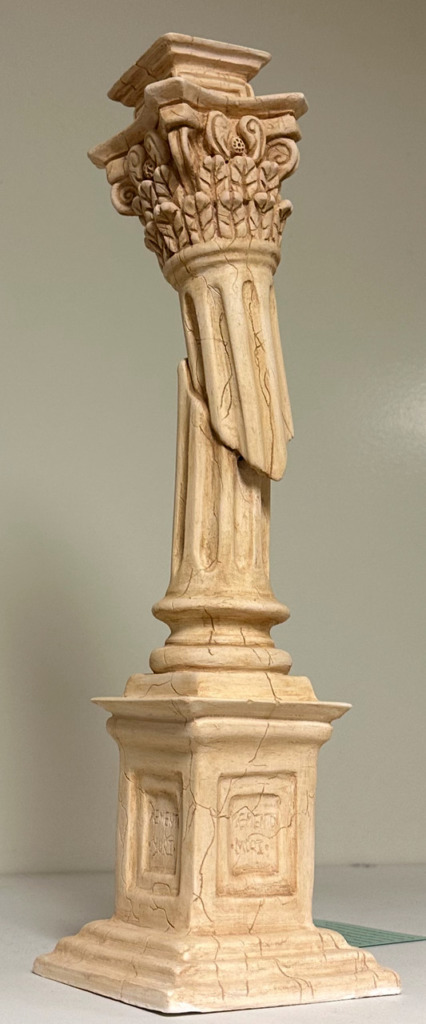
Jack Green, The Fall, 2025. Ceramic with rutile stain, 14” x 5” x 5.” Carlmont High School, CA.
Artist Statement: I made this for a sculpture project in my ceramics class that was supposed to convey the idea of movement. I am very interested in architecture and modeled my sculpture on a classical column. My idea was to show movement by making the top of the column look like it is collapsing and falling from its base. I used slabs to build most of the sculpture and stained it with Rutile to make it look weathered.
Miles Grumbs
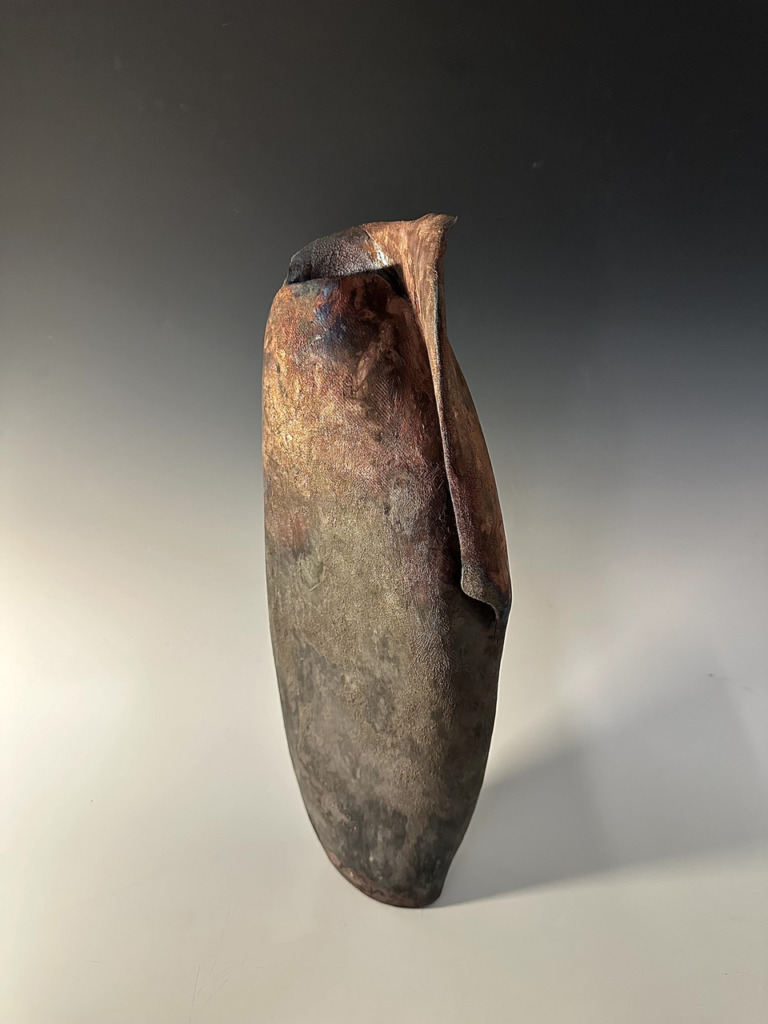
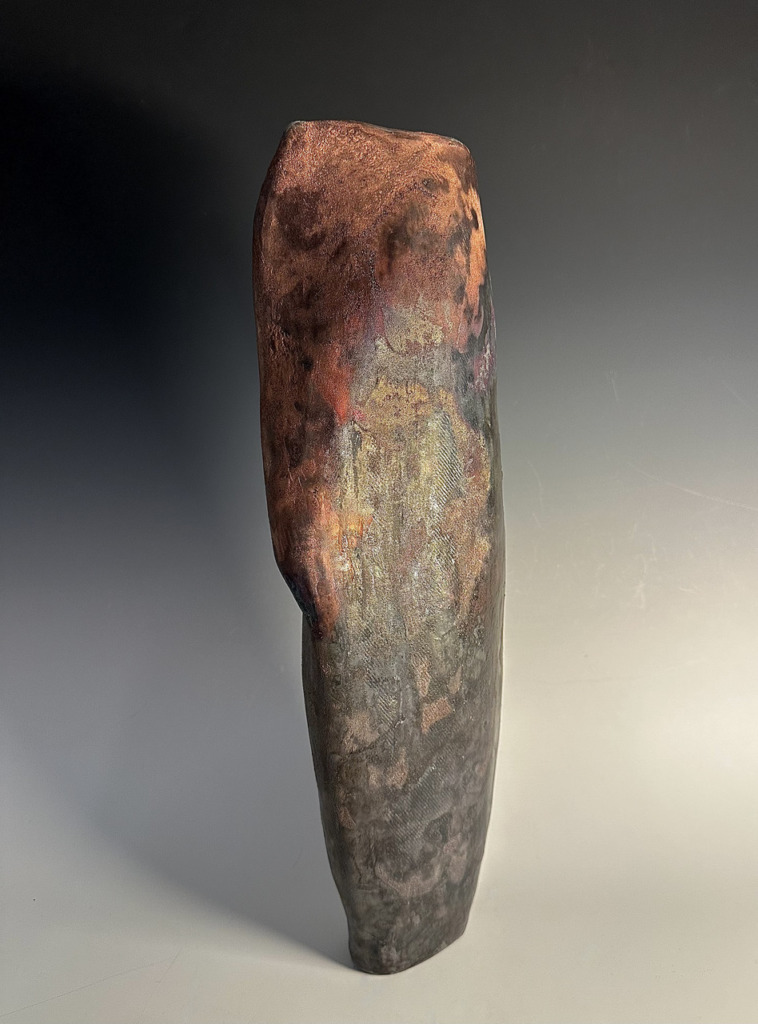
Miles Grumbs, Winged Raku Vase, 2024. White stoneware, Copper matte glaze, 17” x 6.5” x 3.” The Dalton School, NY.
Artist Statement: This hand-built raku vase was created by joining three slabs of white stoneware (two walls and one base). The wing-like feature at the top of the vase was an intentional extension of one of the side slabs. This wing added both mechanical and compositional balance to the piece. The copper matte glaze was researched and created by the artist in the studio. Flashing greens, blues, and reds over the metallic copper were formed during the glaze’s reduction phase that resulted from combusted hay and flames licking the sides of the vase in a closed bucket deprived of oxygen.
Aspen Hernandez-Mendoza
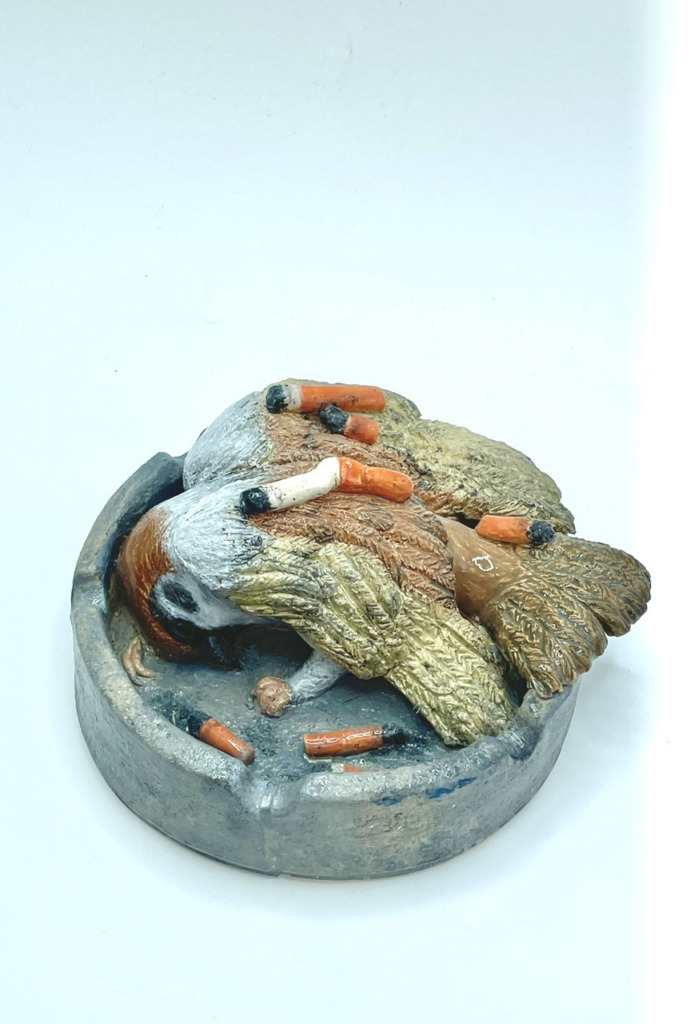
Aspen Hernandez-Mendoza, Secondhand, 2024. Ceramic Stoneware, Stroke and Coat, Acrylic, 6” x 6” x 3.” Vista Murrieta High School, CA.
Artist Statement: The piece ‘Secondhand’ is a metaphor for substance abuse. A sparrow lies in exhaustion on an ash-tray that is burnished to mimic the appearance of a dirty public sidewalk. The exhausted sparrow represents the unforeseen negative effects substance abuse can have on yourself and those around you.
Kiya Herrera
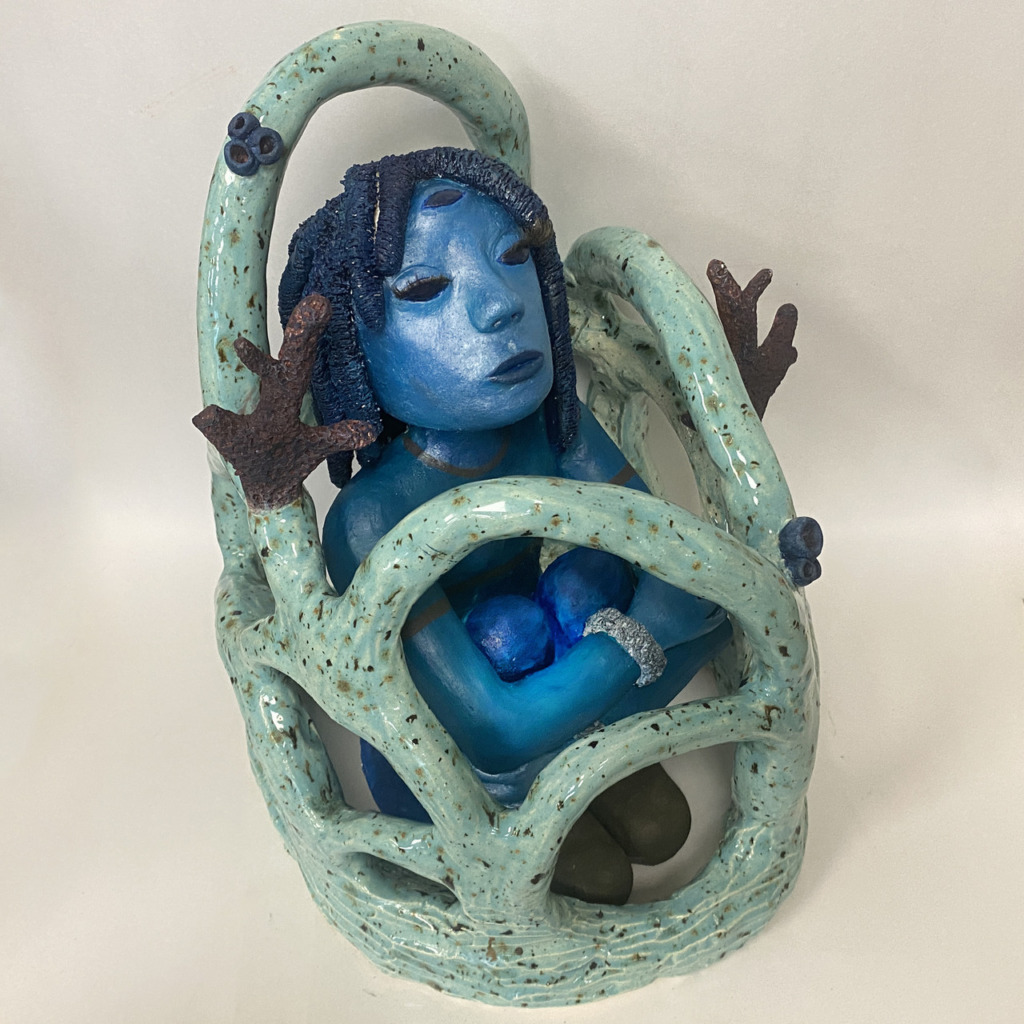
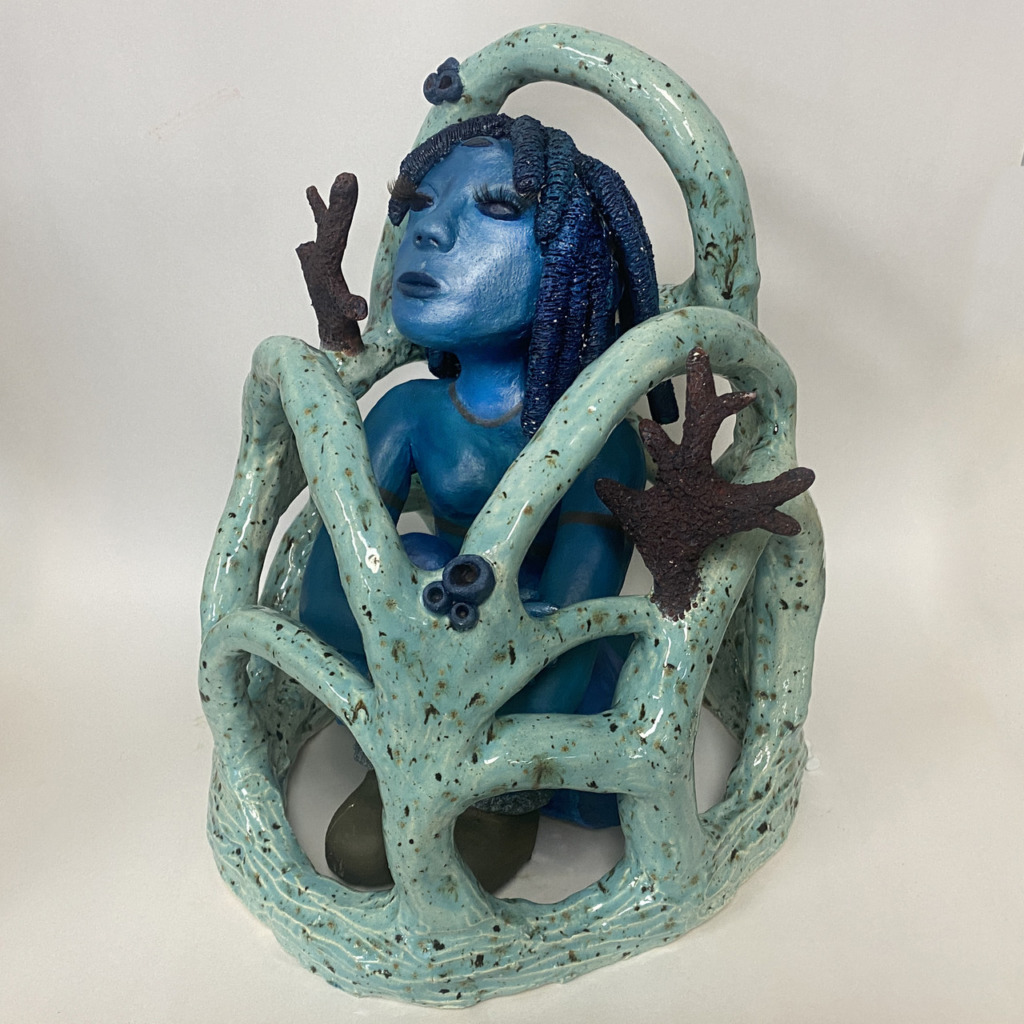
Kiya Herrera, the caged girl, 2024. Ceramic, 12” x 7” x 7.” Liberty High School, OR.
Artist Statement: I wanted to make a stylized piece that also incorporated an abstract element. I wanted it to have a sea like theme but not be generic, I looked for images that represented my idea and meshed the concepts to create something I’m truly proud of. I used thick coils to create and cage. I built the girl solid then carved the clay out and added details. I used glaze for the cage and acrylic paint for the girl and coral. I worked hard on this piece and really enjoyed what I created. I wanted it to have a sea like theme without being too obvious and wanted to challenge myself to mesh abstract and stylized forms.
Gavin Koffski
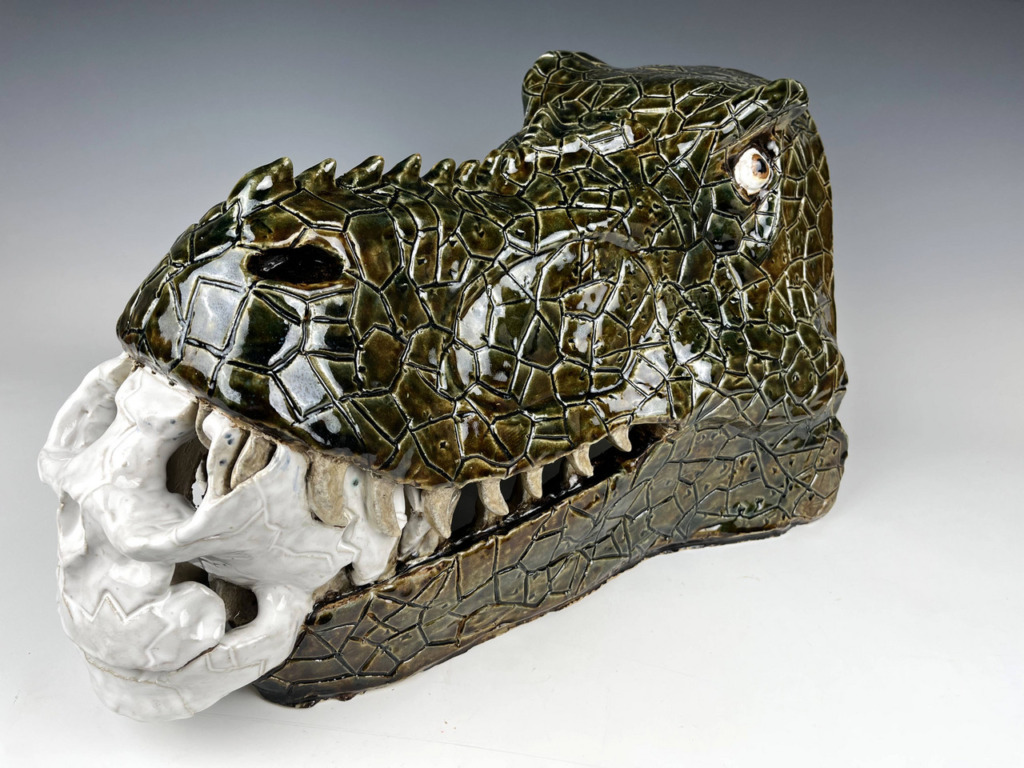
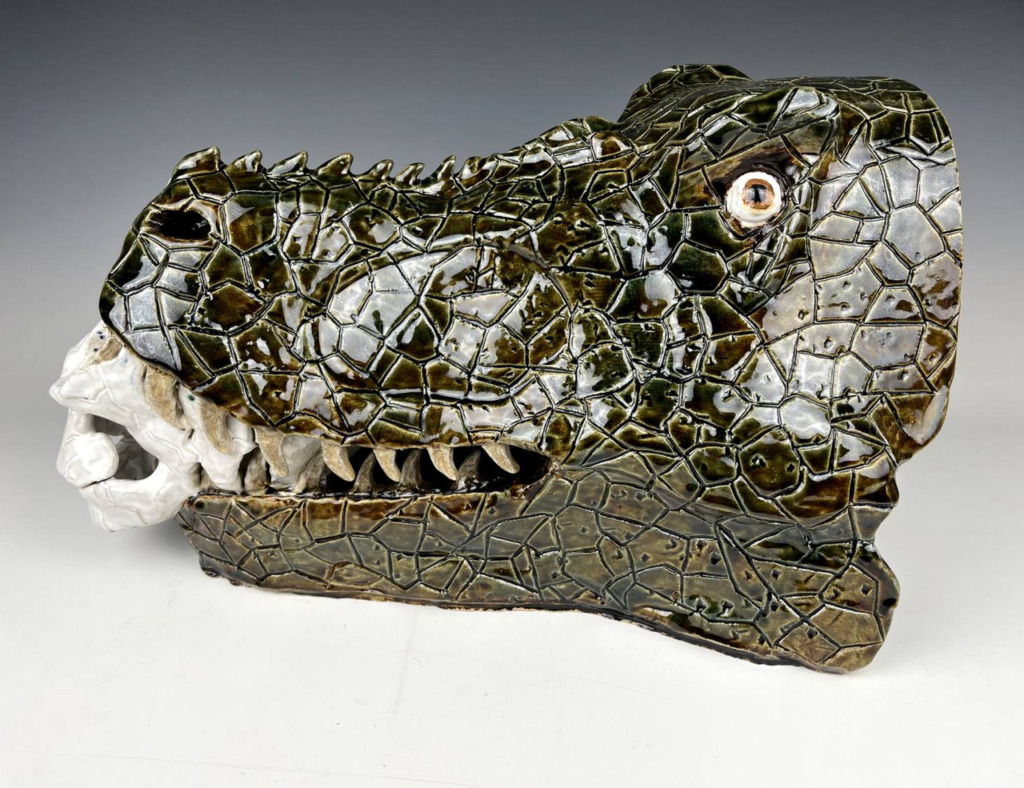
Gavin Koffski, Ted the T-rex, 2025. Clay, glaze, ribbon tool, rib, sponge, razor blade, 20” x 11.5” x 12.” Osseo Senior High School, MN.
Artist Statement: For this piece, I wanted to capture the look and feel of a real dinosaur skull while also making something unique. I’ve always been interested in prehistoric creatures, so I researched different dinosaur fossils to get an idea of the bone structure and details. I first drew a sketch of the head on paper, then I took a block of clay and cut it down the long way. Then I split that down the middle for the bottom jaw. Then I took bisque prices and put it in the middle. To support the top, I rolled out clay with a rolling pin to make the upper jaw and shape it close to how I wanted it. Then I added the facial features like the eyes and spikes on the head and teeth, then I took a tracing roller thing to mark where I wanted to carve the scales in the head. For the human skull in its mouth, I threw 2 bowls and slipped and scored them together, then sculpted the face and used the head for support for the upper jaw. Then I glazed it with 5 different glazes. This project was a great way to combine my interest in science and art. I learned a lot about sculpting techniques and how to make ceramics look aged and natural. My goal was to create something that feels like a real piece of history, and I’m really happy with how it turned out.
Clarissa Gil
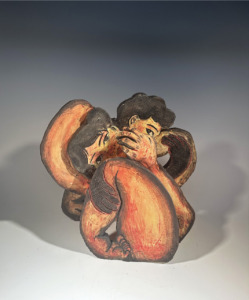
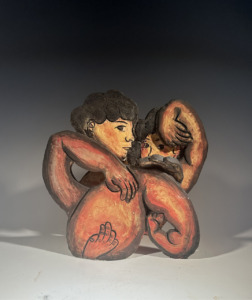
Alexandra Liu, Internal Conversation, 2024. Hopkin’s white clay, underglaze. 14.5” x 15” x 6.” Harvard-Westlake School, CA.
Artist Statement: My creative process begins with examining a personal feeling or experience as a Chinese American woman, researching traditional Chinese forms and techniques to subvert as designs, and selecting a variety of mediums, materials, colors, and finishes. I often superimpose 2D imagery through drawing, painting, and carving onto 3D forms to convey transformation and movement in the pieces. i experiment with an object’s form and function to create sculptures narrating movement and transformation and how they apply to the thematic question of women’s agency in the context of the Chinese American experience. Do individuals truly have a choice in their becoming given the assumption and expectations of family, culture, and society? I am documenting the often confusing feelings and cultural challenges faced by Chinese American women growing up, and in doing so, I am providing an alternative narrative to media stereotypes that often demand Asian women become dehumanized as dolls and robots. I throw large vessels and modify them by twisting and cutting out sections and adding sculpted hands, feet, and hair. This process of reflection has allowed me to not only claim my Chinese heritage but also to accept my American roots. Moreover, I realize that self-image is fluid and changes with personal experiences. I strive to express my authentic but evolving sense of self, and my art celebrates who I am and the women in my family.
Cara Mortimer
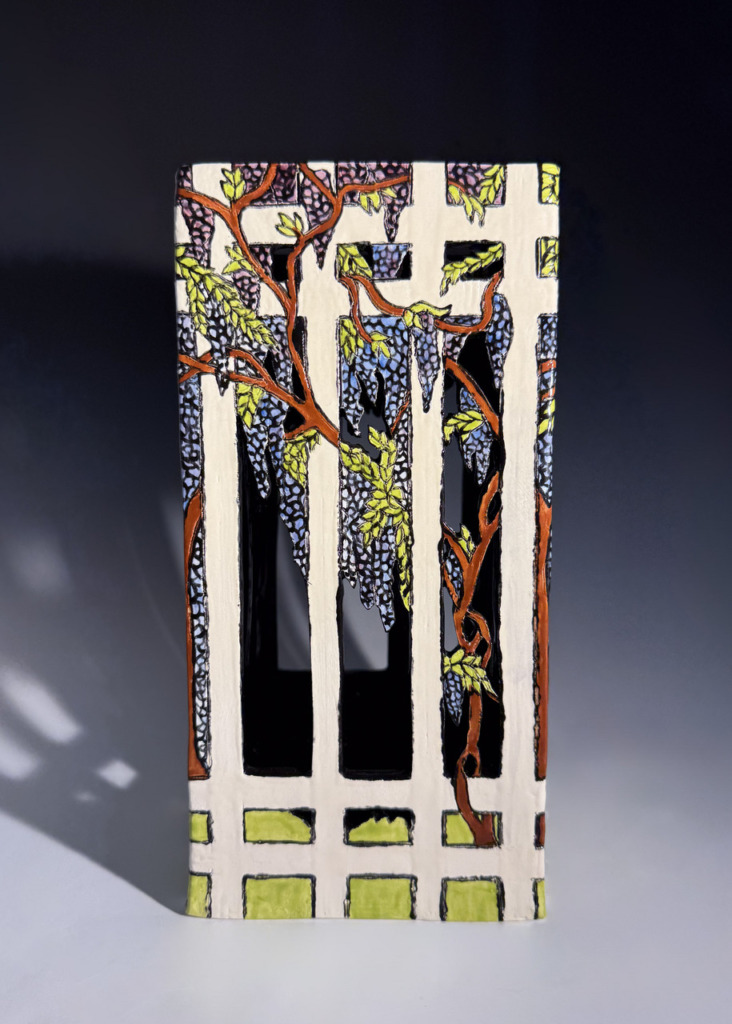
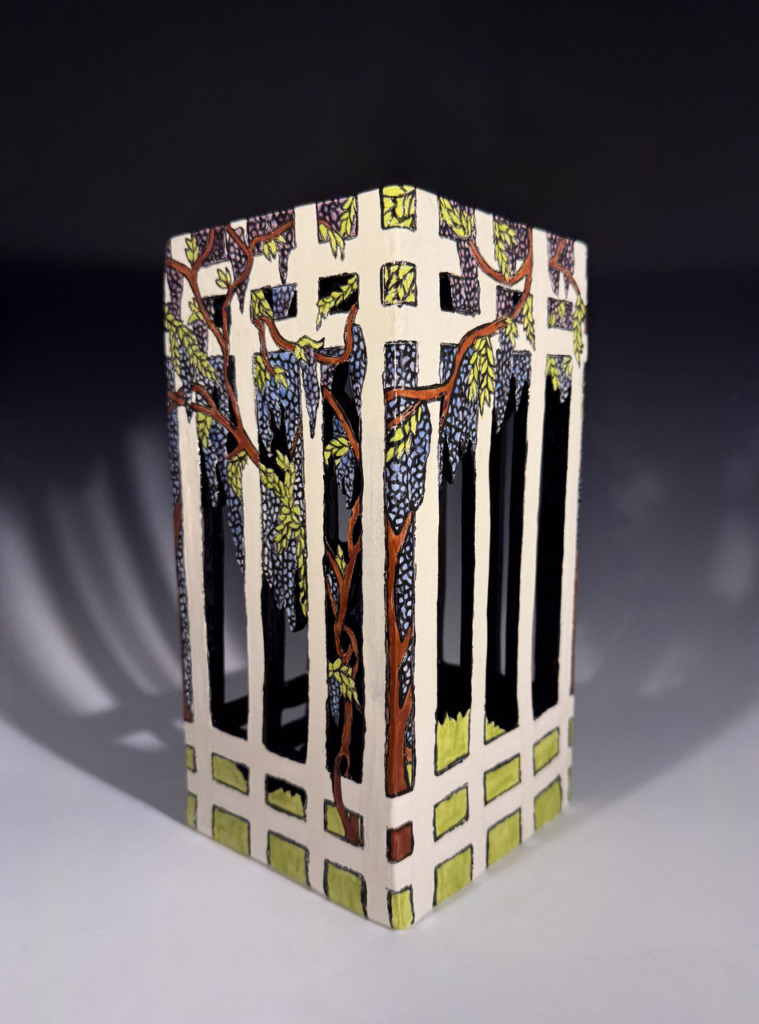
Cara Mortimer, Wisteria, 2025. Stoneware, underglaze. 5″ x 5.25″ x 8.25.” Trinity Preparatory School, FL.
Artist Statement: I have always loved stained glass works, especially those found in my local art museum. These pieces, by Louis Comfort Tiffany, invoked a sense of serenity and beauty, making the atmosphere at the Morse museum stand out to me. My work began as a study of how I can create a stained glass effect using solely stoneware clay, inspired by Tiffany’s works. I was directly inspired by the Door panels, the ‘Wisteria’ Transom window, and the Field of Lilies window. Door panels is the first work of art one sees when entering the Morse museum, and it features a trellis covered in autumnal fruits and pumpkins at the bottom edges. The ‘Wisteria’ Transom is a stained glass window from Tiffany’s personal dining room depicting a blue and purple wisteria vine. These two pieces inspired me to choose the subject of a wisteria climbing on a trellis for my vase. While I have worked with stained glass before, my preferred medium is clay. I experimented with blending colors and in my vase, using cutouts to create a translucent effect using an opaque medium. Through revision, I was able to develop a glazing process for detailed designs by switching from underglaze to stoke and coat. With practice, using darker colors in combination with brighter ones, I achieved the glowing contrast seen in many of Tiffany’s pieces, specifically the Field of Lilies window. In this window, the lilies seem to glow due to their bright white petals contrasting with the navy and purple background, something that inspired the color schemes of both my pieces. To achieve a stained glass look and to add to the contrast of light and dark, I used black underglaze to outline my designs to look like black solder. Floral designs, the preferred subject of both Tiffany and I, were used to invoke a sense of beauty and tranquility.
Estefany Vazquez Saldana
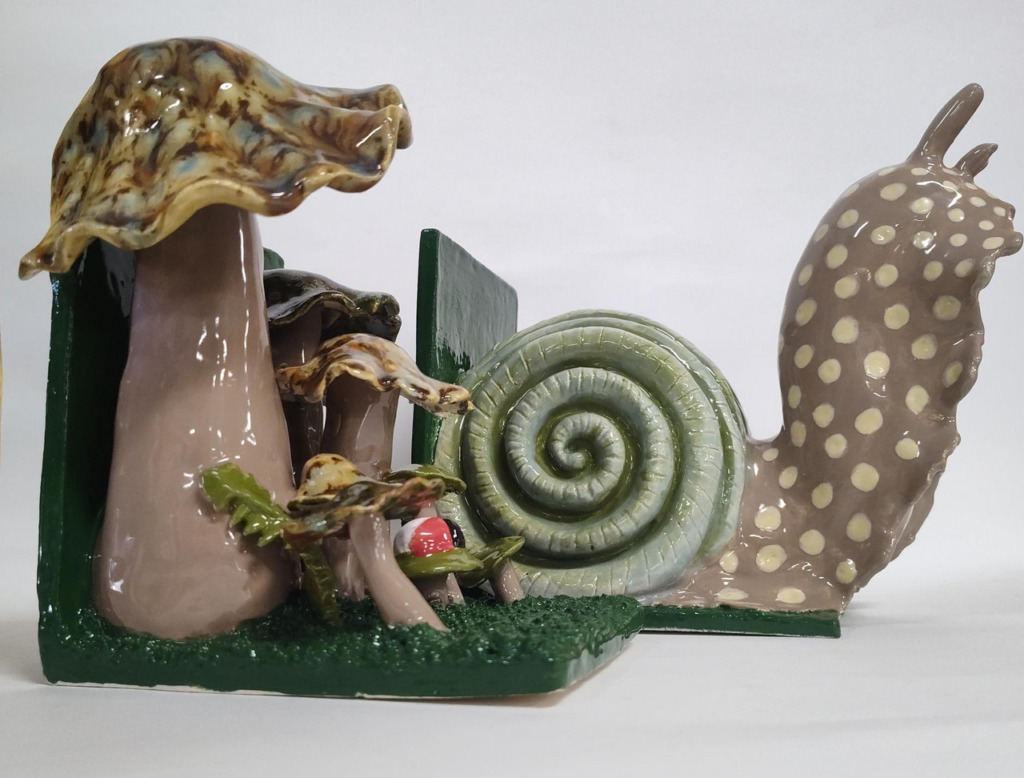
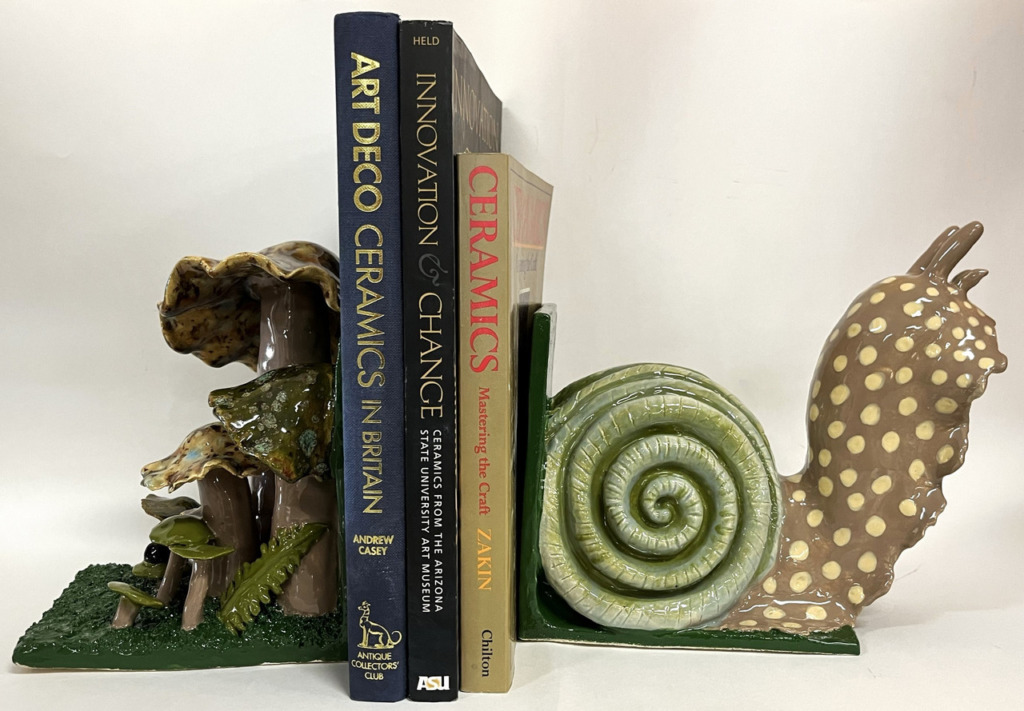
Estefany Vazquez Saldana, Enchanted Forest, 2025. Ceramic, stoneware, 9” x 15.” Copper Canyon High School, AZ.
Artist Statement: For my bookends project, I chose a forest and mushroom theme with lots of greenery and creatures. My first bookend features a variety of mushrooms, plants, and a little bug, all placed together to create unity and a natural aspect of a forest scene. The second bookend is a large snail with a green shell and polka dots covering its body, making it look unique and fun. For this project, I used clay to carefully sculpt every detail as promising as I could and making sure that every shape was consistent. I used a variety of slab and coil methods to construct each end. After the clay dried and was fired, I applied different glaze colors to give the bookends bright and natural colors. The greens, red, and browns helped make the pieces stand out and seem more realistic. I also made sure to add some sort of texture to the shell of the snail and grass to give them an extra more of a realistic touch. It took me a lot of time and effort to complete the bookends because I had to carefully shape the details, wait for the clay to dry, use the kiln to fire the pieces before finally being able to glaze them, and finally have the final products. Throughout the process of my bookends, I made sure to use different tools like carving knives, rib tools, and sponges to smooth out rough edges so far with many other materials. My inspiration came from nature, especially the small creatures that live among plants and mushrooms in forests. The aspect of bugs and snails were a greater inspiration as they remind me of my childhood, when me and my family used to collect them to admire their beauty. These bookends are not only decorative but useful, as they help hold books in place while adding a diversity of color and fun, and natural touch to any shelf. The process of making them was both fun and challenging, together with some memorable memories of my infancy.
Michelle Schnathorst
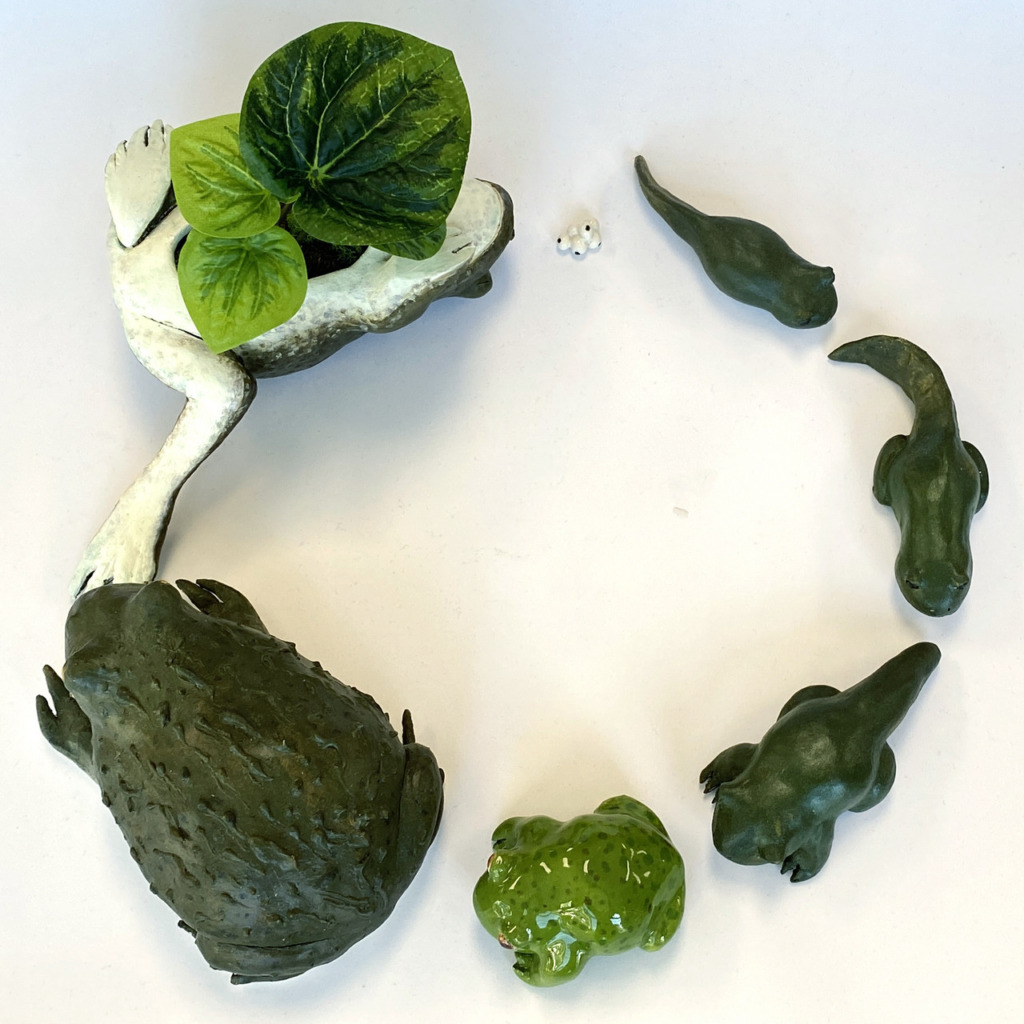
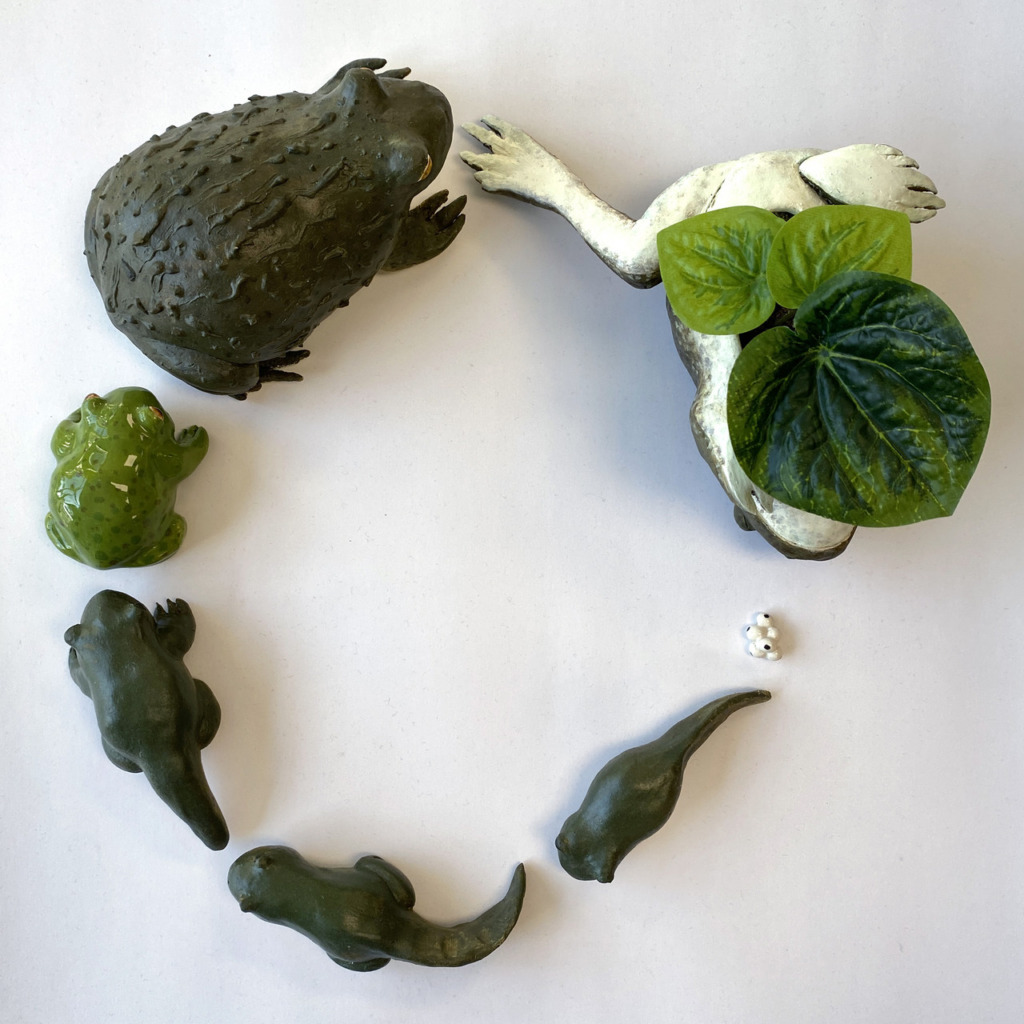
Michelle Schnathorst, Anura, 2025. Clay, Acrylic paint, dirt, plastic plant, 3” x 6” x 13.” Liberty High School, OR.
Artist Statement: For this piece I wanted to show an accurate life cycle of a frog starting at an egg and going all the way to death. For this project I used gray clay and sculpting and detailing tools in order to get the frogs as close to their alive counterparts. I did research on the size of the frogs and the life cycle of the frogs starting with the eggs then to tadpoles to froglets, adult frogs then dying.
Benjamin Schroeder
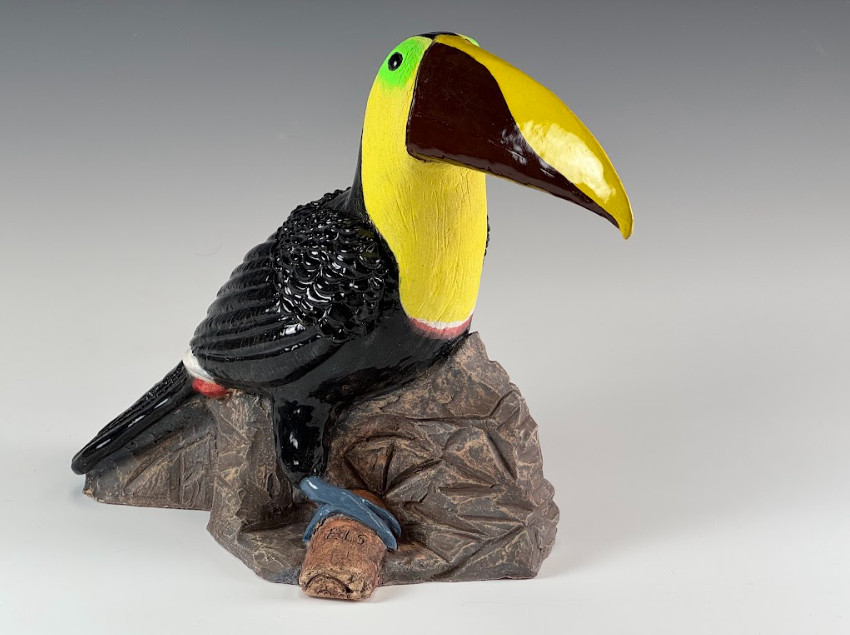
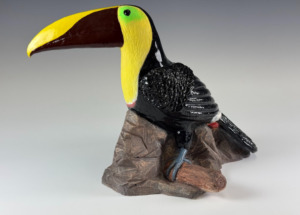
Benjamin Schroeder, Toucan, 2025. Clay, Underglaze, Clear glaze, Rust iron oxide, 11” x 4.5” x 8.” El Toro High School, CA.
Artist Statement: I chose to make a chestnut-mandibled toucan because 1) toucans are my favorite bird, and 2) because during my family’s last trip to Costa Rica we had a pair of these toucans make a nest in one of the trees on our property. I spent a lot of time photographing these toucans, as well as others in the area (among other wildlife). I got a lot of good pictures and used a few of them as references while making my sculpture. As this is my first year ever taking ceramics, or even doing ceramics for that matter, I made sure to ask my teacher plenty of questions both on how to do/make certain parts and what colors and other design elements would help improve my sculpture.
Stefany Sedra
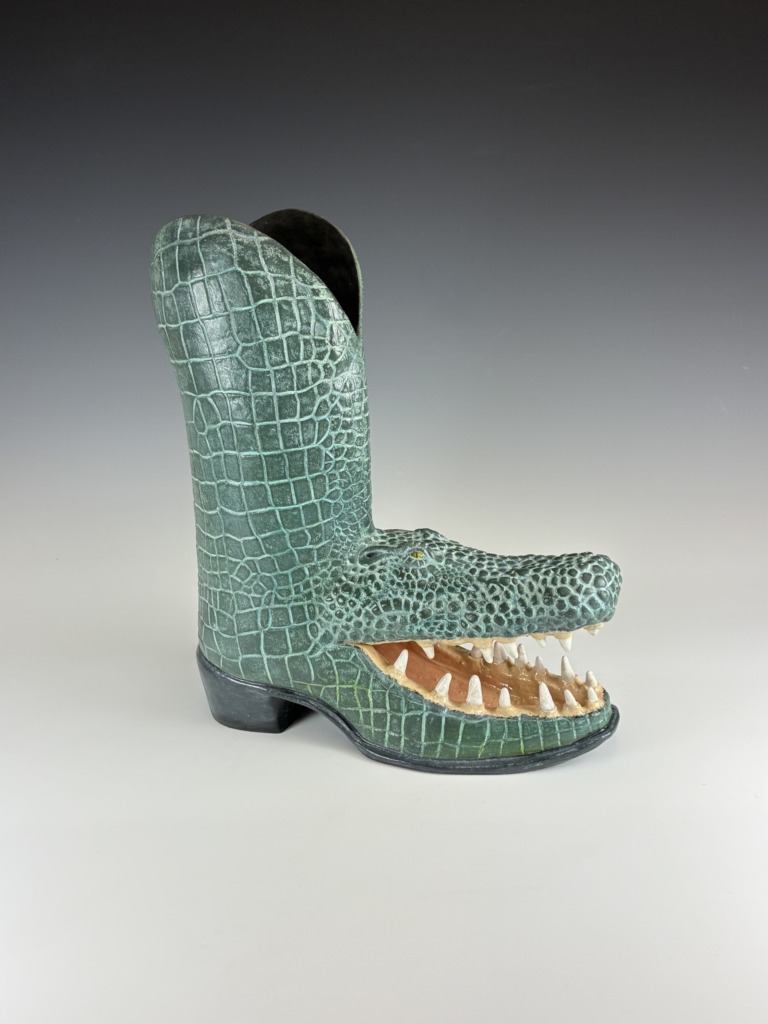
Stefany Sedra, Crocboy Boot, 2025. Ceramic, glaze. 13” x 4” x 11.” El Toro High School, CA.
Artist Statement: This artwork merges a cowboy boot with a crocodile head, creating a surreal and thought-provoking piece that explores the relationship between fashion and nature. The design may comment on the use of exotic animal skins in luxury fashion or playfully reimagine everyday objects. The detailed texture, sculpted scales, and carefully crafted teeth enhance realism, while the deep green finish mimics crocodile skin. Techniques likely include sculpting, molding, and painting to seamlessly blend both elements. Research into cowboy boot design, crocodile anatomy, and surrealist influences shaped the final concept.
Trinity Squires
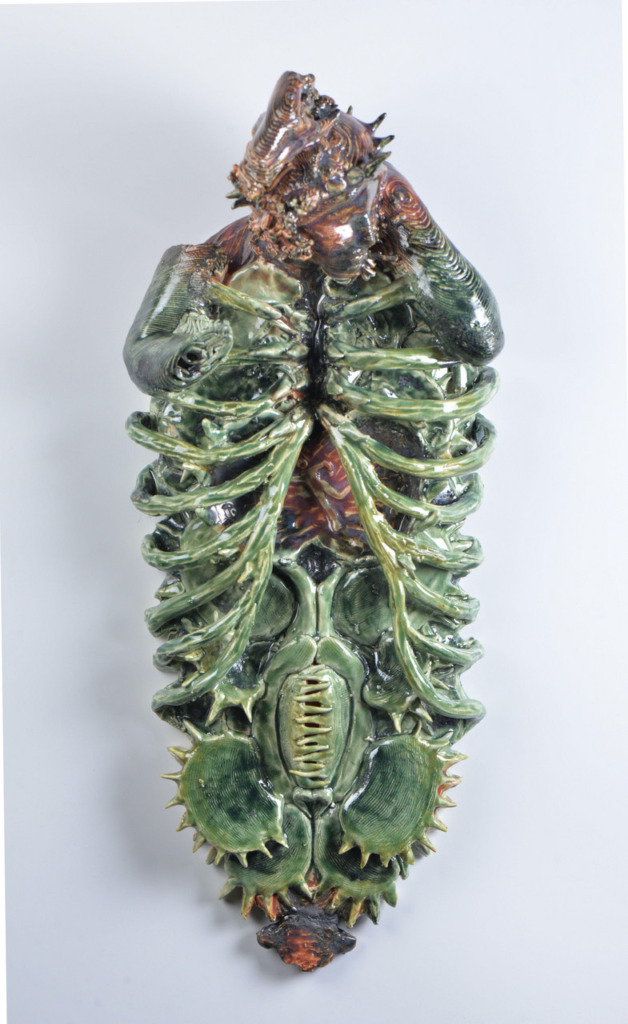
Trinity Squires, Venus, 2024. Stoneware, Glaze. 18″ x 9″ x 5.” The South Carolina Governors School for the Arts and Humanities, SC.
Artist Statement: This project was a combination of hand built and 3-D printed components. The printed model is that of a Venus-like figure, who historically represented the idealized female form and presentation. Within my own work, I wanted to portray a subversion of these ideals, surrounding the figure in Venus flytraps. The plants are equally naturally beautiful as the female form, but are carnivorous, and rely on the death of others to continue prospering beautifully. The plant forms were hand sculpted in a symmetrical pattern mimicking the human organ and skeletal systems with specific attention to referencing female anatomy.
Layla Turner
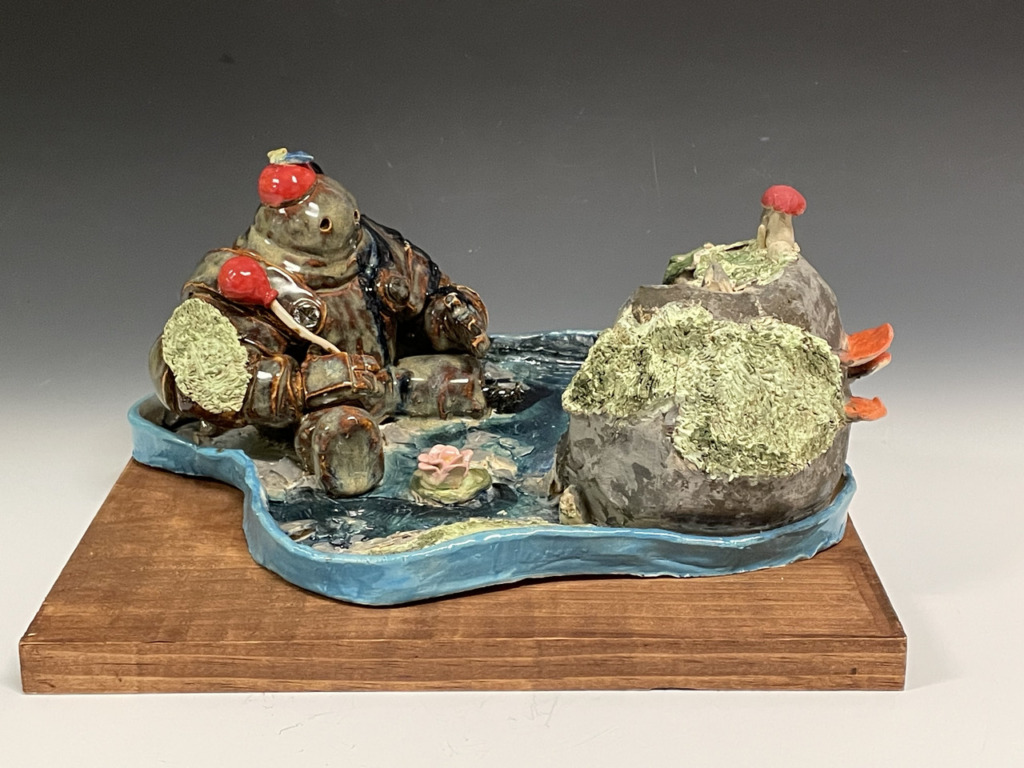
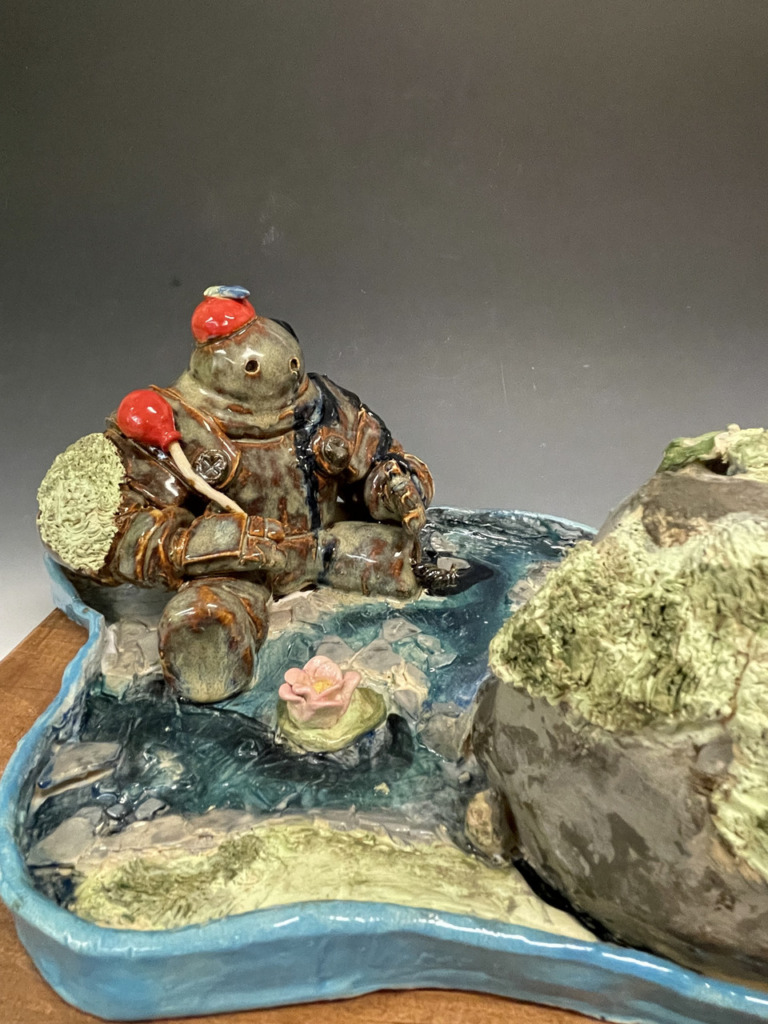
Layla Turner, Tears of the Machine, 2025. Cinco Blanco Stoneware, 12” x 4” x 6.” Cedar Ridge High School, TX.
Artist Statement: The gloomy robots serve as a depiction of life and how the nature and nurture of your environment can alter a person’s life, rusting, and broken pieces are some effects, like mental illness and people’s experiences do in real life. But they also serve as a reminder that life can still be beautiful and have hope regardless of the circumstances of life. I used cinco blanco stoneware, underglaze, Iron lustre overglaze and zinc free clear, as well as resin. I figured the resin would resemble water the most when still, and the glazes worked well to show iron that is rusting and oxidizing. I don’t really like the red clay so I went with blanco. As for the process, I threw the waterfall structure on the wheel and slabbed the base. The actual robot was just a bunch of pinch pots and shapes of clay that I hollowed out. The oil dripping is slip that I dripped down the back. The wires and vines are just a coil twirled, the rocks in the pond I used bone dry slabs and broke them. The moss is mounds of clay that I scratched with a needle tool. I wanted my paintings to come to life, so I chose to make a robot. But I wanted him to have this story that resonates with me and others that may feel isolated. But show that even in a loud, never quiet environment you can feel lonely, depression doesn’t care if you have friends or a loving family. It can happen to anyone, which is why the robot is so important in depicting that it is hypothetically happening to a hunk of metal. I chose to combine a real life issue that I experience and a hypothetical image.
Stella Warren-Page
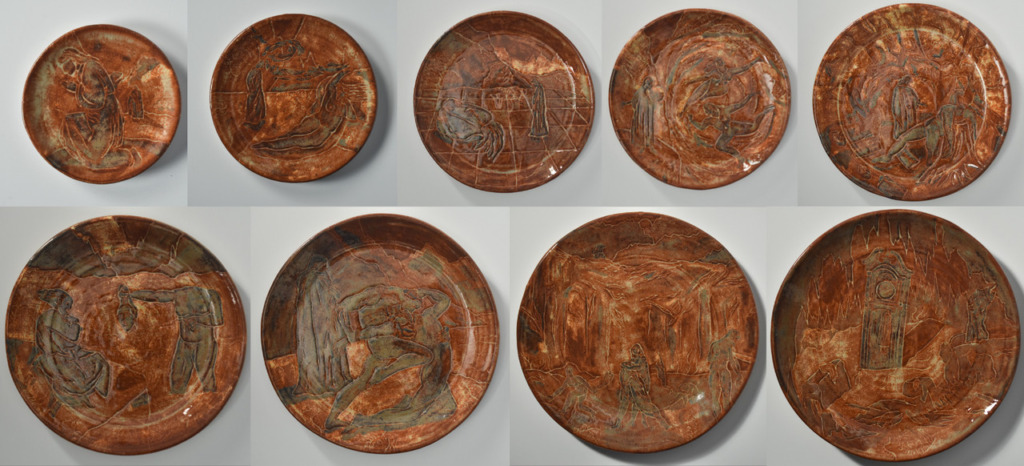
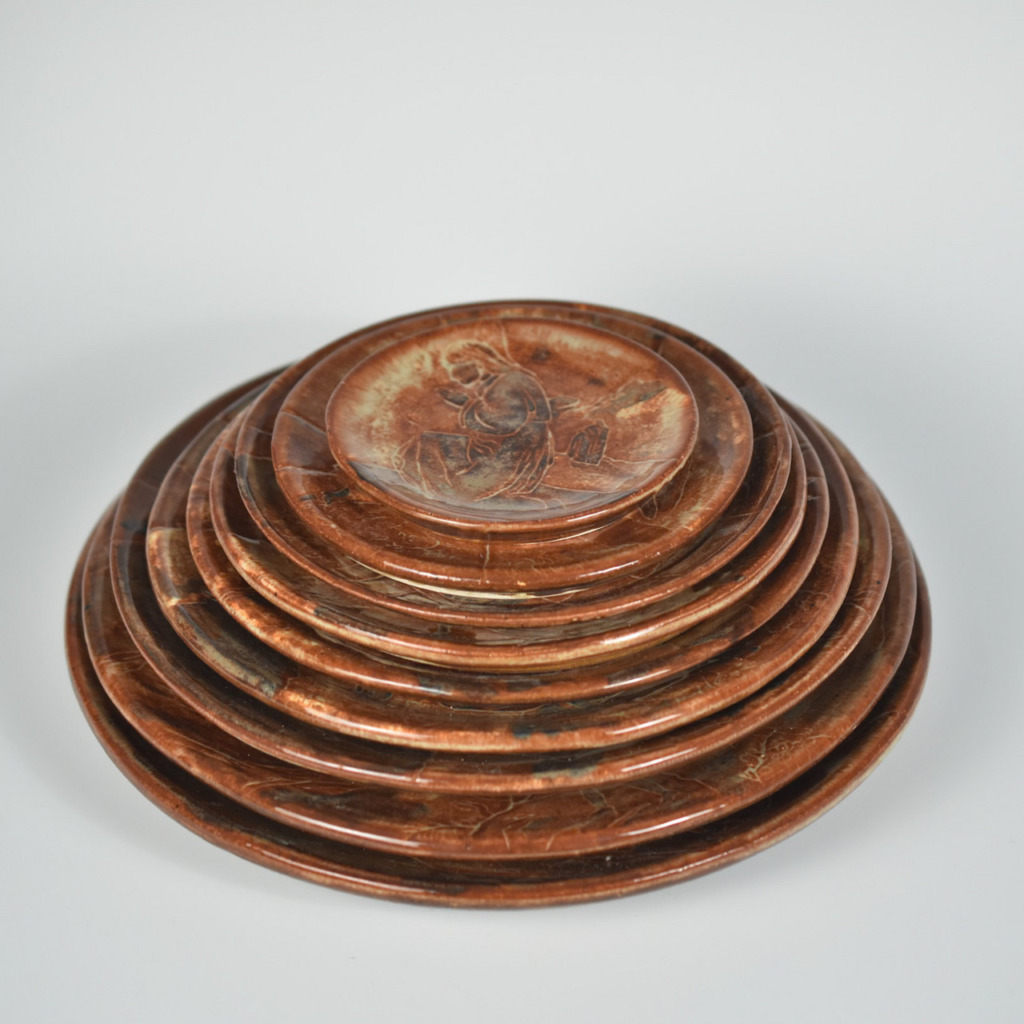
Stella Warren-Page, Stella’s Inferno, 2024. Ceramic, 4” x 4.5” x .5” – 9.75″ x 9.75″ x 1.” South Carolina Governor’s School for the Arts and Humanities, SC.
Artist Statement: Nine thrown plates with Mishima designs correlating with a circle of Hell from Dante’s Inferno, as I have interpreted relating directly to me. I have chosen to represent myself as Dante traveling through the levels encountering myself or family in each level to showcase internal and external struggles in my life. This piece acts as one sculpture, representing the inverted Inferno structure, and nine separate artworks dealing with different issues.
Preliminary ideation, sketches, research, and discussion are how I begin all of my work. A conversation with my roommate about the spiritual afterlife brought to mind The Divine Comedy and the nine levels of the Inferno that divide souls based on how they lived on Earth. After discussion, I interpreted each level based on my experiences and views on sin, creating imagery that reflected those renditions. “For you are dust and from dust you will return” Genesis 3:19. The decision to use clay comes from the pre-existing references to clay throughout the Bible. Deciding to throw functional plates was encouraged by the concept of having to eat one’s sin. Religious ideals like partaking in Communion contrast with this idea. The plates grow larger as the levels descend to construct an inverted Inferno sculpture when stacked. The imagery on each plate consists of reconfigured illustrations of Dante’s Inferno by Gustave Dore, William-Adolphe Bouguereau, and William Blake. For example, the final Circle Nine uses the environment from Dore’s illustrations. The striking imagery has had a lasting effect on me, and collage is a significant part of my work. I used a Mishima technique to translate all the imagery, providing unique line quality. My glaze choice needed to retain the contrast from my sketchbook value studies.
Lindsey Yared
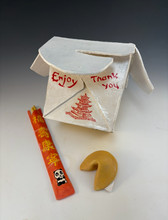
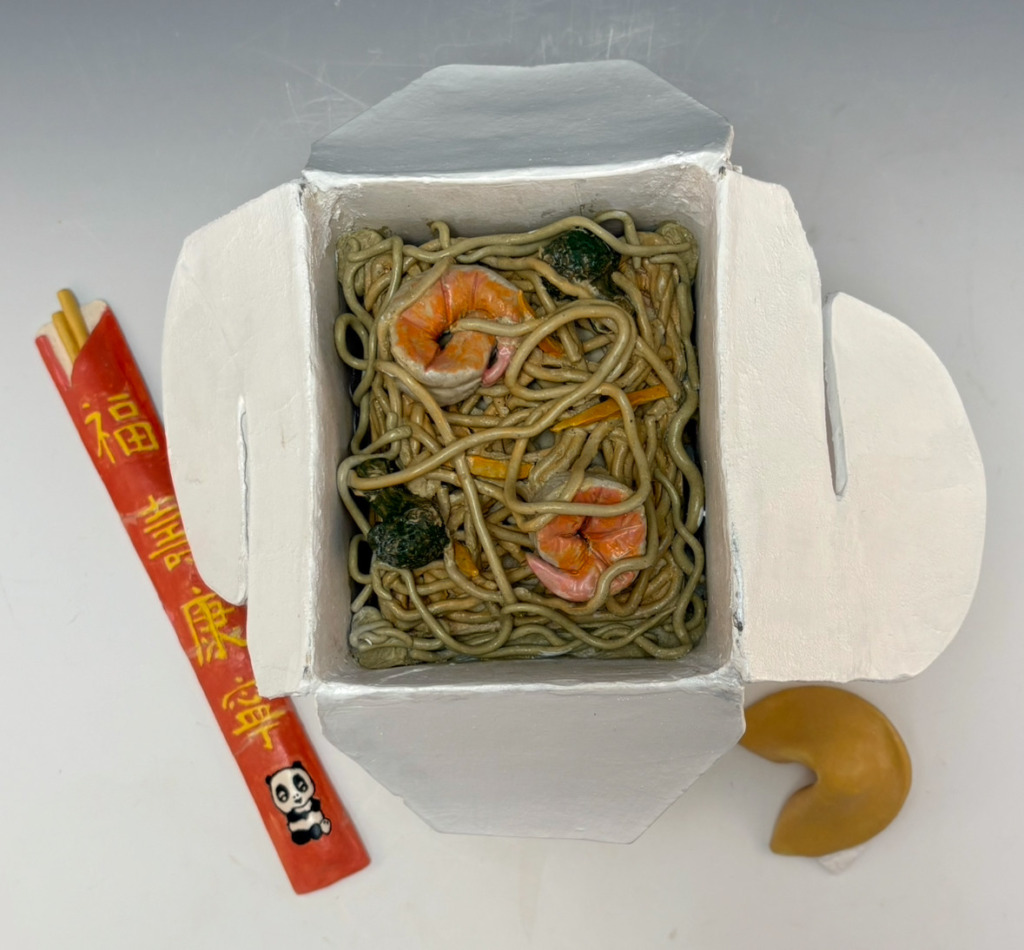
Lindsey Yared, Takeout Box, 2024.Clay, underglaze, epoxy, extruder, 6” x 11” x 10.” Trinity Preparatory School, FL.
Artist Statement: My exploration of art includes this question: how do the human senses represent my culture? This explores how sensory experiences—taste, touch, sight, smell, and sound—connect to my background of Chinese heritage as an American-born. I created symbolic objects, such as a takeout box with chopsticks and a fortune cookie and a Chinese hand fan, to show how culture is perceived through the senses of taste and touch.
Yina Yoon

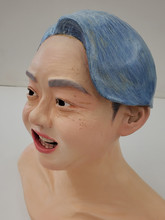
Yina Yoon, Halmeoni, 2025. BMix clay, Acrylic paints, Water, Color pencils, 11” x 12″ x 11.” Dublin High School, CA.
Artist Statement: This is a bust of my grandmother (Halmeoni in Korean). As she is getting older, I can’t help but to just realize that her presence might face from my memory one day. I wanted to capture her in this sculpture to hold onto her, even when words and memories might start to blur.
Bring Some Culture to Your Inbox
399 N Garey Ave Pomona, CA 91767
909.865.3146 | info@amoca.org
The museum is open Fridays, Saturdays, and Sundays, 11 AM–4 PM. Plan your visit by clicking here.
For information about Ceramics Studio hours and availability, please click here for the Ceramics Studio.

